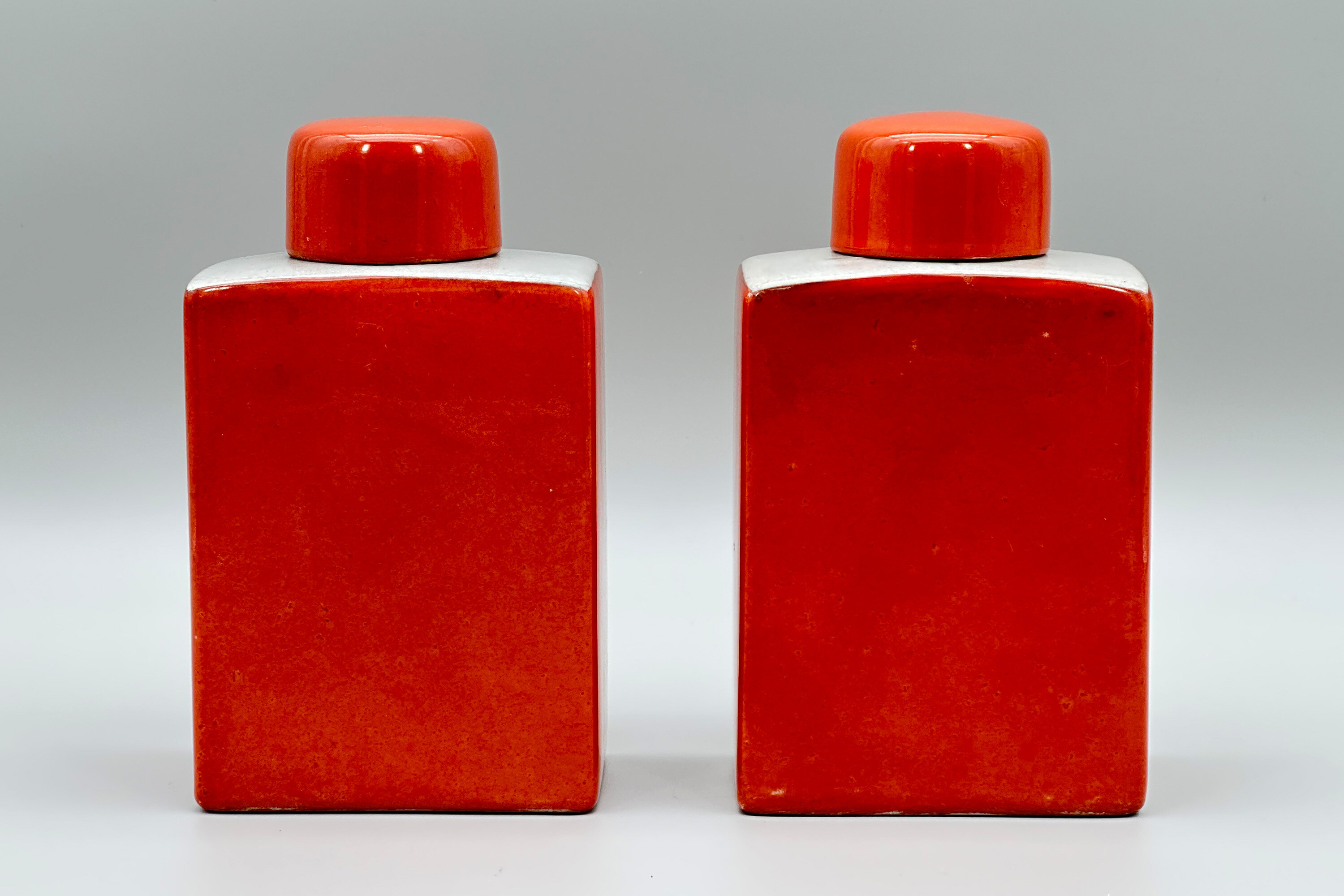
Pair of Orange Glazed Flasks and Covers, Fabienne Jouvin Paris, C20th
Price: £150The French designer Fabienne Jouvin (see image 9) graduated from the superior school of applied arts Duperré in 1985. Since then, she has travelled the world collecting designs for pieces sold and exhibited under her name internationally, with a studio based in Paris. On her website, she writes “From my travels - from Tokyo to The Habana, from the streets of Paris to the sea bed of The Maldives - I bring back sketchbooks, pads of notes, drawings and collages: hispanic or contempory architectures, faces reminding those of Piero Della Francesca, enigmatic objects non identified... These spontaneous sketchbooks give rise to unique pieces and editions painting, textile, porcelain, cloisonné...”. Her first exhibition was in 1989 and in 1996 she began an association with the firm ‘Asiatides’ allowing her to create pieces made in China and Thailand and utilising their designs and techniques.
This pair of flasks, possibly intended as tea caddies, are typical of her ability to give a ‘twist’ to the pieces from which she draws her inspiration. The shape is Chinese from the seventeenth century (see image 10), while the iron red colour is found on Chinese pieces two hundred or more years later. Combining this with a white ‘crackle glaze’, also well known from Chinese ceramics, was Jouvin’s own idea completing the mix of ancient and modern. Marked as from the Asiatides range with the stylised ‘A’, pieces like these are no longer available currently implying that they were probably made early on in her association with the firm and now have a uniqueness of their own.
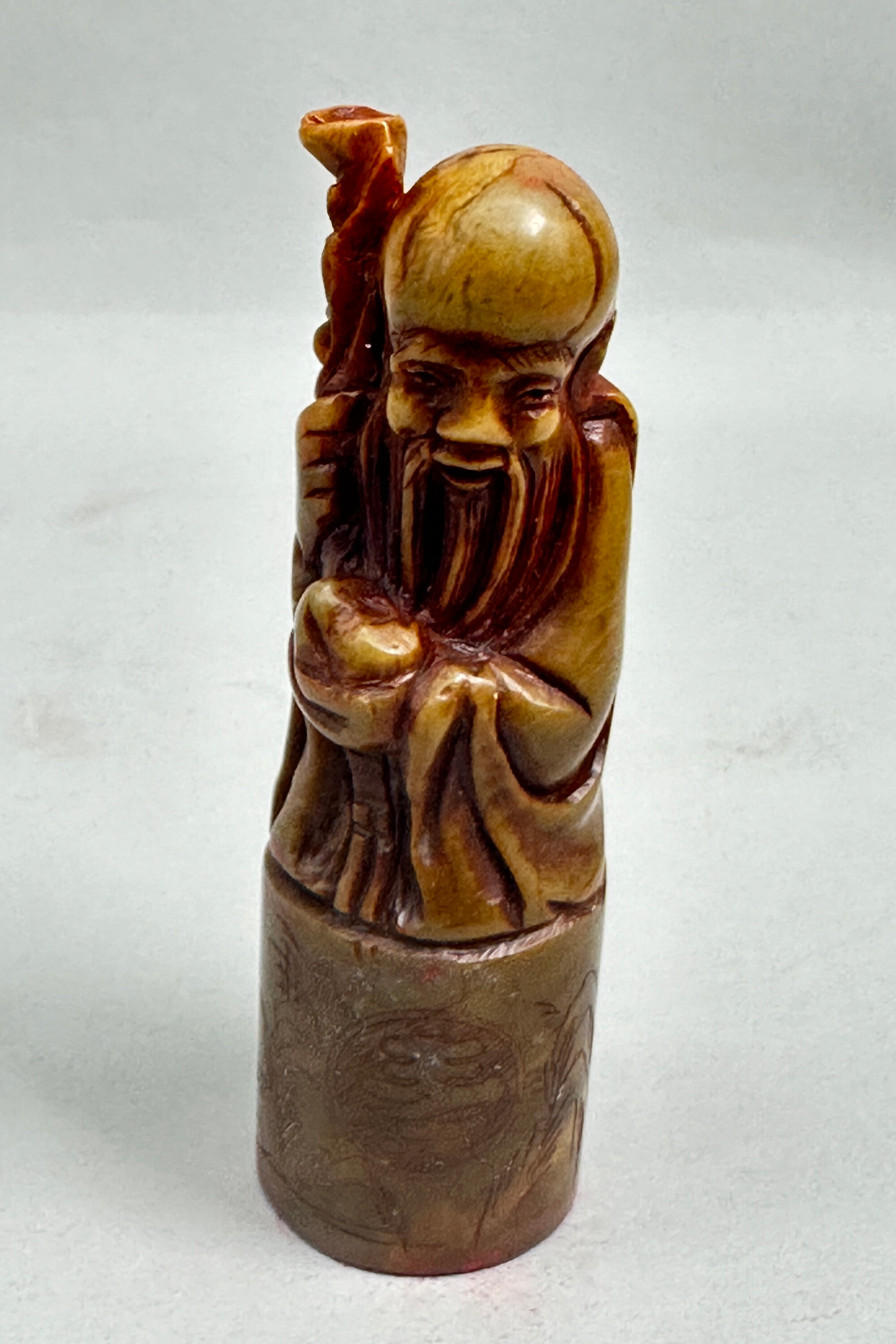
Chinese Soapstone Seal with Shou Lao, C20th
Price: £45
Vintage Carved wood figure of a seated Man, Bali, Indonesia, second half C20th
Price: £75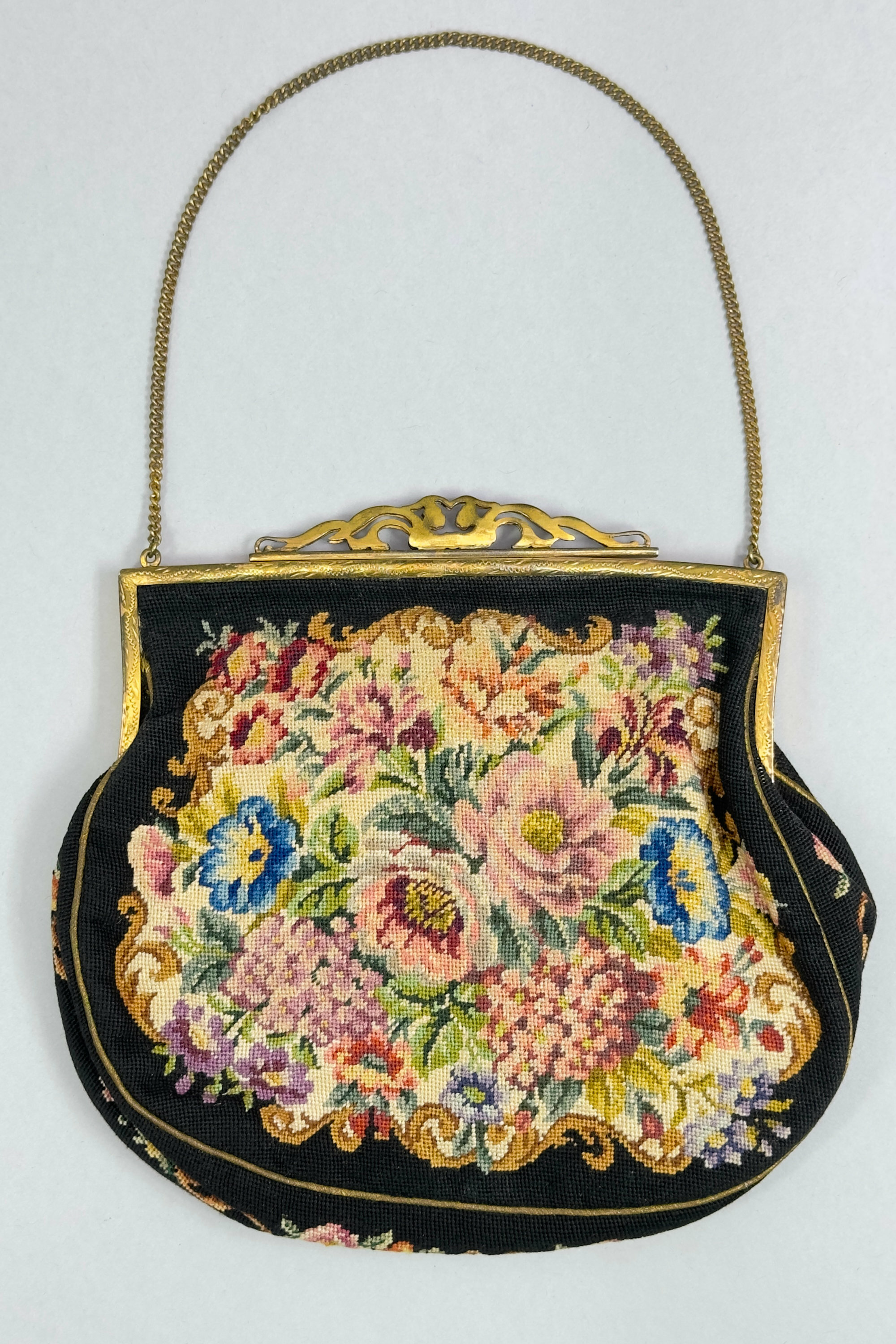
Vintage Petit Point Tapestry Bag, Austria, 1920s
Price: £15
French Art Deco Machine Age galalith paste necklace 1920s
Price: £75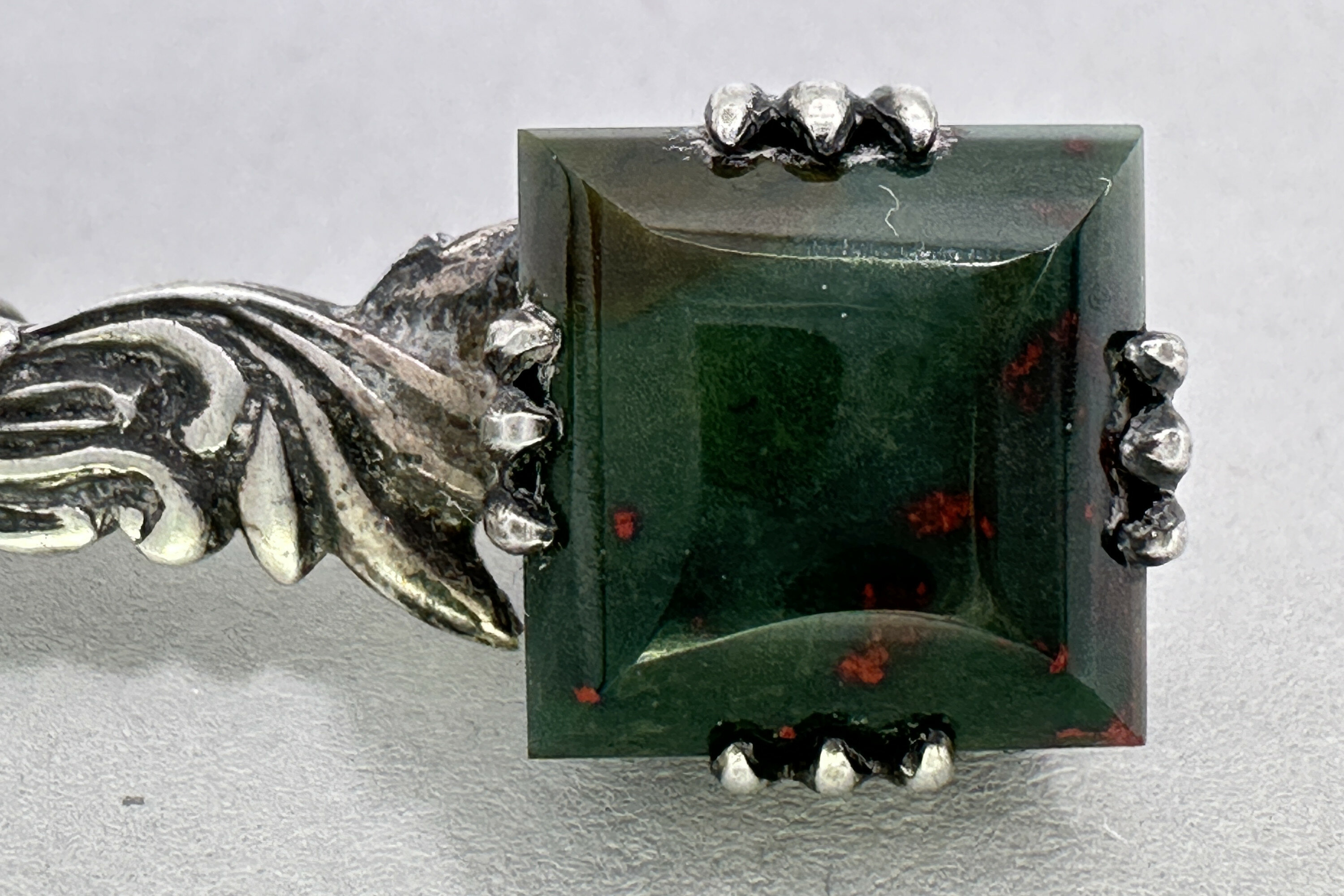
Edwardian Scottish bloodstone bar brooch c1910
Price: £30
Chinese Famille Rose Bowl decorated with ladies, Qianlong mark, Republican period
Price: £45PLEASE NOTE THAT THERE IS FREE UK SHIPPING ON THIS ITEM. For international buyers the shipping cost will be reduced by the UK shipping cost, so don't worry if you are outside the UK, you still receive this benefit!

Small Chinese Bronze Vase of Ku Form with Elephant Head Handles, Qing Dynasty circa 1800
Price: £75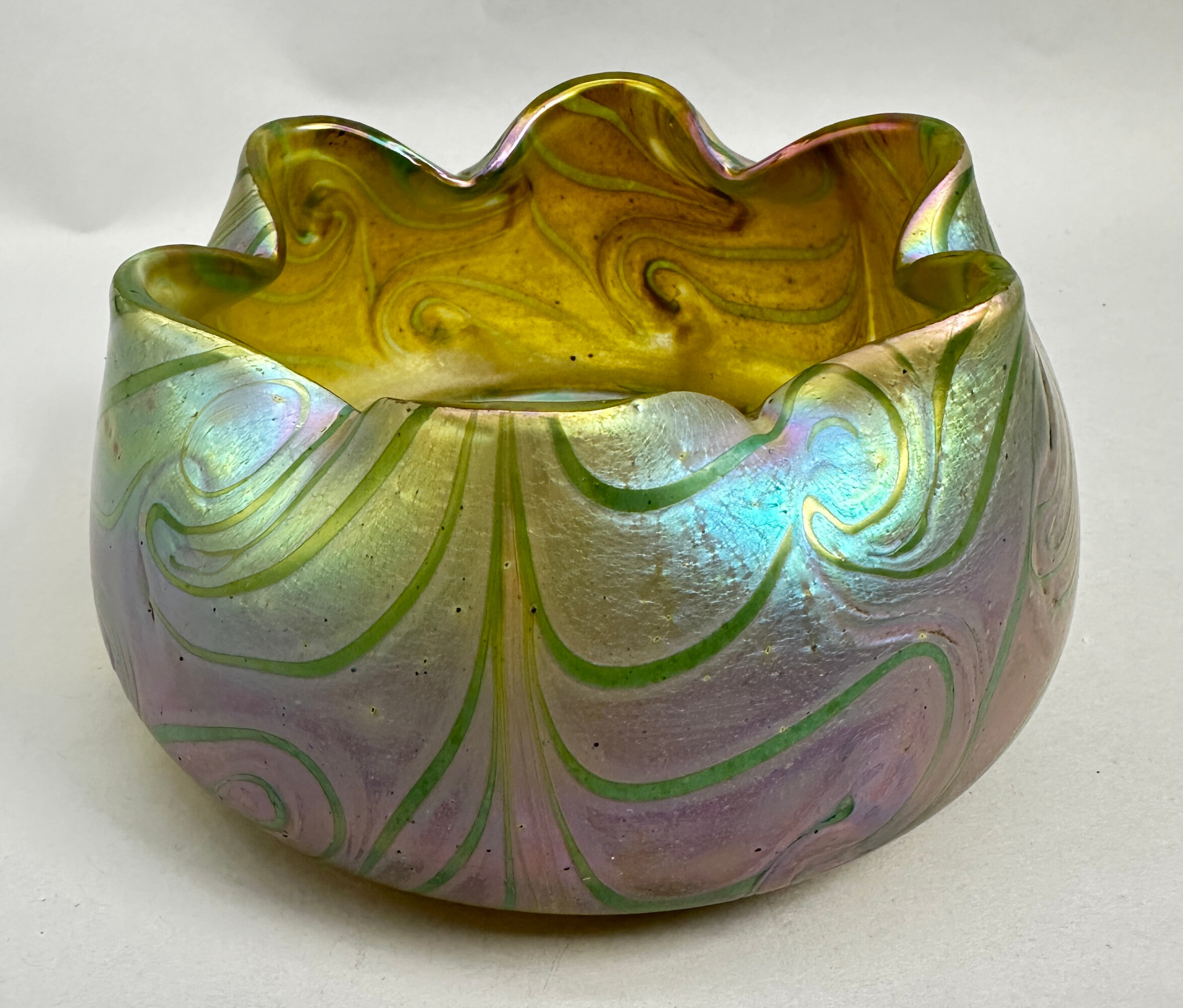
Loetz style glass Bowl, early C20th
Price: £110Most of the original Loetz pieces were not signed and there were many contemporary manufacturers making pieces in a similar style. There are, furthermore, modern reproductions. The attribution ‘Loetz’, is, inevitably, generously and loosely applied but sometimes true certainty is hard to achieve. Much information and assistance can be obtained from the website Loetz.com. On that basis this attractive bowl with its crimped rim and wavy line design on a purple ground is best regarded as Loetz style but probably contemporary with the output of the Loetz factory itself. It has great decorative appeal nevertheless.
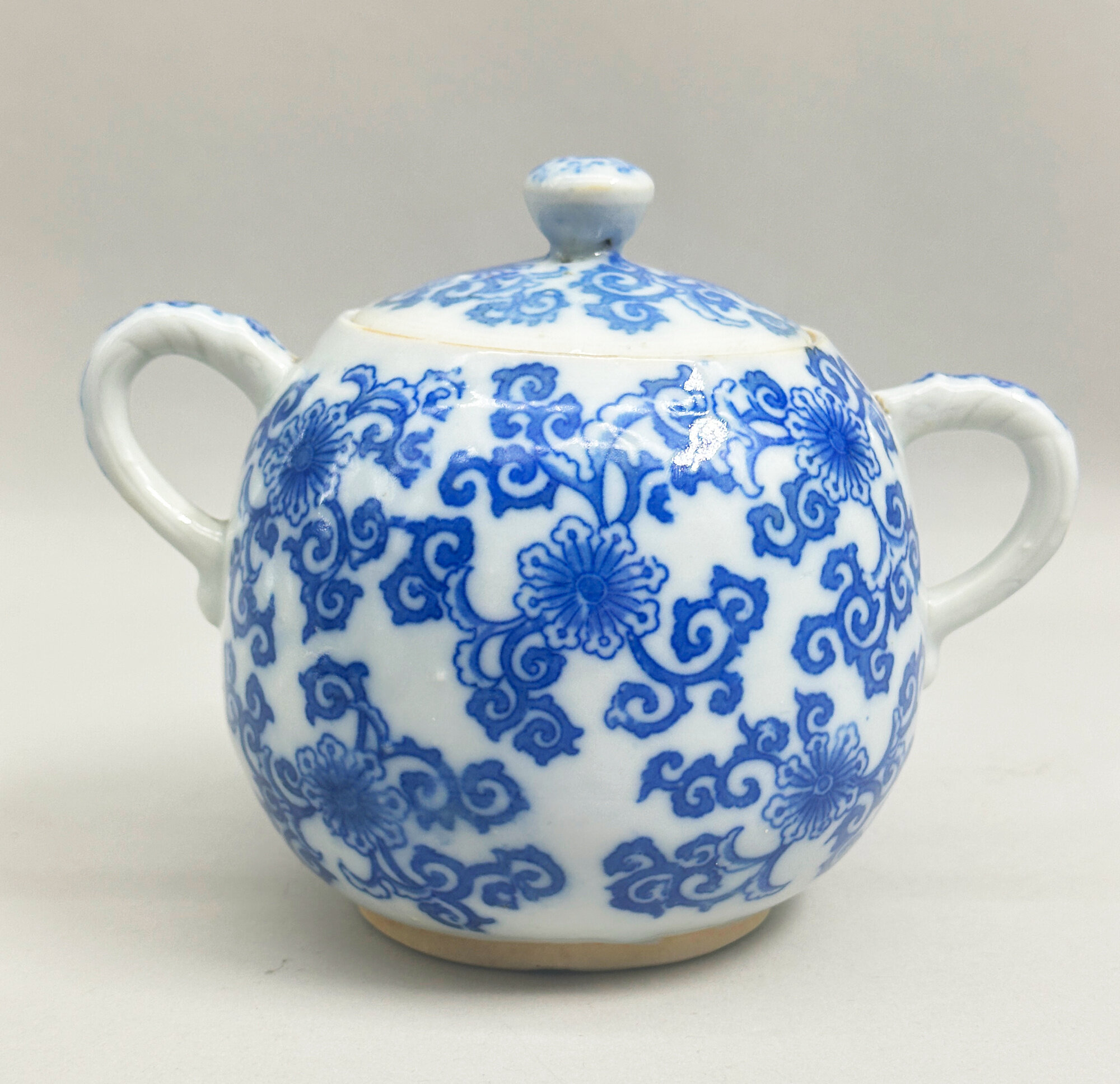
Japanese Blue and White Sugar Bowl and Cover, first half C20th
Price: £25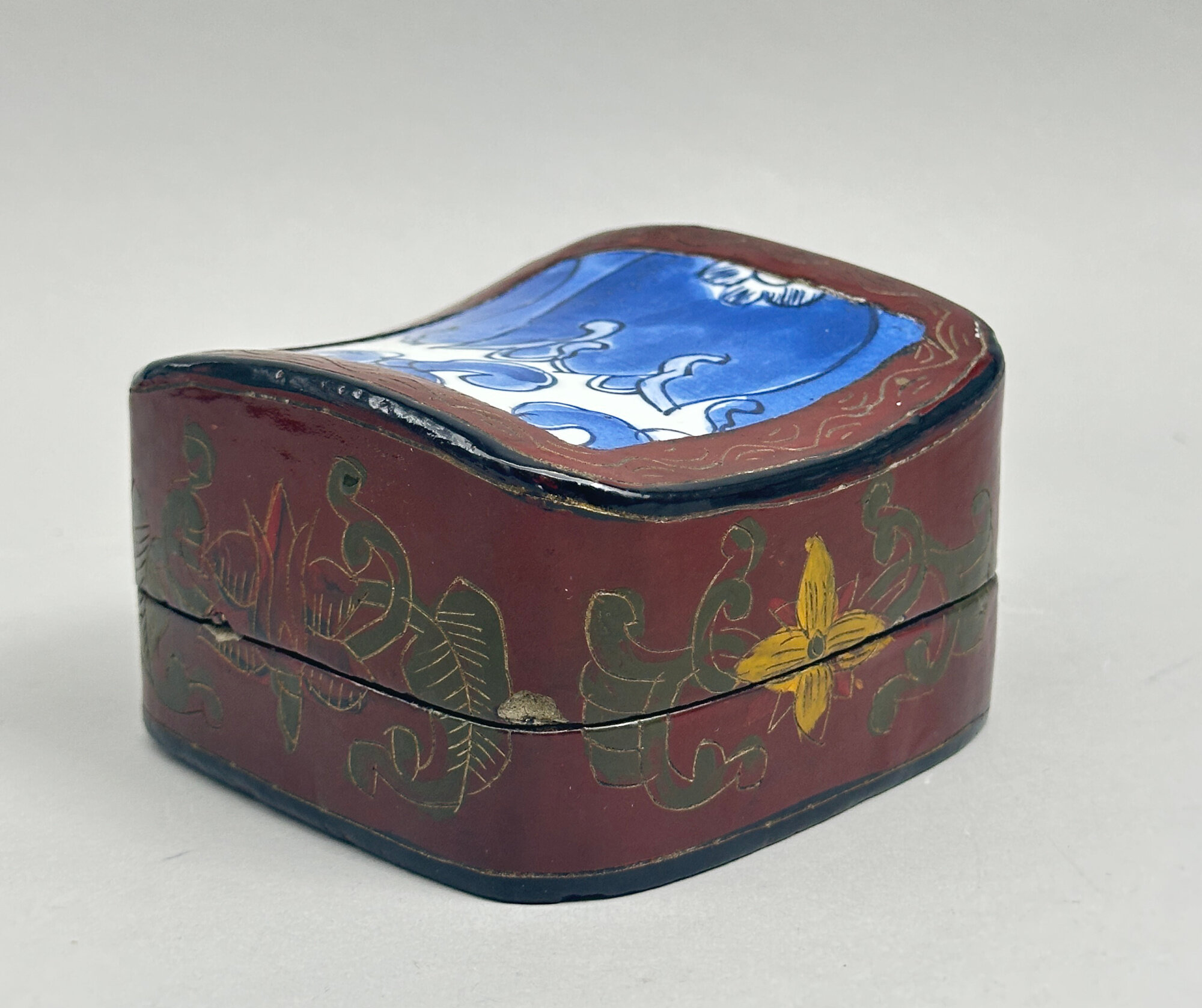
Vintage Lacquer Box with an inset ceramic Shard, probably Persian C20th
Price: £25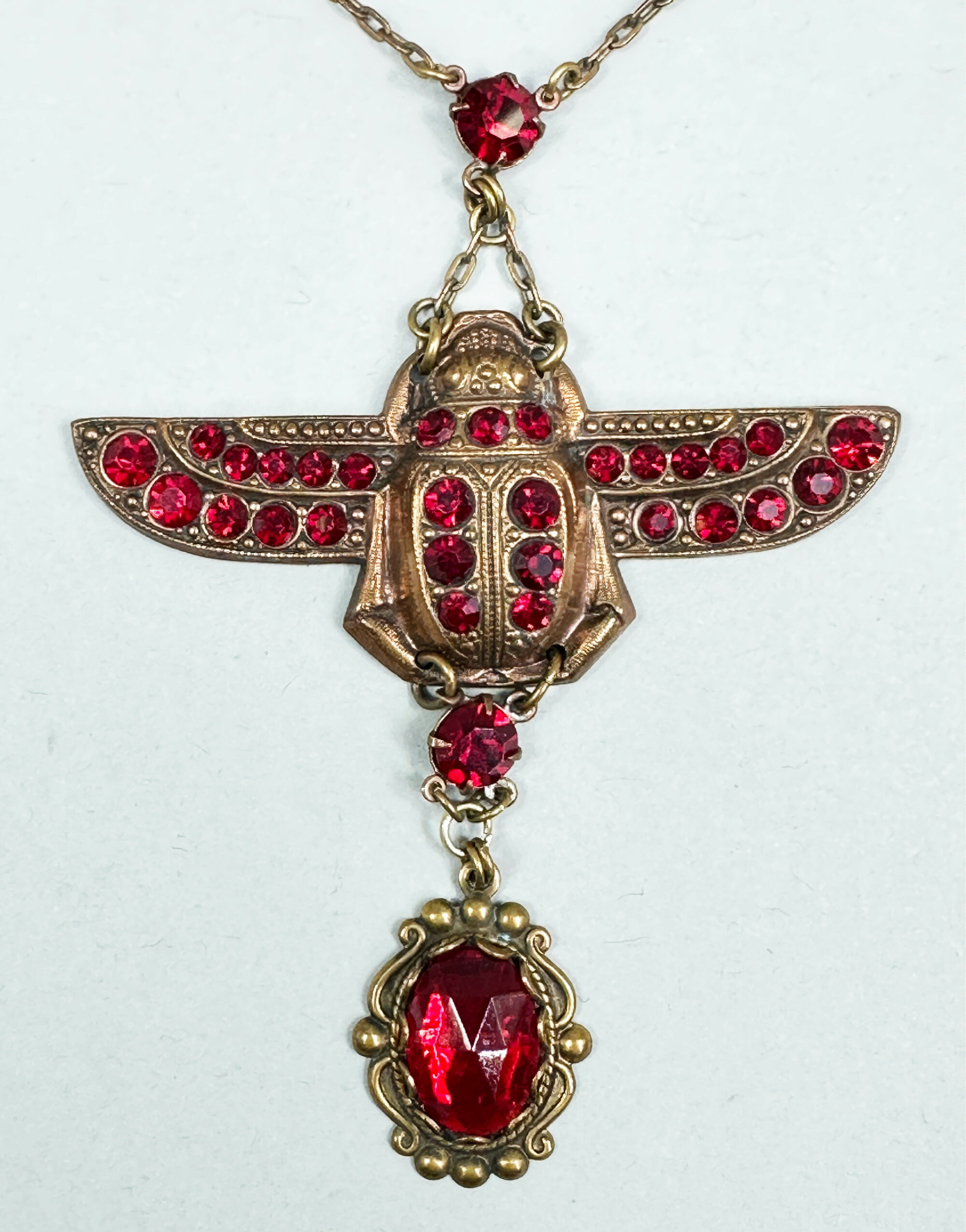
Early Egyptian Revival necklace c1900
Price: £65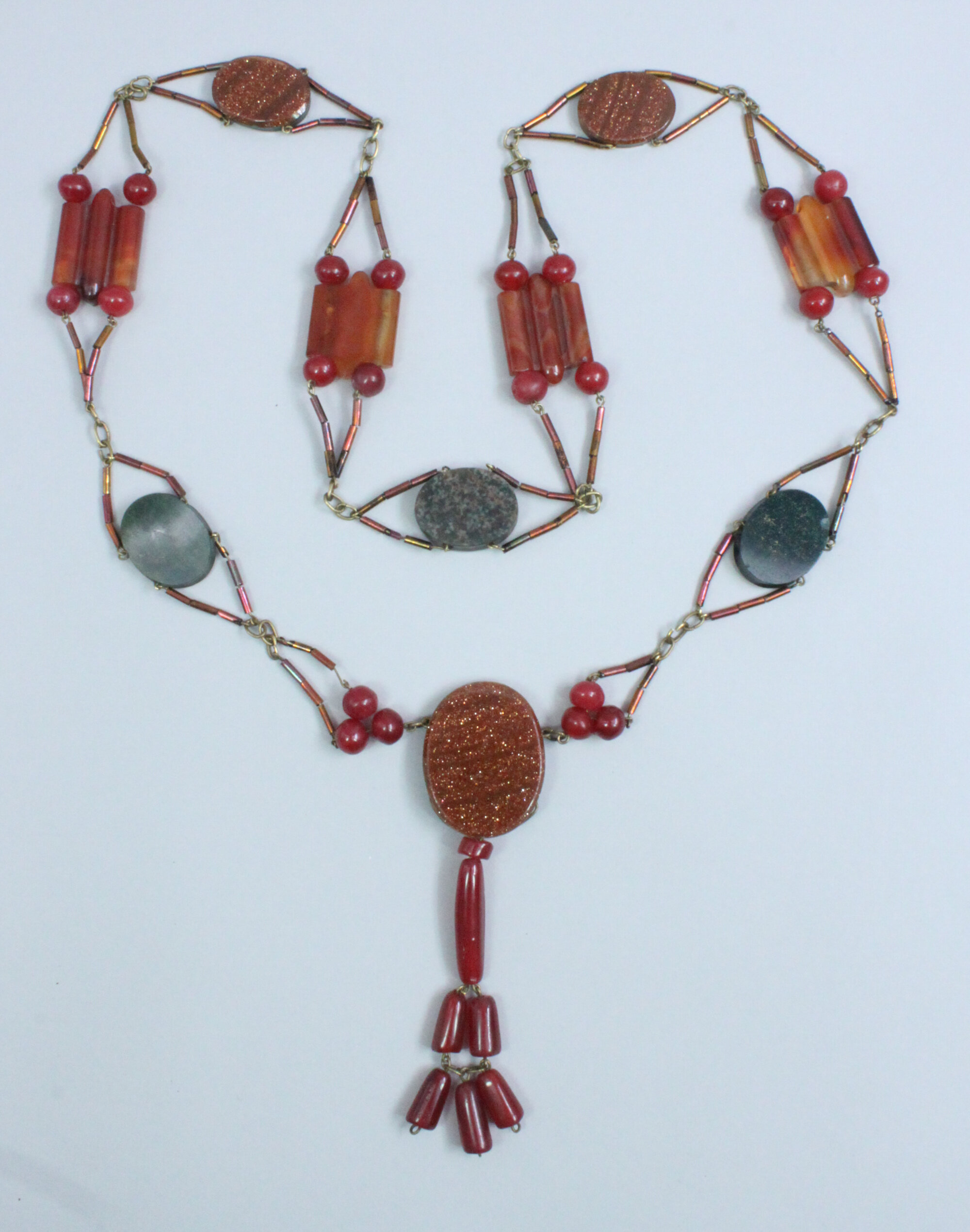
Long Art Deco carnelian, bloodstone and goldstone necklace 1930s
Price: £95Goldstone is a type of glittering glass made in a low-oxygen reducing atmosphere. The finished product can take a smooth polish and be carved into beads, figurines, or other artifacts suitable for semiprecious stone, and in fact goldstone is often mistaken for or misrepresented as a natural material. It was first made in the 17th century in Italy. (Credit: Wikipedia)
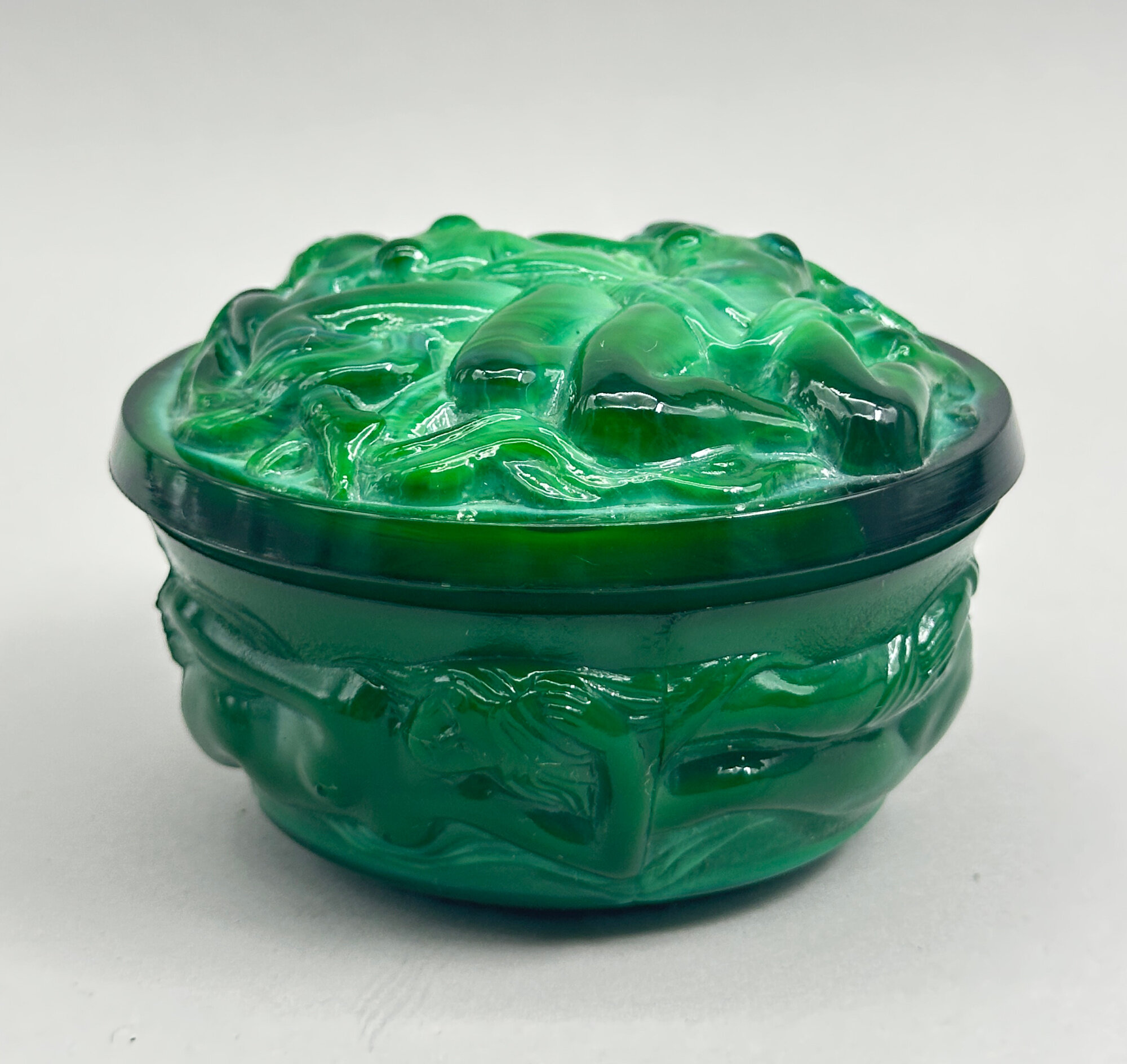
Art Deco Style Malachite Glass Box and Cover, Hoffmann & Schlevogt, C20th
Price: £55Heinrich Hoffmann (1875 – 1939) and Henry Schlevogt (1904 – 1984) were relatives as well as business partners, Schlevogt having married Hoffman’s daughter. They worked together on a variety of designs and from the moulds they produced came pieces exclusively pressed by the family glassworks of Josef Riedel established in Polaun (Polubný), Bohemia. The collection was marketed under the brand name ‘Ingrid’ and had an immediate success in Europe and the United States, being introduced at the Spring Trade Fair in Leipzig in 1934 and later in the same year presented at the Chicago World’s Fair. Hoffmann died around the time of the beginning of the second world war but Schlevogt remained in Bohemia until his capture by the invading Red Army in 1944. Eventually rescued through the intervention of influential friends, he settled in Paris and in the 1950s founded a highly successful wholesale business trading in crystals and glassware which he sold in 1972. The Czechoslovak government meanwhile nationalised the glass industry after World War II and some of Schlevogt’s moulds were reused with pressings known from the 1970s made as before at the glassworks of Josef Riedel.
Dating of the pieces is extremely difficult since the later versions resemble the earlier ones so closely and there are few firm guidelines. But the example here, even if there is the possibility that it does not date to the 1930s, is an extremely accurate reflection of the model types produced. The design is striking with the malachite effect glass formed into a two section box the deep base fitted with a shallow domed lid and both parts decorated with naked ladies swimming amidst waves in a swirling design of life and movement. The joins of the moulds can be clearly seen at the sides (see images 8 & 9). The style is quintessentially Art Deco and this is a ‘must have’ for collectors of pieces from that era.

Massive Victorian Carnelian Cameo Shell
Price: £55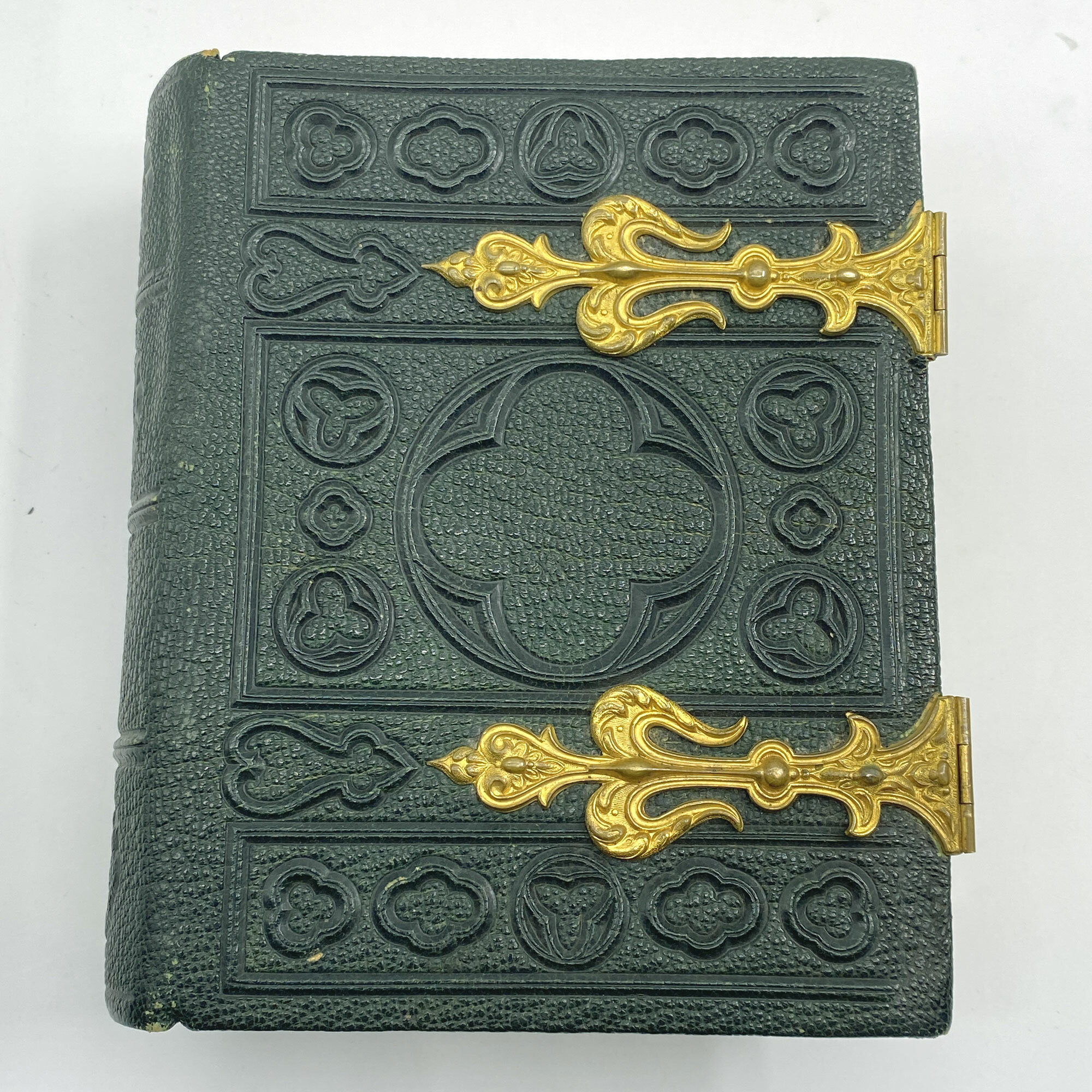
Victorian leather bound photo album made by Mechi and Bazin c.1870
Price: £110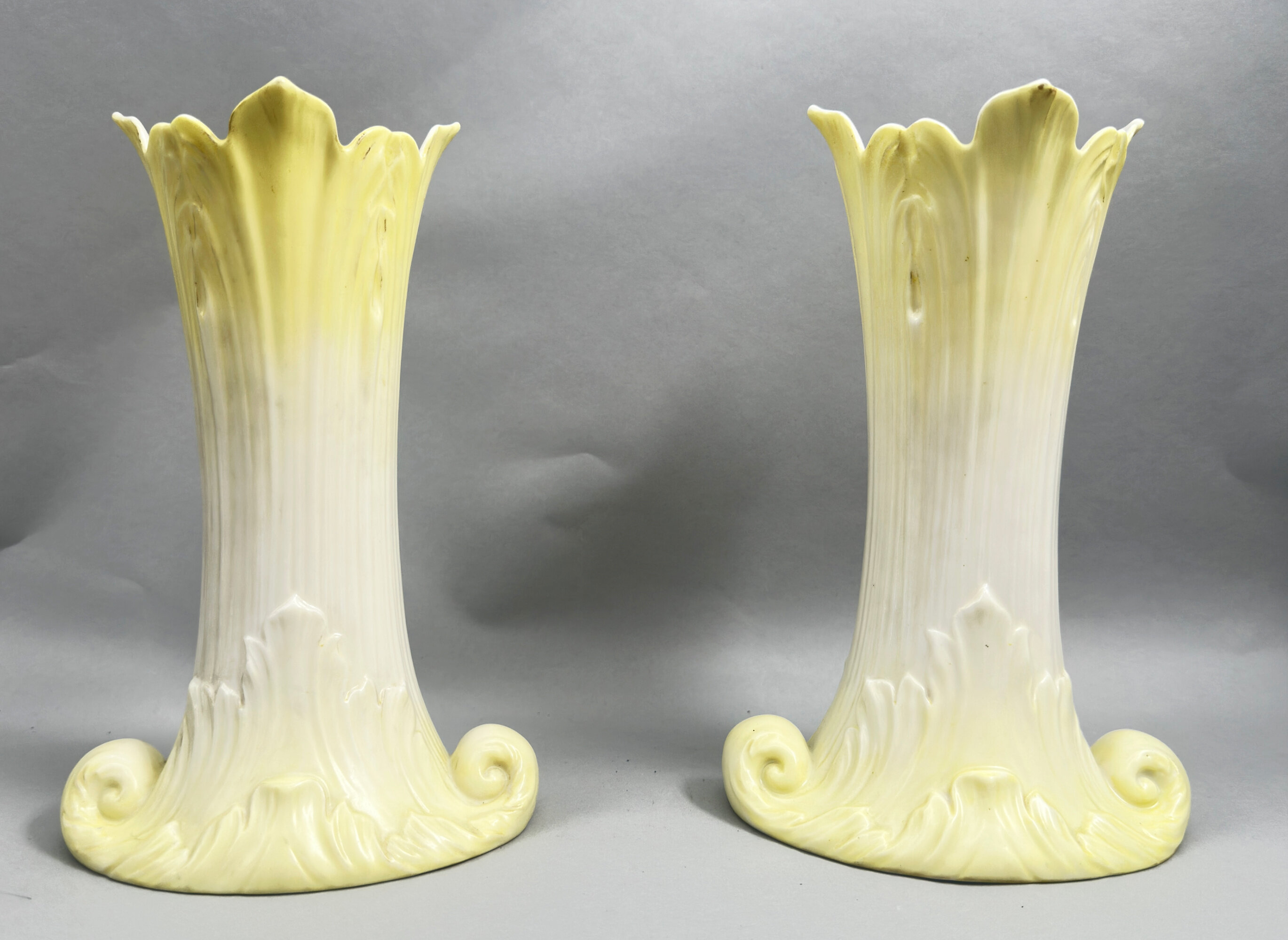
Pair of Royal Worcester Grainger and Co Vases, date mark for 1902
Price: £150The influence of the Art Nouveau movement, with its emphasis on organic and plant forms, is clearly seen here. The vases date to the early 1900s and were made by the ‘Grainger and Co’ branch of the celebrated Royal Worcester factory. The first porcelain factory at Worcester was set up in 1751 by John Wall (a doctor) and William Davis (an apothecary), along with 14 other businessmen. Fifty years later in 1801 Thomas Grainger (1783–1839) started a rival company ‘Grainger’s Worcester Porcelain’ and during the nineteenth century both companies traded successfully. However following the death of George Grainger, the son of Thomas Grainger, in 1889 the Grainger factory was sold to Royal Worcester who continued manufacture on its old rival firm’s St.Martin’s Gate site until finally closing the works in 1902. Ivory style porcelains were one of the specialities of this brief manufacturing period and the date mark ‘L’ which appears on these vases is for the year 1902, just before the two concerns were completely merged.
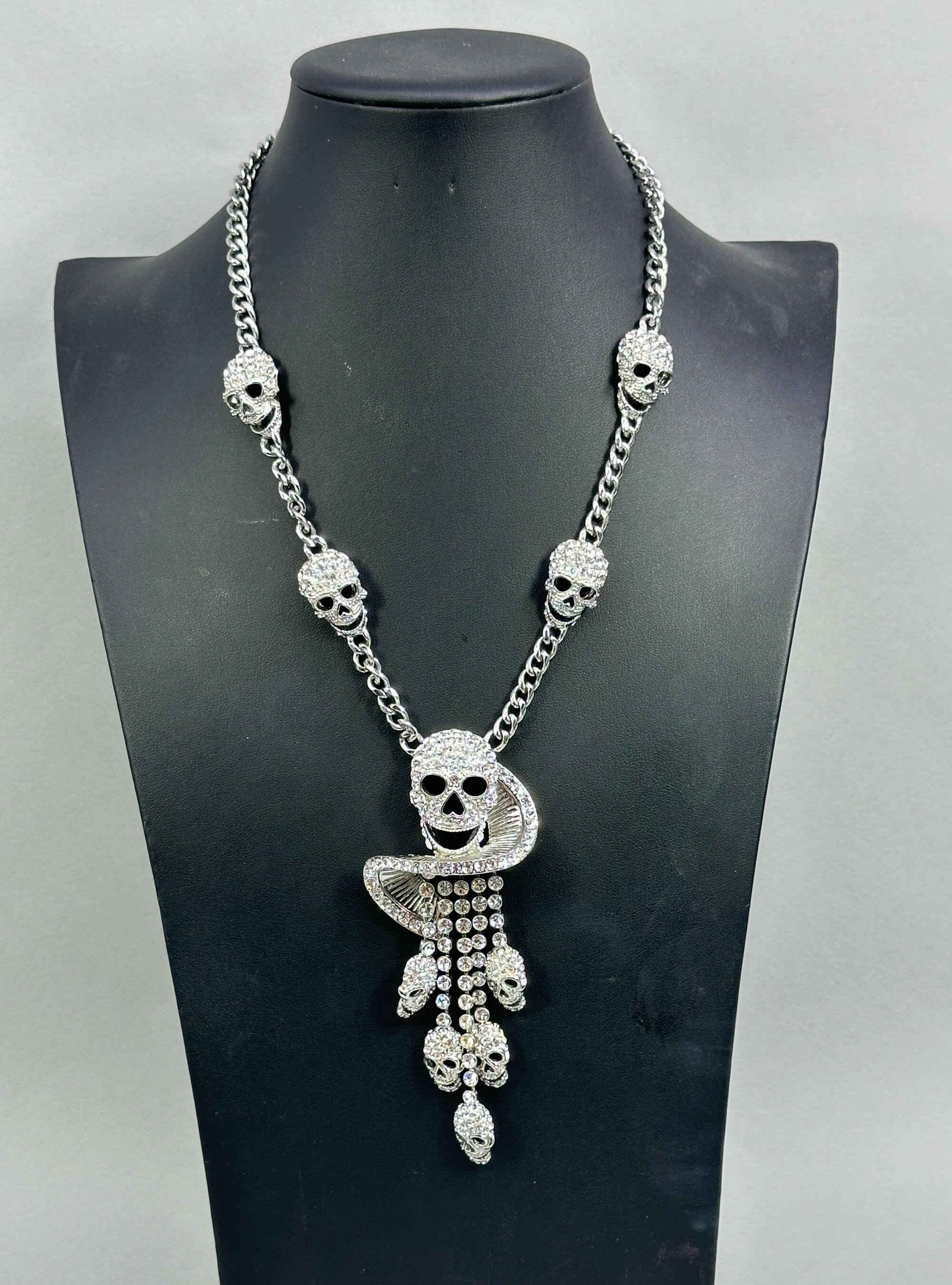
Butler and Wilson Skull Necklace, boxed, modern
Price: £125
Glossy brown crocodile handbag 1960s
Price: £65
Japanese Kutani Vase of Water Dropper form, circa 1880
Price: £45Kutani (the word means 'nine valleys') porcelain was made at various factories in the former Kaga province of Japan. The earliest pieces were in a completely different style employing a palette of colours emphasising green, the so called 'Ko Kutani'. Production of this ceased around 1730, and manufacturing was not revived until the early nineteenth century when the more familiar colourings of iron red and gold were introduced. This small vase is typical of pieces exported to the West in fairly large quantities at the end of the nineteenth century. The form suggests a water dropper and is found in Imari colourings as well. Many of the Kutani pieces were marked, sometimes simply 'Ku' 'Tani' as here. The glaze was sometimes unstable with a tendency to craze as can be seen here, but this is original to the manufacture and does not detract from the piece's decorative appeal.

Two Burmese Textiles, mid C20th
Price: £55The distinctive style of embroidery and applied work here is typical of Burmese work known as ‘Kalaga’ which means ‘curtain’ in Burmese and is used to refer to heavily embroidered appliqué tapestry sewn with a technique called ‘shwe gyi do’. First produced around 150 years ago, Kalagas are generally linen, silk, cotton or velvet background fabrics embellished with sequins, embroidery, beads, coloured stones, tiny pearls, coral, braids and metal threads, the choice of materials depending in part on the client’s budget. Cotton padding was used to produce the ‘3D’ effect seen here and on many other examples of the work. The elaborate decoration meant that some of the larger pieces could take many months to produce. These two panels are an excellent example of the genre with the lavish use of gold thread. They have survived in excellent condition and can decorate an interior today in the same way that they graced the interiors of the makers’ contemporaries. Dating is difficult and a mid C20th attribution is probably sensible but an earlier period of manufacture is quite possible.
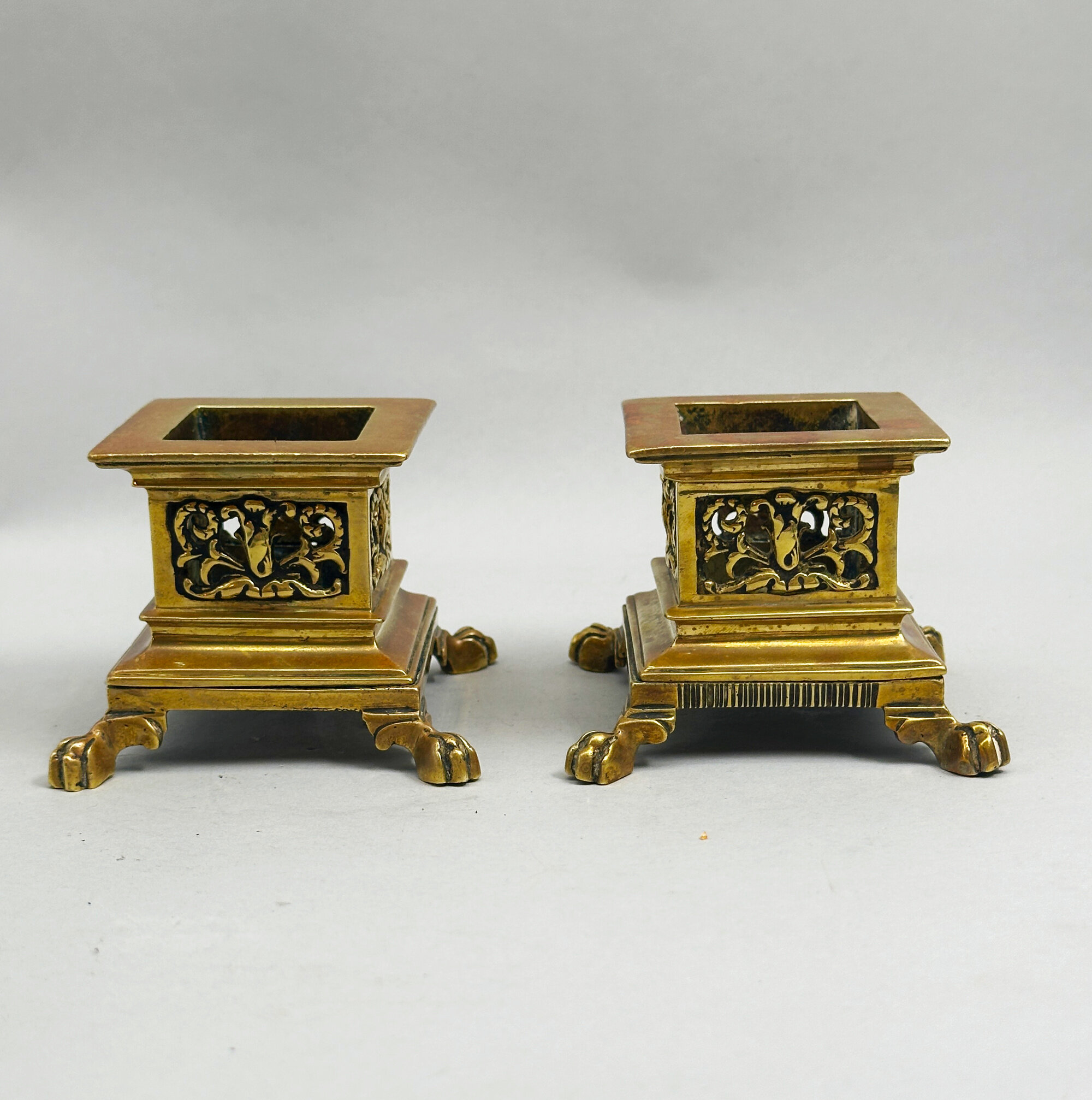
Pair of Georgian Style Square Gilt Bronze Table Salts, English C19th
Price: £45
Jakob Bengal Art Deco galalith and metal necklace
Price: £45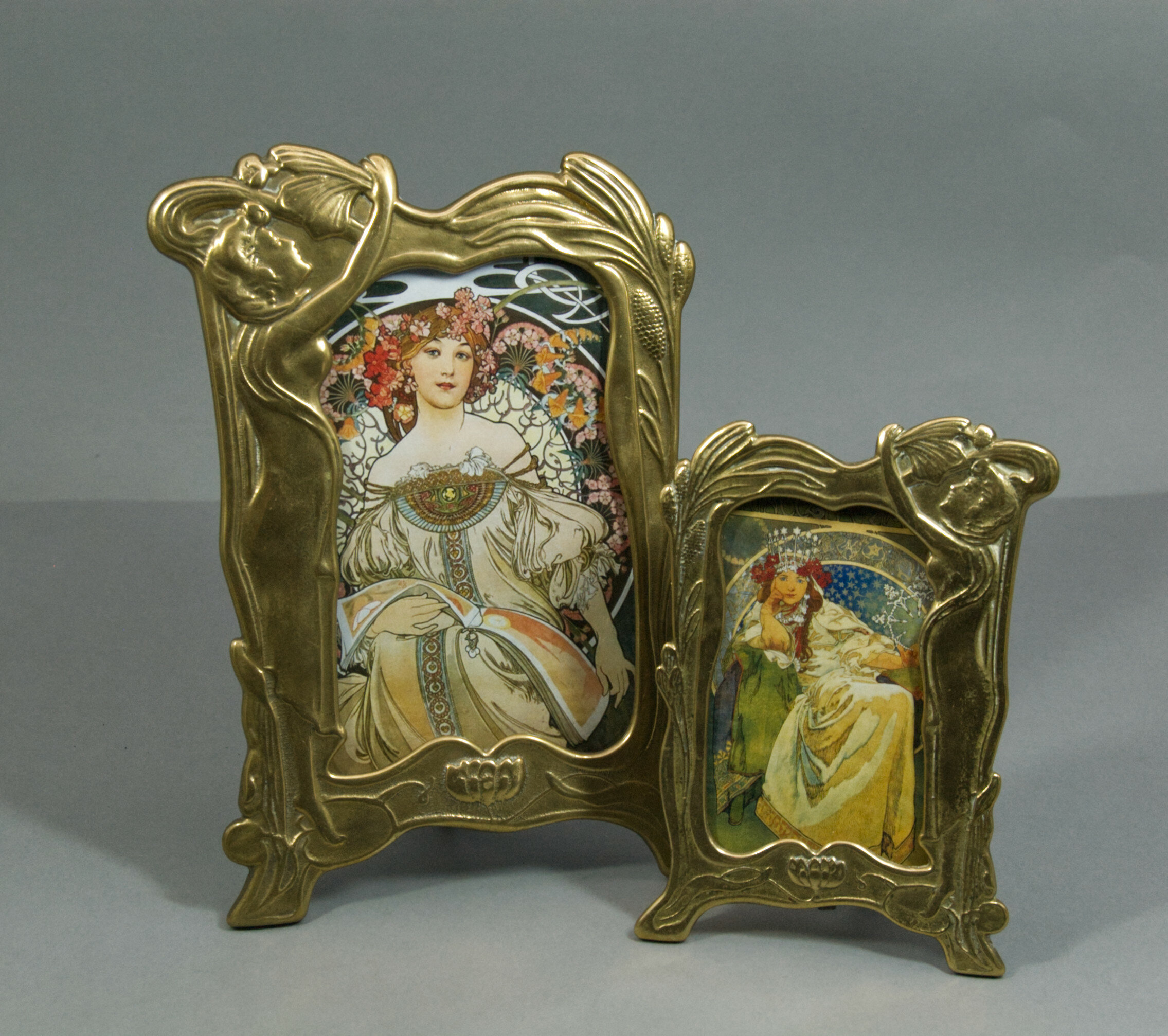
A Complementary Pair of Gilt Metal Art Nouveau style picture frames, 20th Century
Price: £45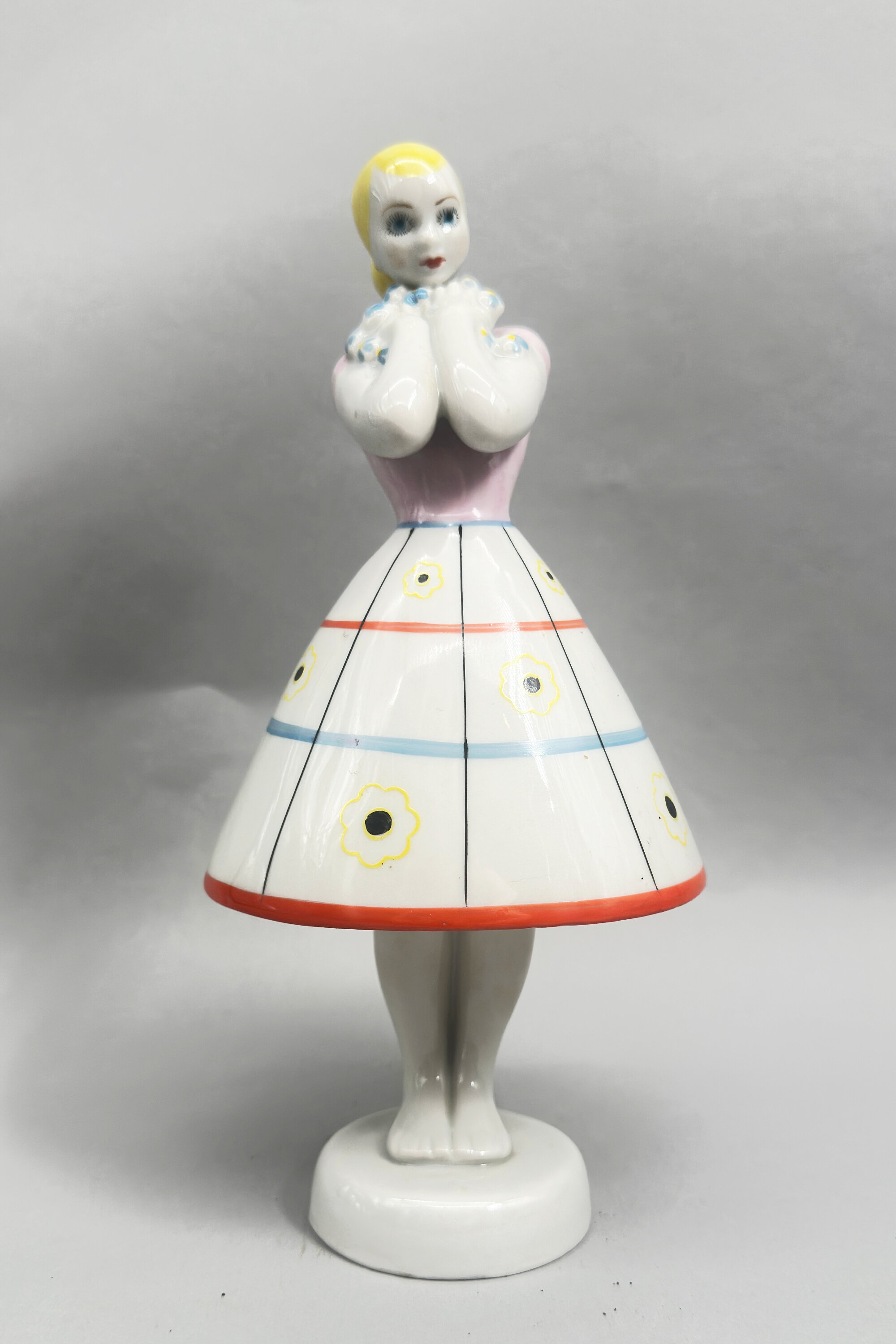
Figurine of a girl, Baranivka Ukraine, 1950s
Price: £55The Baranivka Porcelain Factory, one of Ukraine's oldest porcelain manufacturers, was founded in 1802-1804 by Mykhailo Mezer. Situated at Baranivka, at the time in Poland but now part of Ukraine, the factory was considerably assisted in its development by the discovery of rich clay deposits in the area. Production was continuous even during the Soviet era until the early twenty first century. Both the angular modelling and the abstract decoration of this piece point to a dating in the 1950s when production would have revived after the second world war and more contemporary styles adopted.
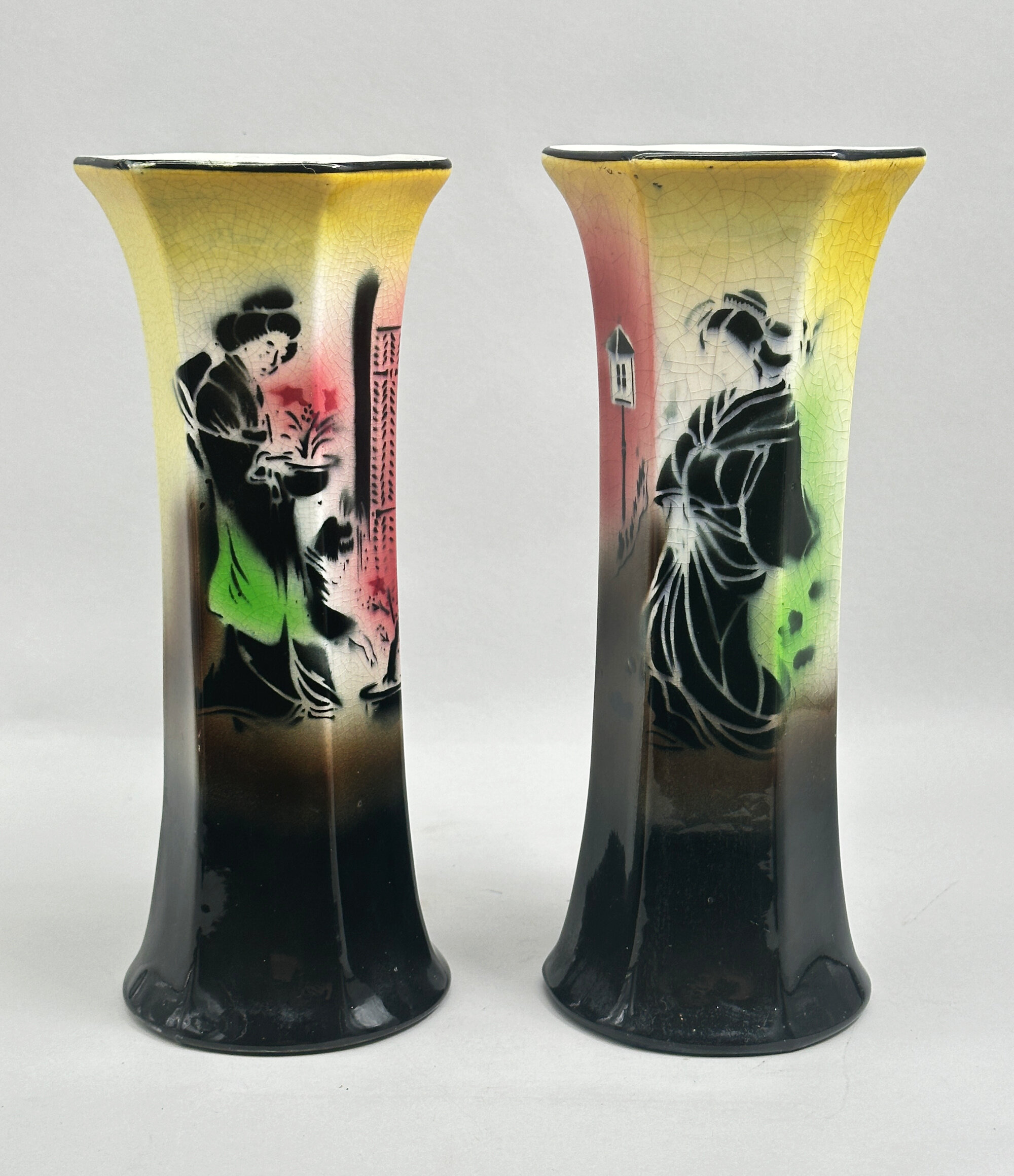
An unusual pair of Art Deco style Japonaiserie ceramic vases, probably French 1920s/1930s
Price: £75
Outstanding Suede Lanvin Clutch in original box 1950s
Price: £250
Doulton Vase with geometric and floral designs, late 1920s
Price: £75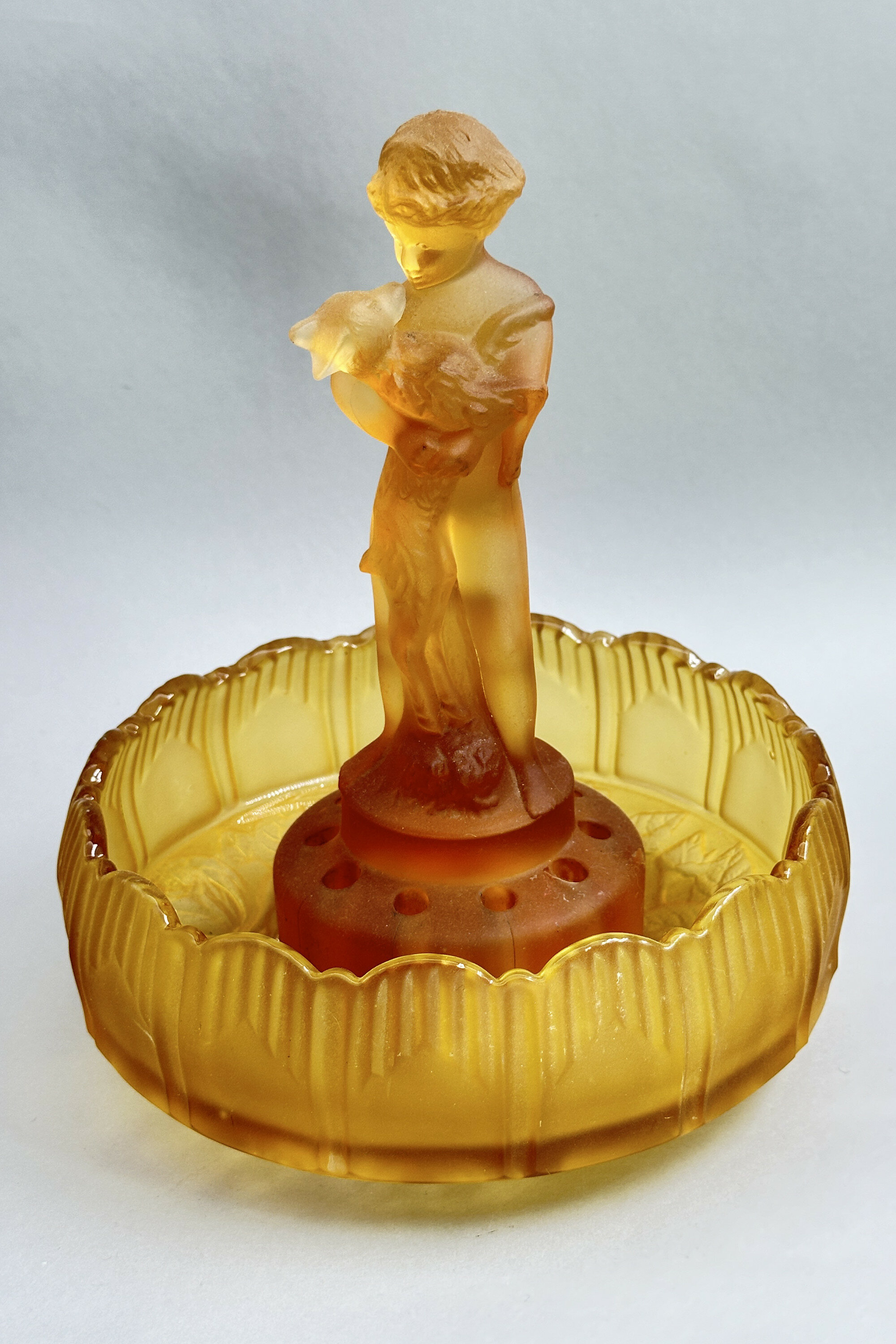
Sowerby Amber Glass Centrepiece circa 1930
Price: £75The Sowerby family came from the North West of England near Carlisle and settled in Gateshead in the late eighteenth century. The firm Sowerby Glassworks is known from 1807 onwards and continued production until 1972, concentrating on pressed glass. Catalogues of their wares still exist and they produced pieces in a wide variety of styles and shapes which retain their popularity today.
The centrpiece figurine, which was intended as a flower holder or ‘frog’, is rather unusual; normally the figures are female but the style of the modelling is identical. Similar designs to the bowl can be found in a 1936 catalogue but versions of it even appear in another catalogue from 1882. Many centrepiece/bowl combinations are found and some of them are not always original. This may possibly be the case here but if so the ‘match’ is extremely pleasing to the eye and the two elements set one another off perfectly to produce a striking example of Art Deco decorative design.
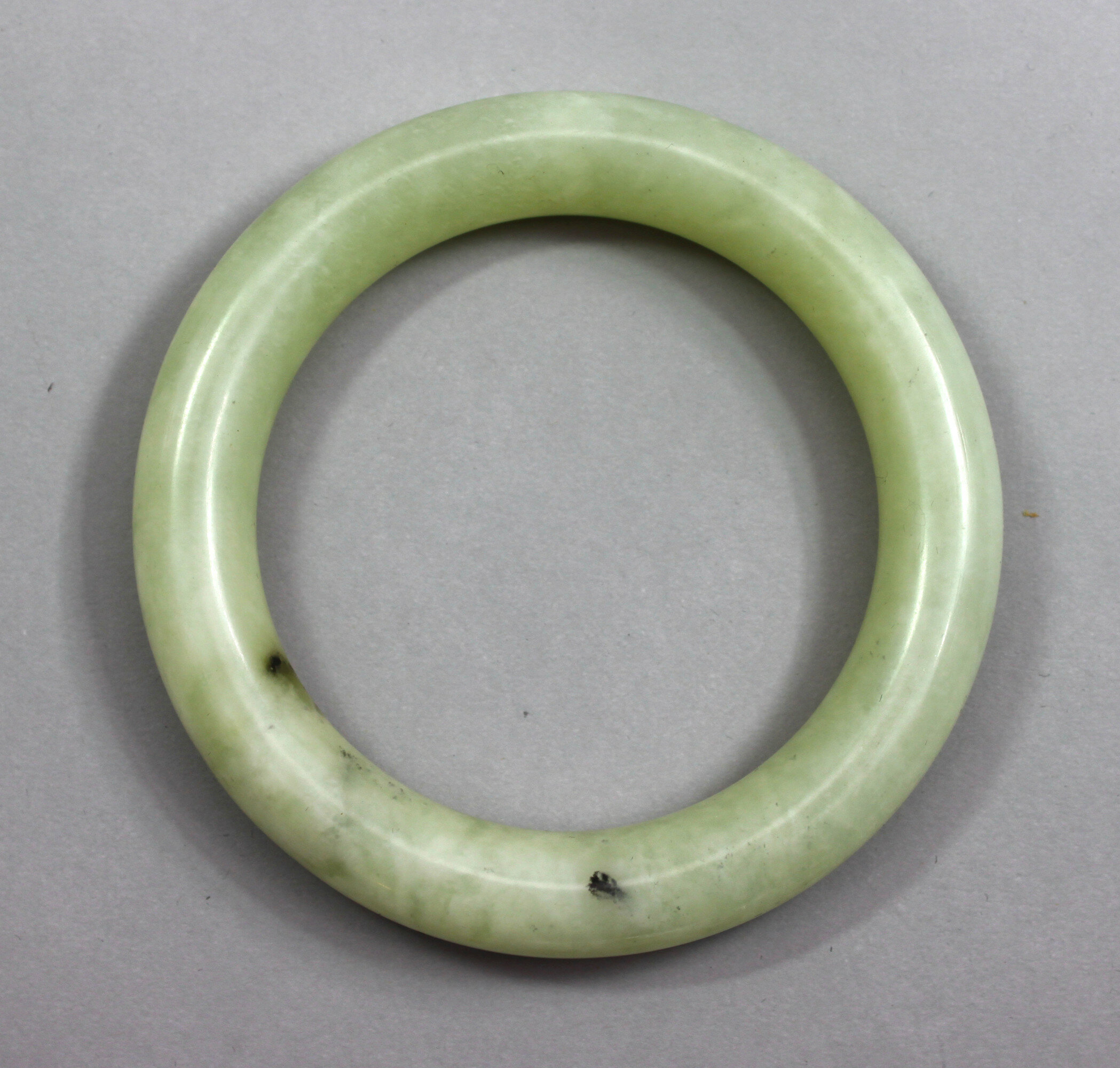
Chinese Pale Celadon Jade Bangle, probably Nineteenth Century
Price: £45Jade is usually divided into two types, nephrite jade and jadeite jade. The latter is heavier and slightly harder, making it more difficult to scratch. The weight of this piece suggests that we do have jadeite here. The stone was selected for carving on the basis of its attractive appearance and the finish, which bears no trace of machine tooled manufacture, suggests a pre twentieth century dating, but certainty in these matters is notoriously difficult
The size of this piece is unusually large, suggesting that it would have been intended for a male wearer. This too suggests an earlier rather than later time of manufacture. The stone is exceptionally pleasant to the hand and would have been an elegant accompaniment to any wardrobe.

Set of ring and earrings with obsidian mask motif, Mexico, 1950s
Price: £45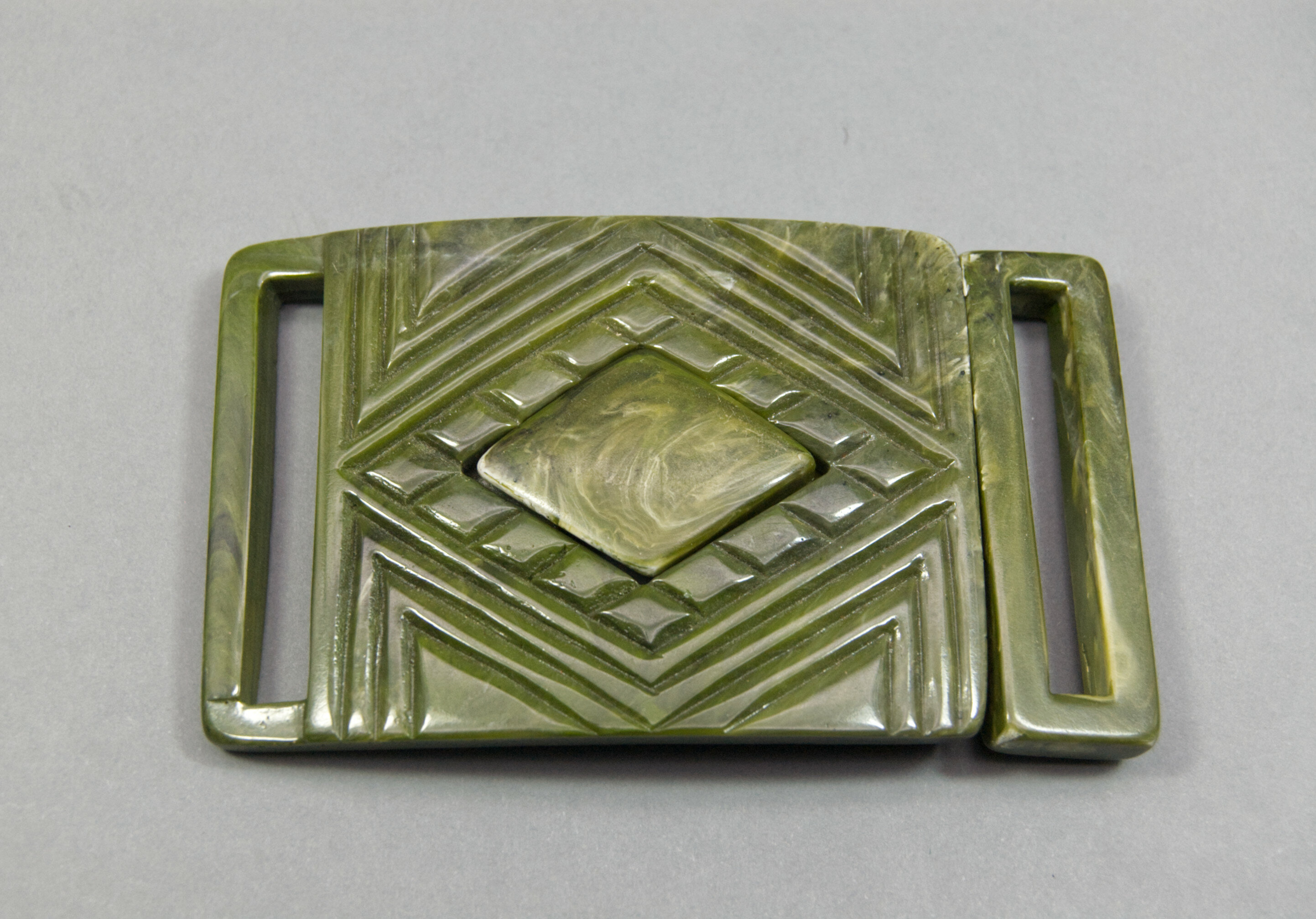
Large Art Deco green Bakelite Buckle with a label for Harlem Adler, American 1930s
Price: £35
Chinese Blue and White Vase decorated with flowering Prunus circa 1900
Price: £55Flowering prunus or plum blossom is one of the most iconic of the decorative designs used by Chinese potters and first appears in the Kangxi period (1662-1722). Kangxi ginger jars in the pattern were highly prized by Victorian collectors with one example, the legendary ‘Huth’ jar, fetching 5900 guineas, a little over £6000, at auction in 1905, a price equivalent to over a quarter pf a million pounds today. The tree symbolises perseverance and renewal and was usually shown against a pattern of ‘cracked ice, representing the end of Winter and the beginning of Spring. Branches of plum blossom convey the ‘Five Blessings’ : longevity, wealth, health, love of virtue and a peaceful death. The number five was an auspicious number for the Chinese and is reflected in the five petal form of the prunus flower.
Once evolved, the design was continuously repeated by Chinese potters and is even produced today. Many of late nineteenth century pieces display a rather more slapdash interpretation of the pattern as here where the ‘cracked ice’ of the eighteenth century pieces is replaced by the repeated brush strokes of a blue wash ground and the painting of the tree itself is sketchy. The style of decoration and the paste of the foot indicate a circa date to around 1900, but this modest interpretation of centuries old pattern still possesses a charm of its own.
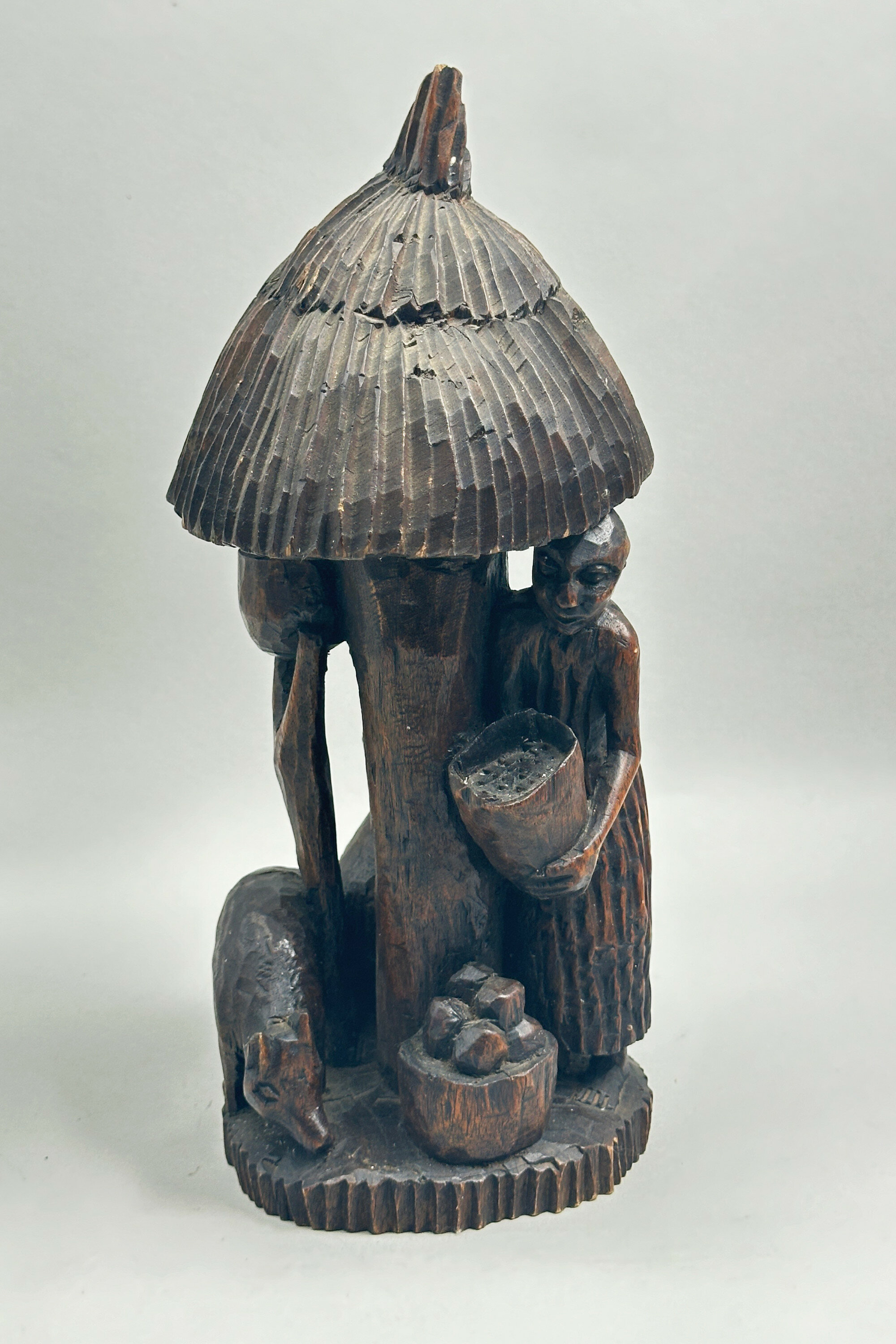
African wood figural group, Guinea c1970
Price: £35
Continental Earthenware Vase with geometric motifs in the style of Amphora, C20th
Price: £45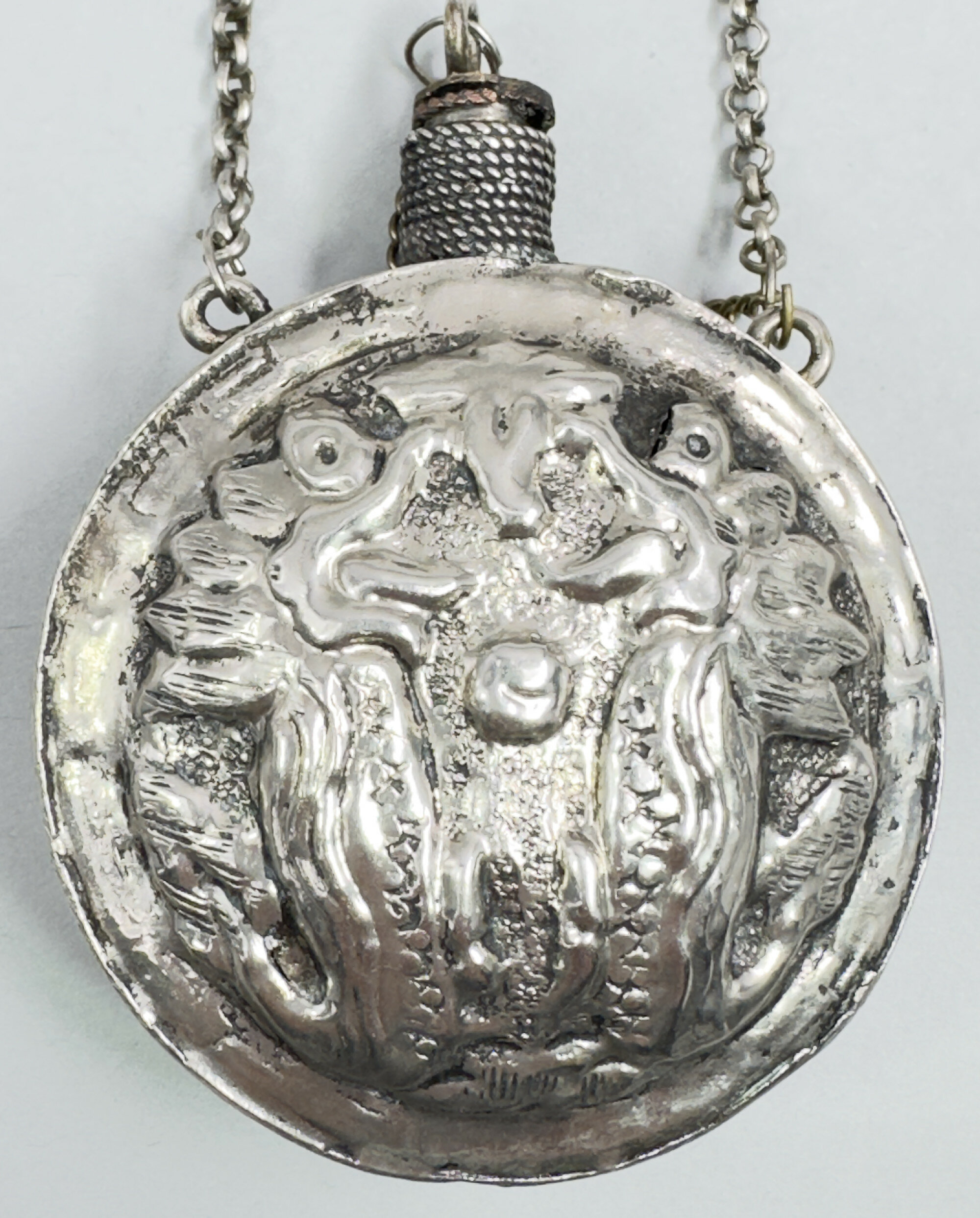
Silver plate Perfume Bottle with attached Stopper and Chain, Burmese late C19th
Price: £45
Chinese Bone Netsuke carving of a man holding a musical instrument, early C20th
Price: £25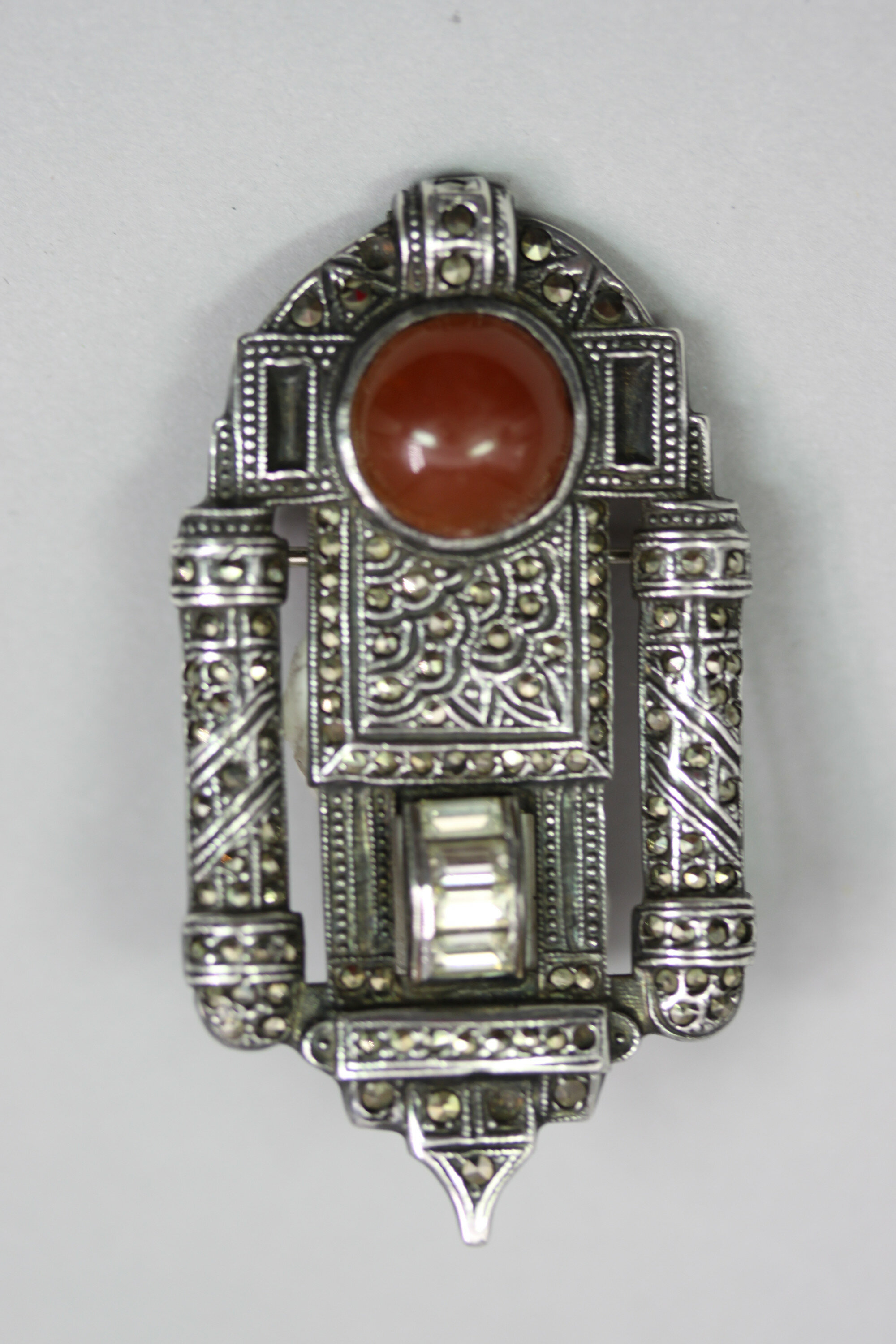
American Art Deco silver and marcasite brooch
Price: £35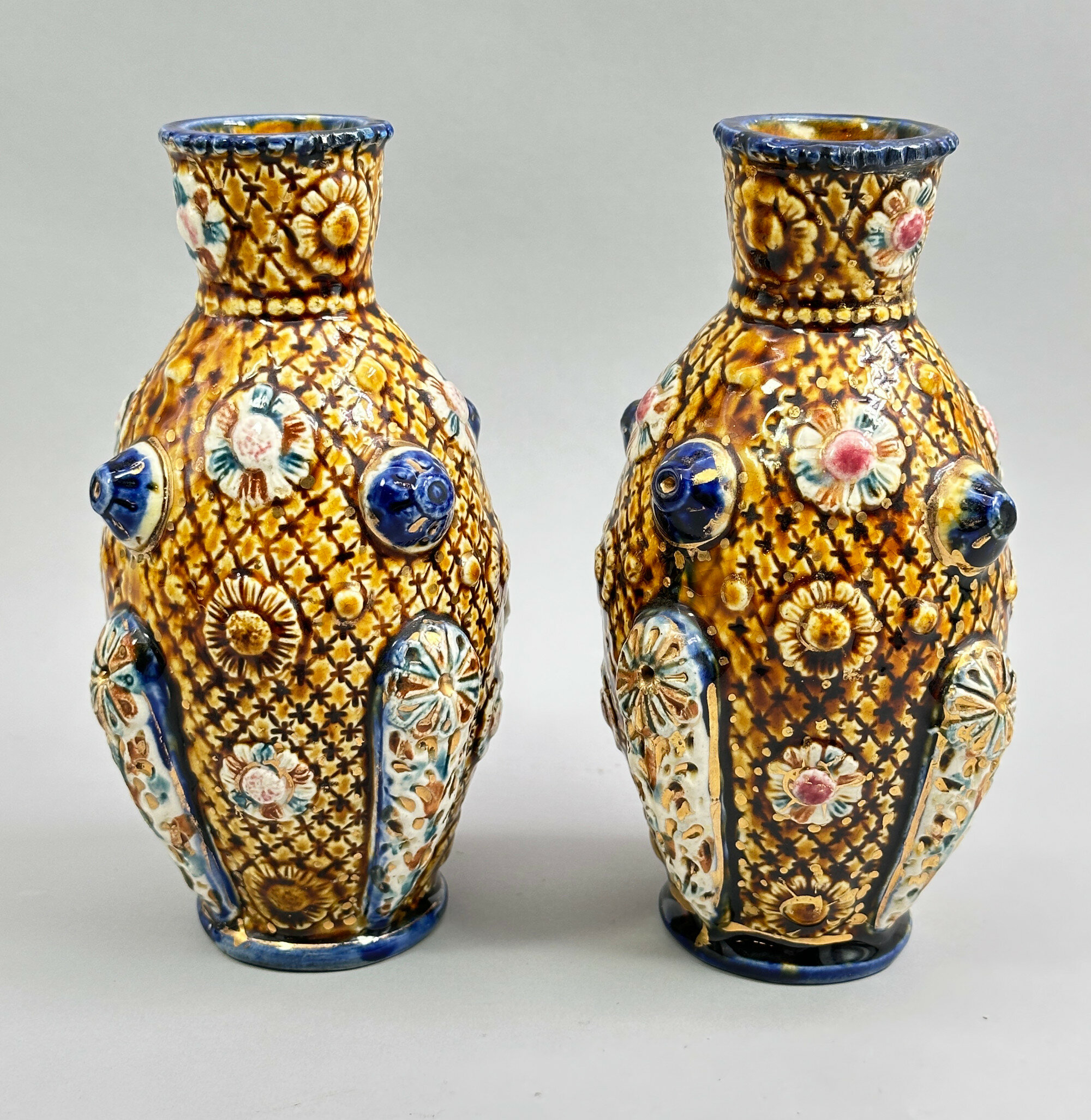
Pair of Alhambrian Ware English Majolica Vases with raised decoration circa 1880
Price: £30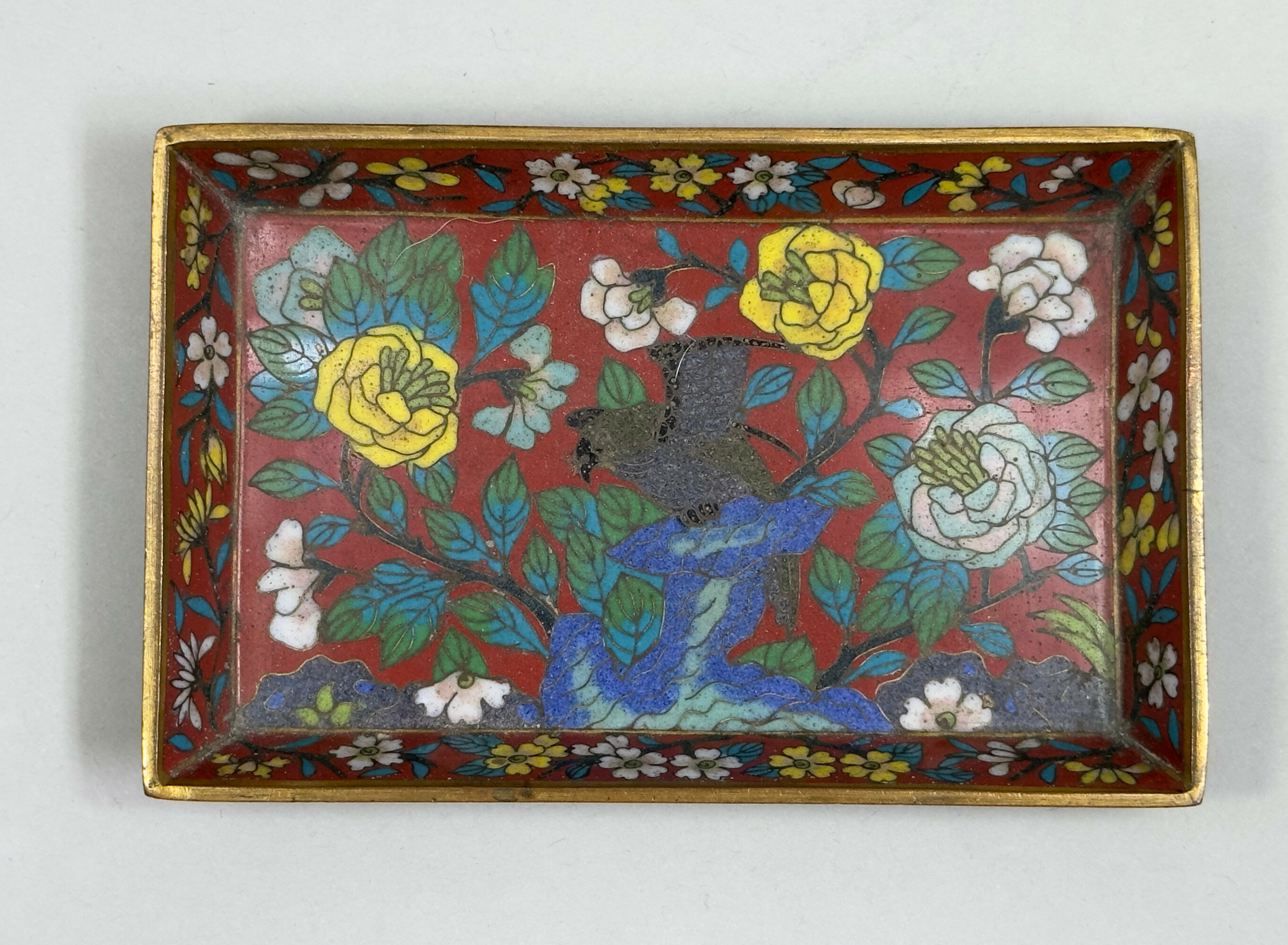
Chinese Cloisonne Small Tray decorated with Flowers and Rocks, 19th Century
Price: £150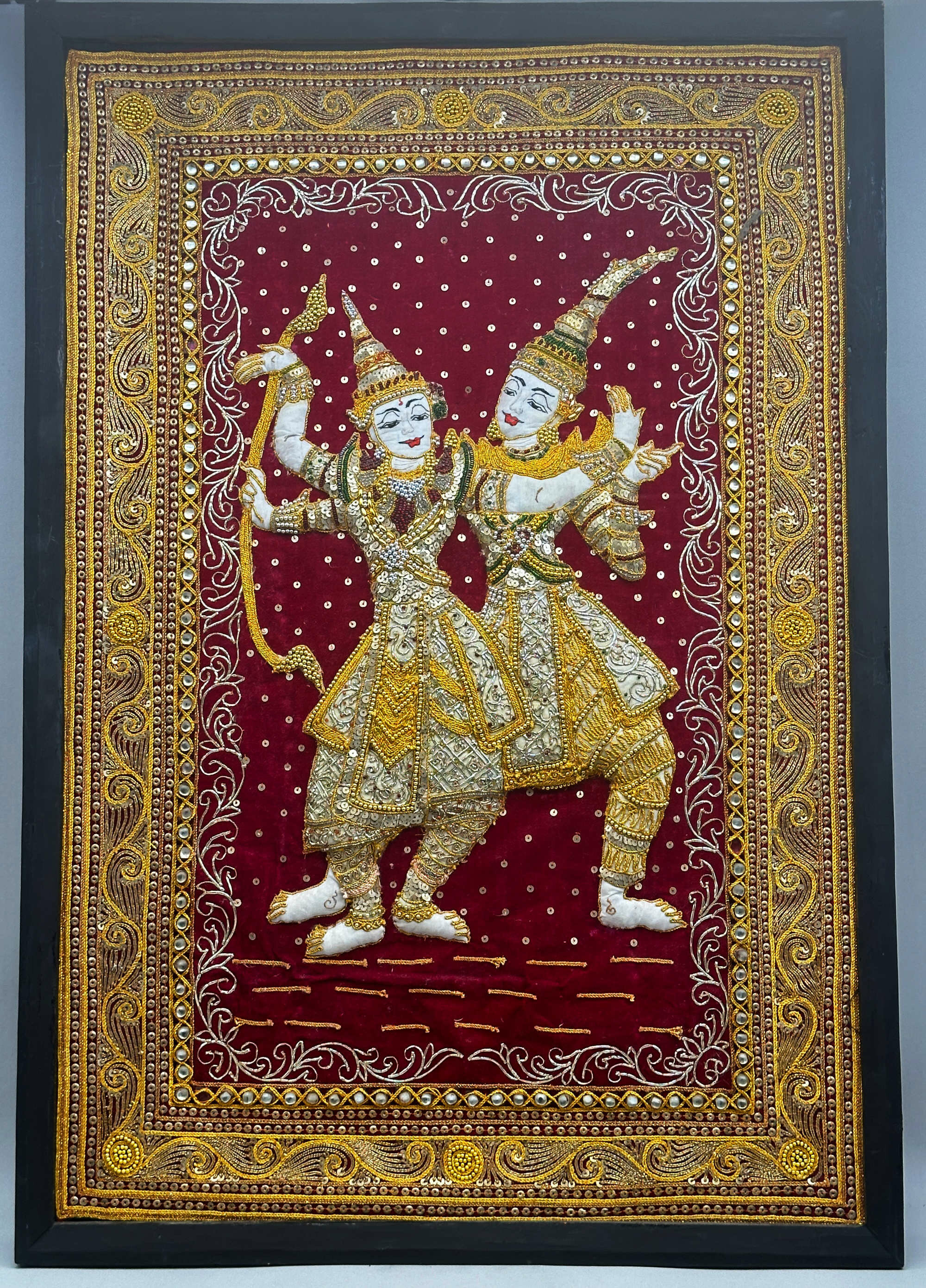
Large Burmese Textile with two dancing figures, probably second half C20th
Price: £110The distinctive style of embroidery and applied work here is typical of Burmese work known as ‘Kalaga’ which means ‘curtain’ in Burmese and is used to refer to heavily embroidered appliqué tapestry sewn with a technique called ‘shwe gyi do’. First produced around 150 years ago, Kalagas are generally linen, silk, cotton or velvet background fabrics embellished with sequins, embroidery, beads, coloured stones, tiny pearls, coral, braids and metal threads, the choice of materials depending in part on the client’s budget. Cotton padding was used to produce the ‘3D’ effect seen here and on many other examples of the work. The elaborate decoration meant that some of the larger pieces could take many months to produce which is likely to have been the case here. Dating is difficult and a mid C20th attribution here is probably sensible but an earlier period of manufacture is quite possible. The hanging has been recently mounted on board and fitted with a simple frame making it ready for display in a contemporary interior.
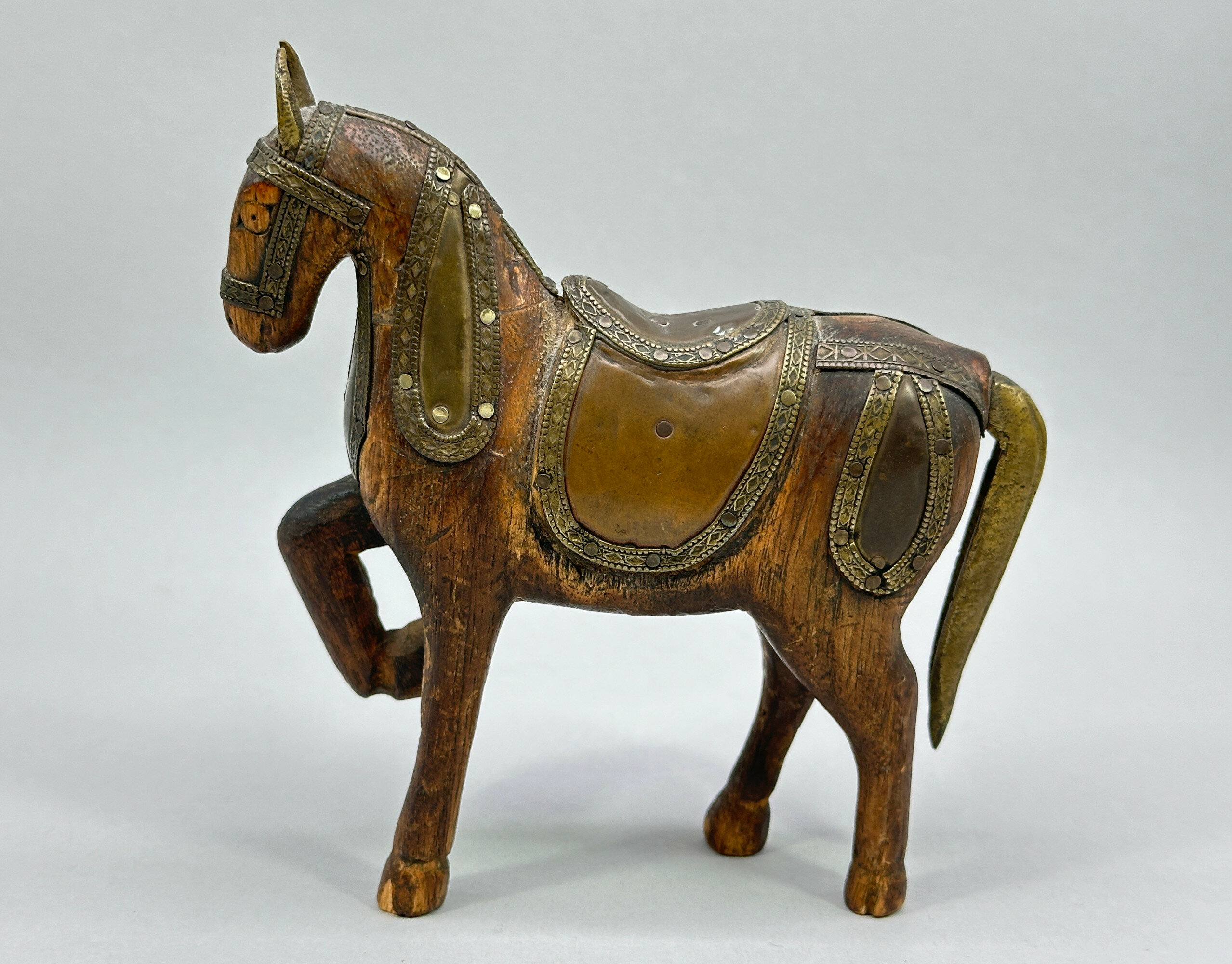
Indian wooden toy model of a Horse with metal fitments, early C20th
Price: £25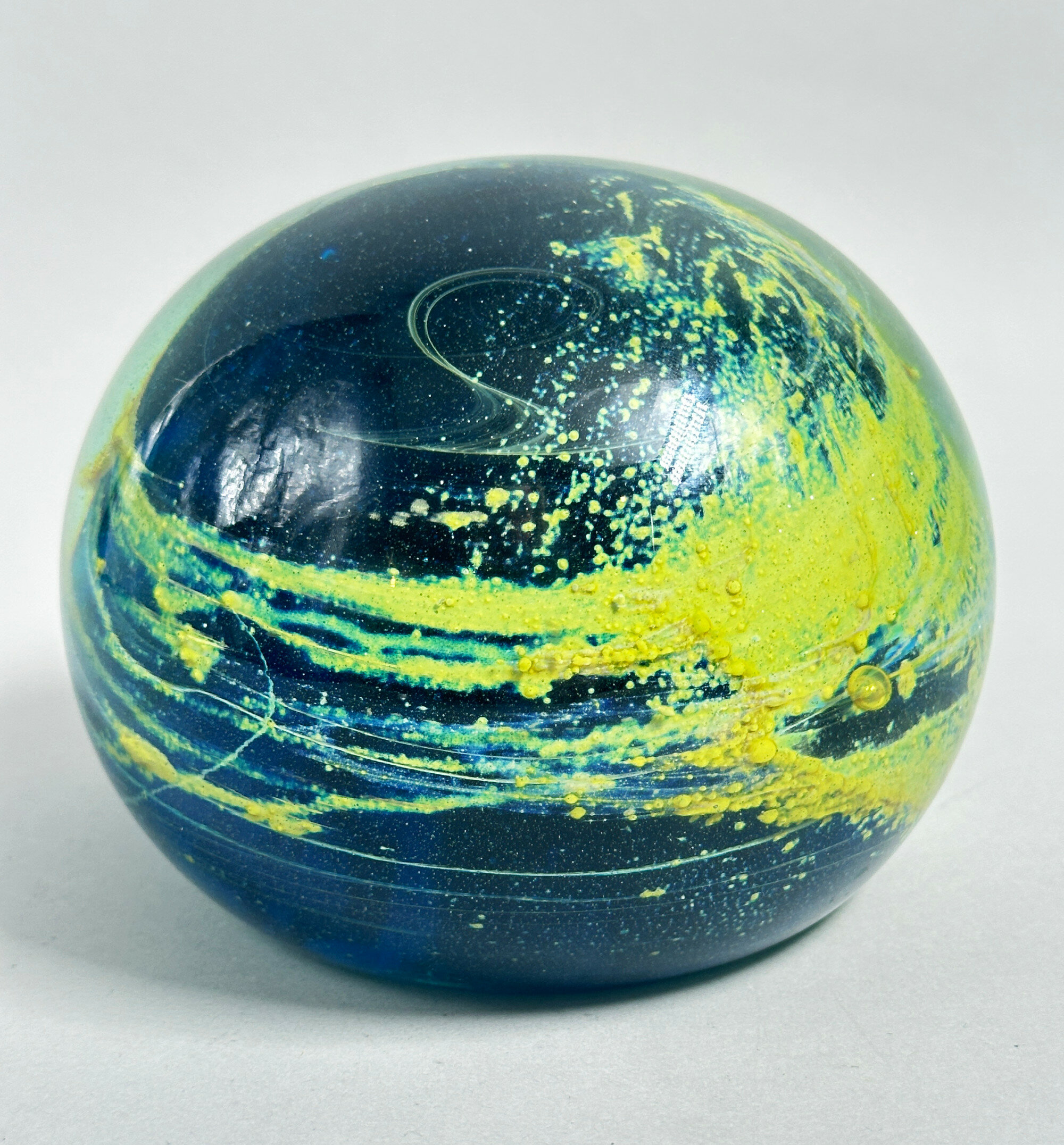
Large Mdina Glass Paperweight/Doorstop, late C 20th
Price: £55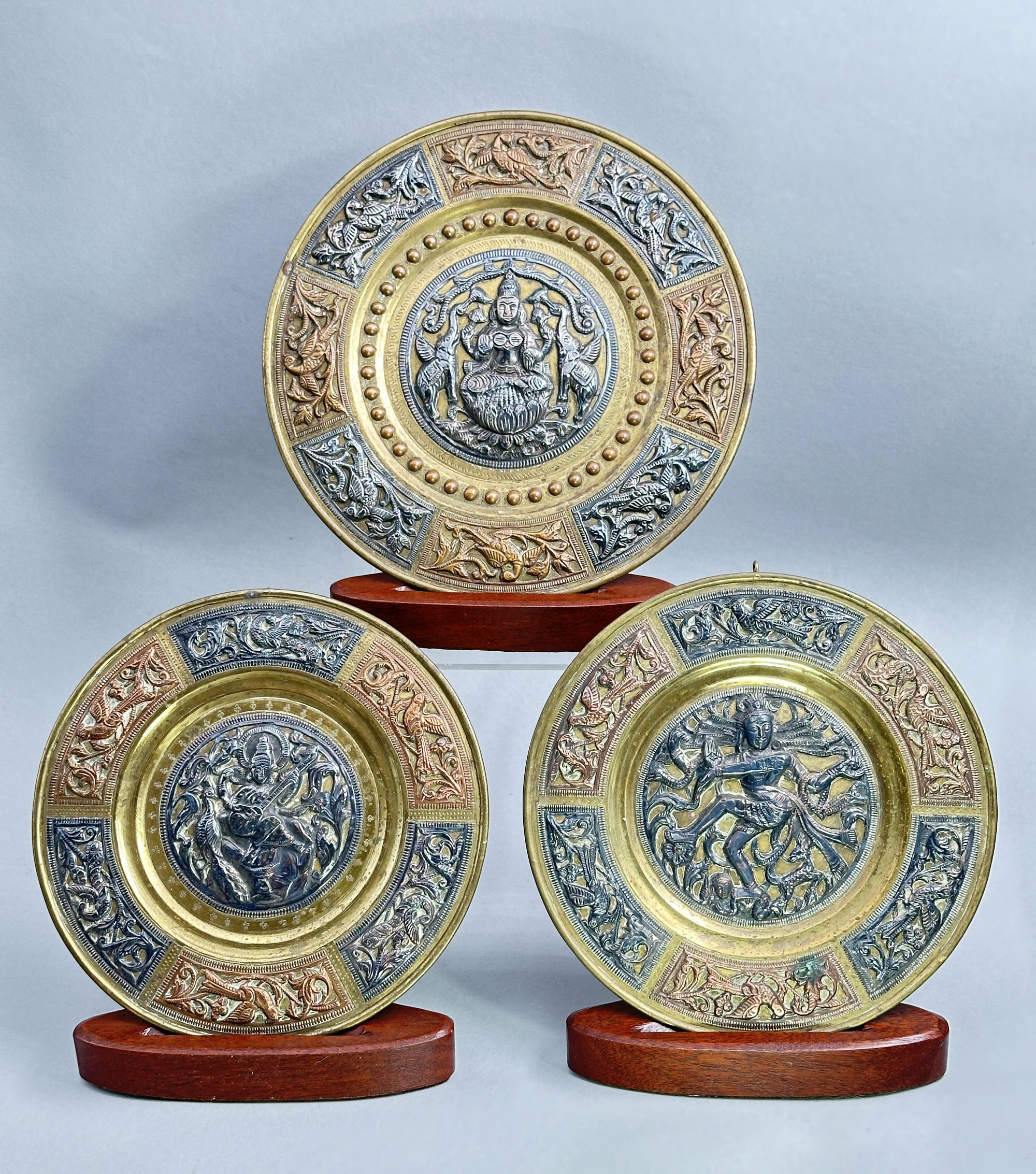
Three Indian Brass hanging plates, Thanjavur, C20th
Price: £55The style of decoration here is typical of the art brass hanging plaques produced by the metalworkers of Thanjavur, formerly known as Tanjore, from the late eighteenth century onwards. A Tanjore Art Plate consists of three components: the base plate (brass), a circular central relief panel of a deity worked in silver surrounded by relief panels in copper and silver often depicting flowers. Various deities are depicted here including the well known many armed Shiva. All the reliefs have milled borders but the wells are finished differently, some with engraved designs and one with circular bosses. Dating is probably to the mid C20th but the style of these pieces was continuous and relatively unchanging so an earlier period of manufacture is quite possible.
NB Stands for display purposes only and not included

Pair of ceramic Bookends, the three wise monkeys, Czech second half C20th
Price: £30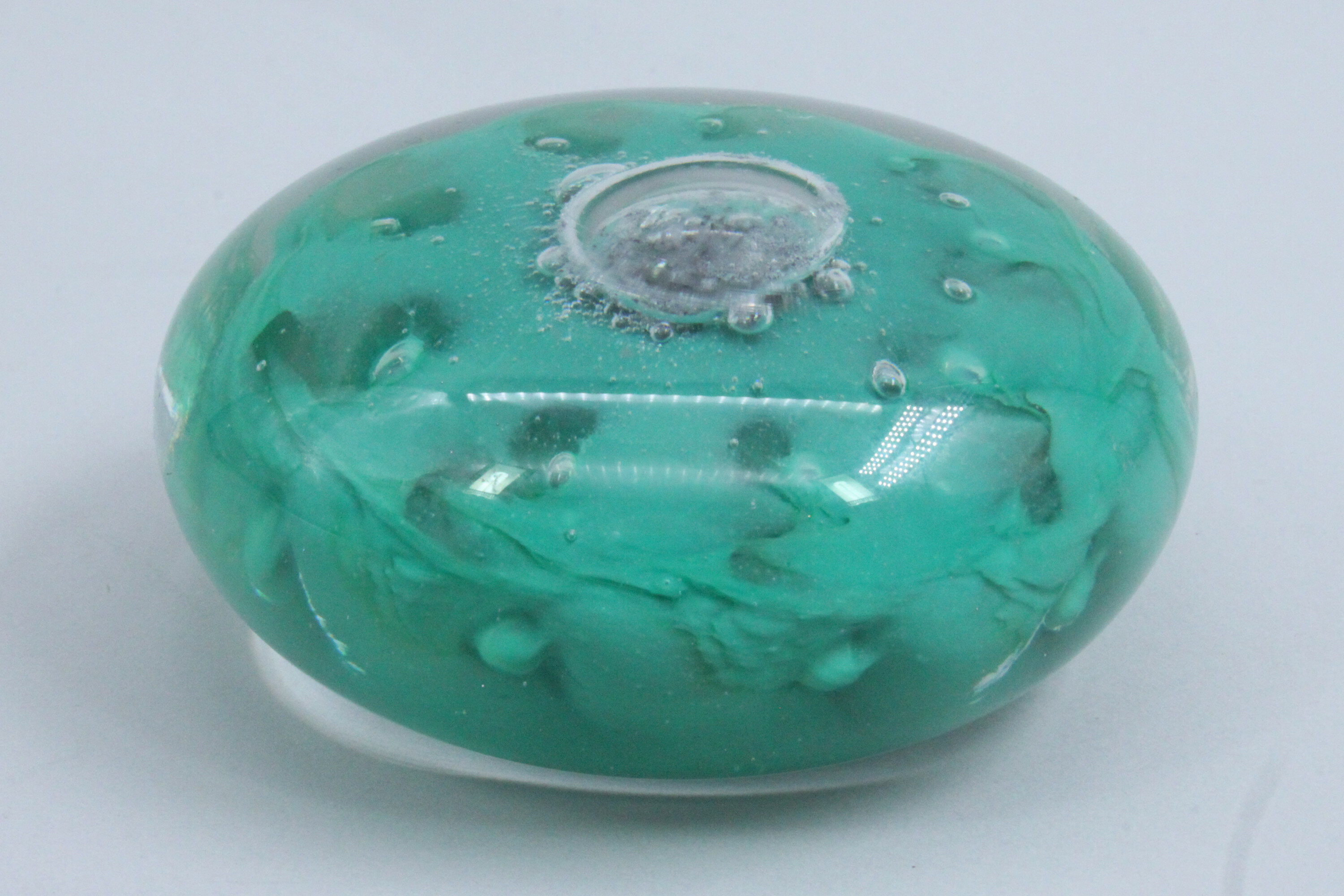
A green glass paperweight, Tweedsmuir Glass, Chris Dodds, late C20th
Price: £25It is sold with a matching contemporary illuminated stand which enhance the decorative effect considerably and provides a modest light display installation for the home (see image 6).

Charming Novelty handbag, Thailand 1950s
Price: £45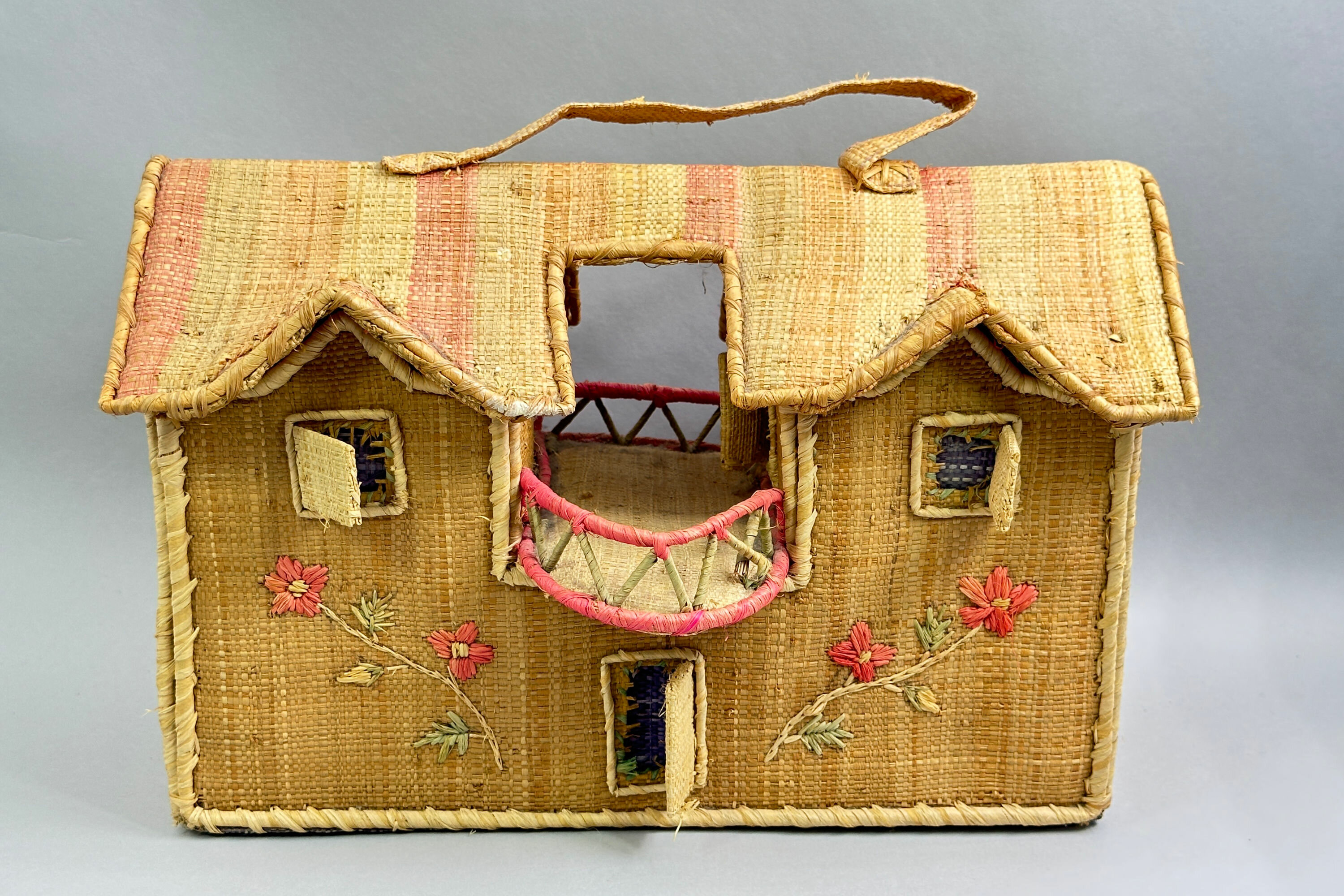
Charming Novelty handbag, Thailand 1950s
Price: £45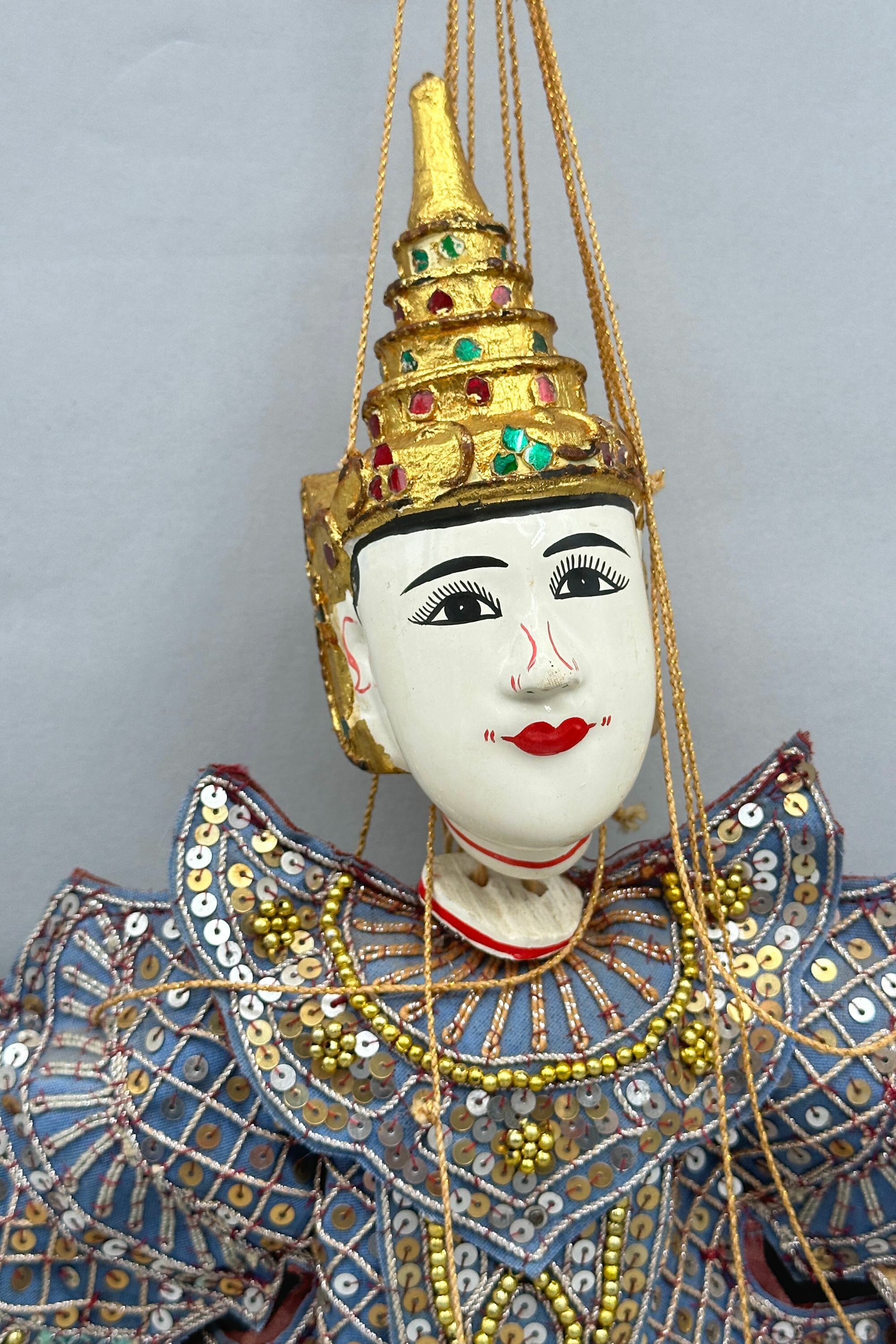
Marionette Puppet of a Dancing Lady or Princess, probably Burmese late C20th
Price: £45The style of the dress suggests Burmese work and very similar fabric decoration can be seen in the cloth wall hangings also included in this sale. Burma has a tradition of marionette puppetry (marionettes are a specific form of puppet where the figure is controlled by strings or rods) which dates back to the late eighteenth century and is still popular today with visitors to the country, now called Myanmar. Termed ‘Yoke thé’, the Burmese marionette tradition allowed political commentary under the guise of of an entertainment display. The standard ‘troupe’ comprised twenty seven characters, both animal and human, and this lady figure is probably the ‘princess’ (‘Minthami’). She is a fine example of the genre and probably dates to the 1990s when General Khin Nyunt of the ruling junta lent official support to marionette actors and troupes in an attempt to revive a tradition which had fallen somewhat into decline.
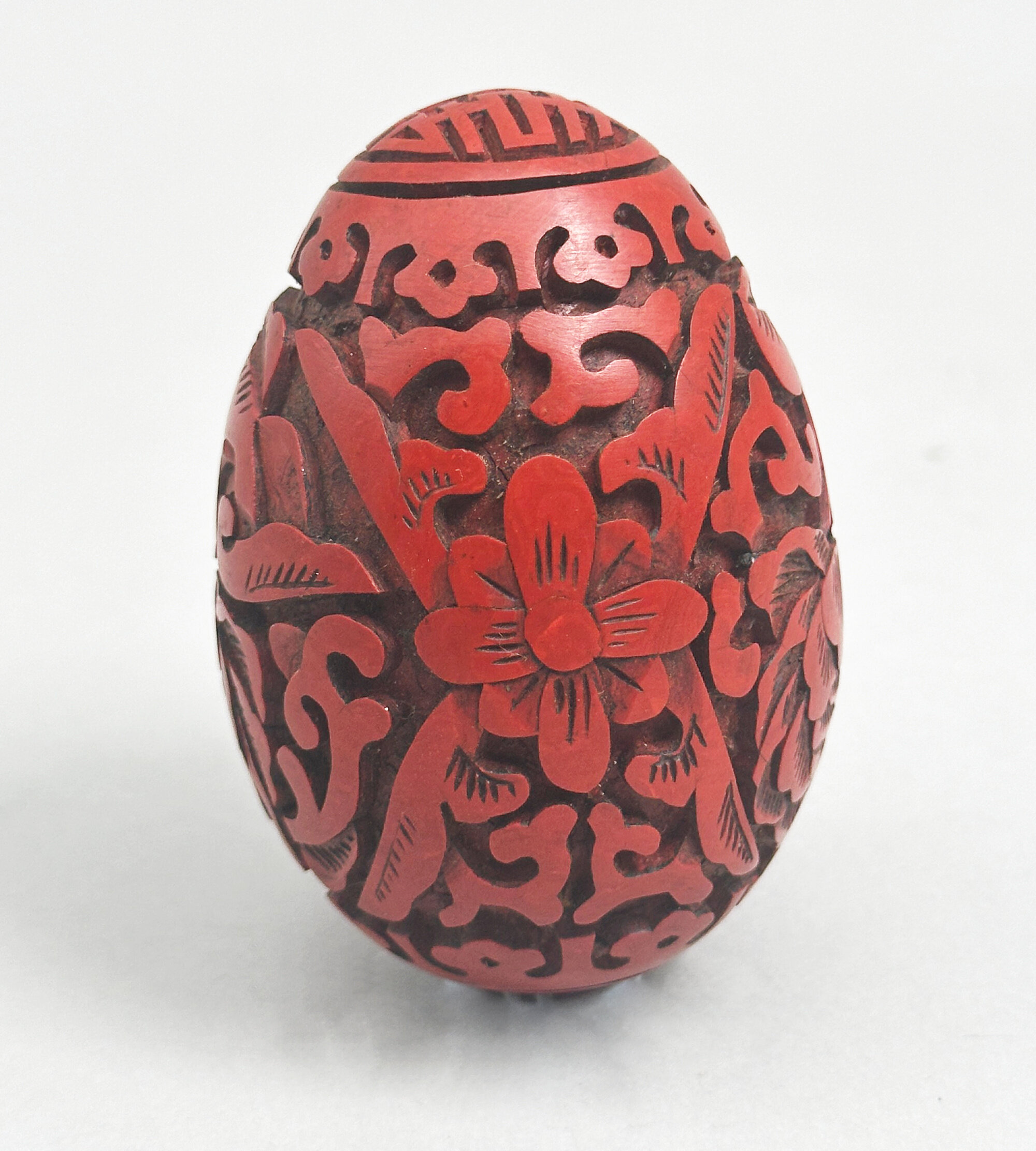
Chinese Cinnabar Lacquer Egg, C20th
Price: £55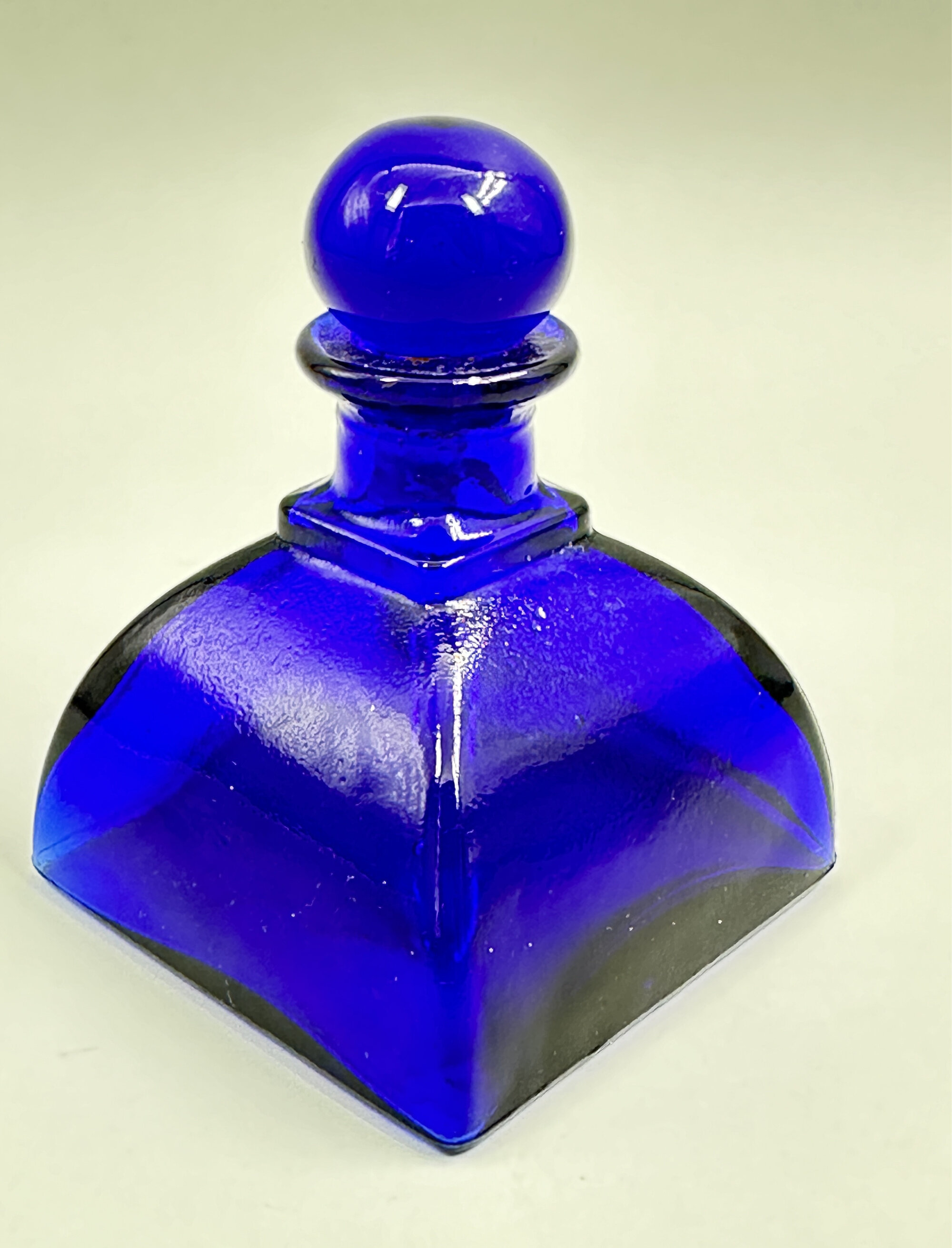
Vintage Cobalt Blue Glass Perfume Bottle and Stopper, 1930s
Price: £25

Bay Ceramic Ewer No 268-30, West Germany, 1960s
Price: £55Bay Ceramics was founded by Eduard Bay in the 1930s and based in Ransbach Baumbach, the heart of the main West German pottery producing region. Their productions included vases in a wide variety of shapes and designs which continued in production until the 1980s. Bodo Mans was amongst their most famous designers working in the 1950s and 1960s. He seems to have concentrated on organic semi abstract designs and ewers in this form, with the same pattern number but in a variety of different glazes, are attributed to him. This monochrome mustard glaze seems particularly attractive and complements the design very successfully producing a striking and decorative item which might enhance a wide variety of interior settings.
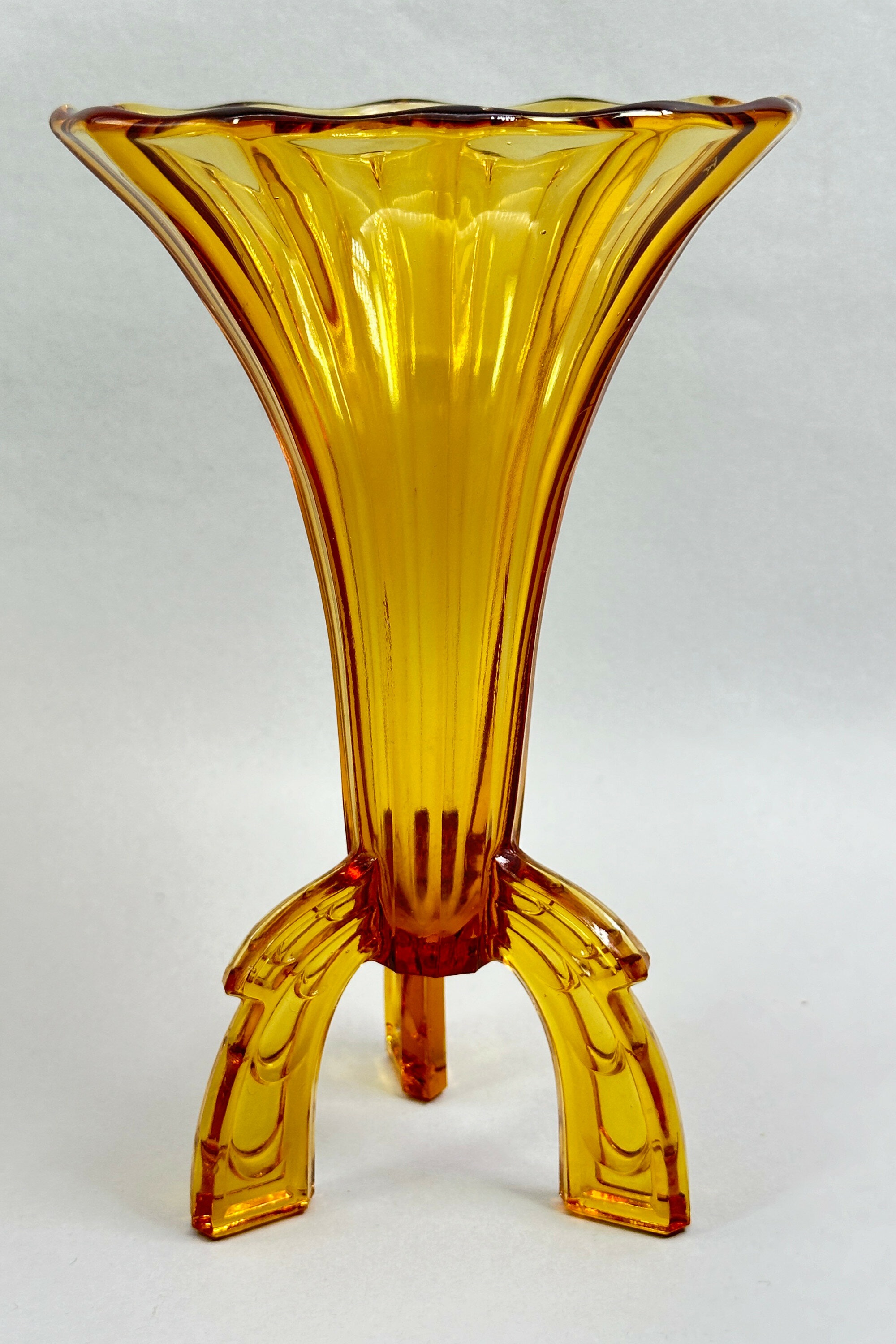
Art Deco style Amber Glass Rocket Vase, probably Czech Rosice 1930s
Price: £45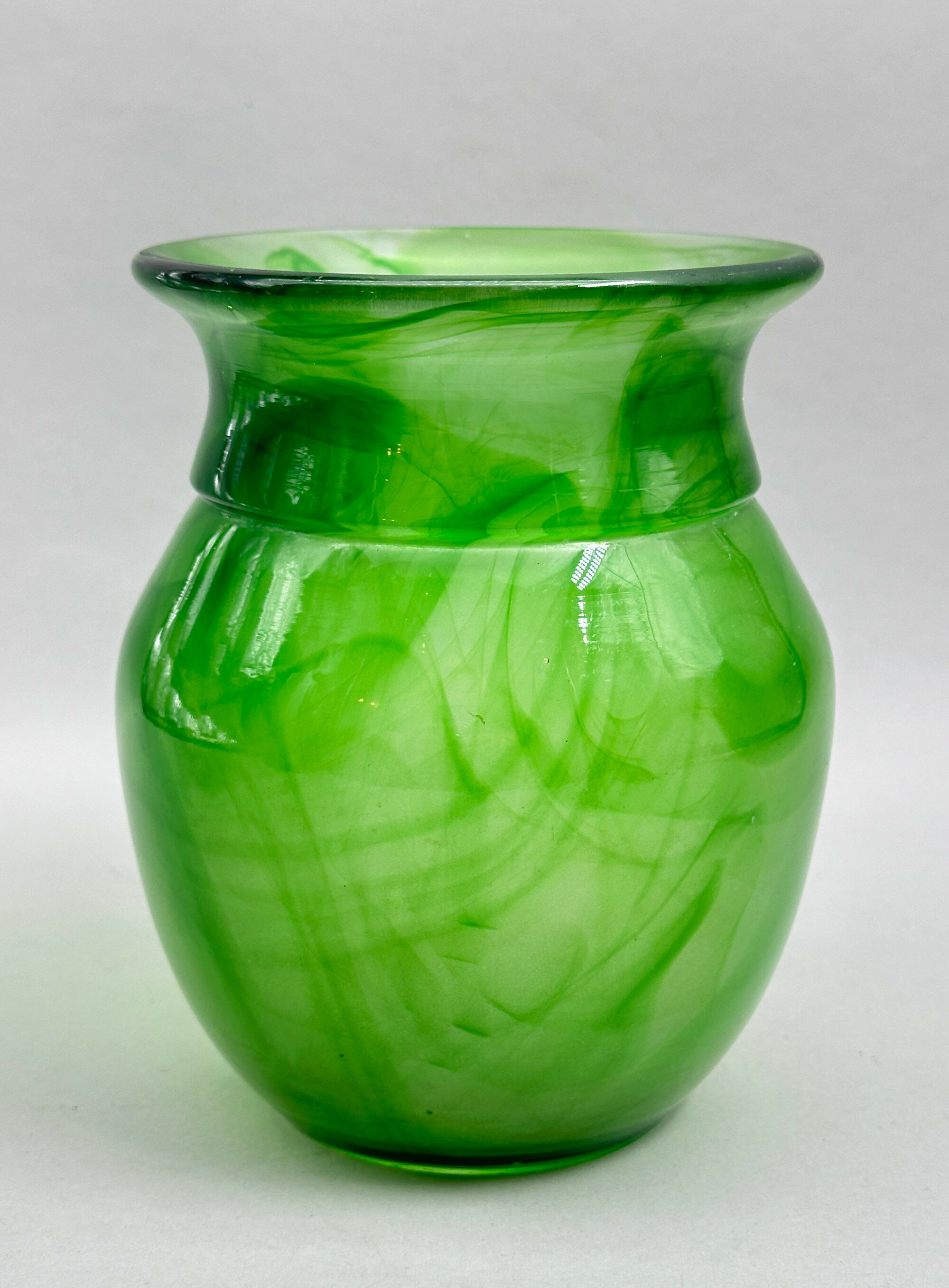
Davidson Green Cloud Glass Vase, 1930s
Price: £55George Davidson founded the Teams Flint Glass Works in 1867, which later became known as George Davidson & Co. In the 1880s the company began producing pressed glass tableware in a variety of shapes and by the 1920s their designs began to reflect the new Art Deco trends. The firm continued production until the 1980s, closing in 1987. This vase is typical of their Art Deco inspired designs although is rather less commonly found today. It has the pattern number '34 'SVF', 'S' standing for 'small', 'V' for 'vase' and 'F' for 'flared rim' and was produced from 1934 to 1942 (see www.cloudglass.com). A slightly larger version was made as well with the pattern number '34' 'VF'. The swirling effect was typical of Davidson's 'cloud glass' designs, one of its most popular ranges. In mint condition, this vase might well fill a gap in a collection of Davidson pieces or pre war British glass generally.

Jade roundel bead necklace
Price: £15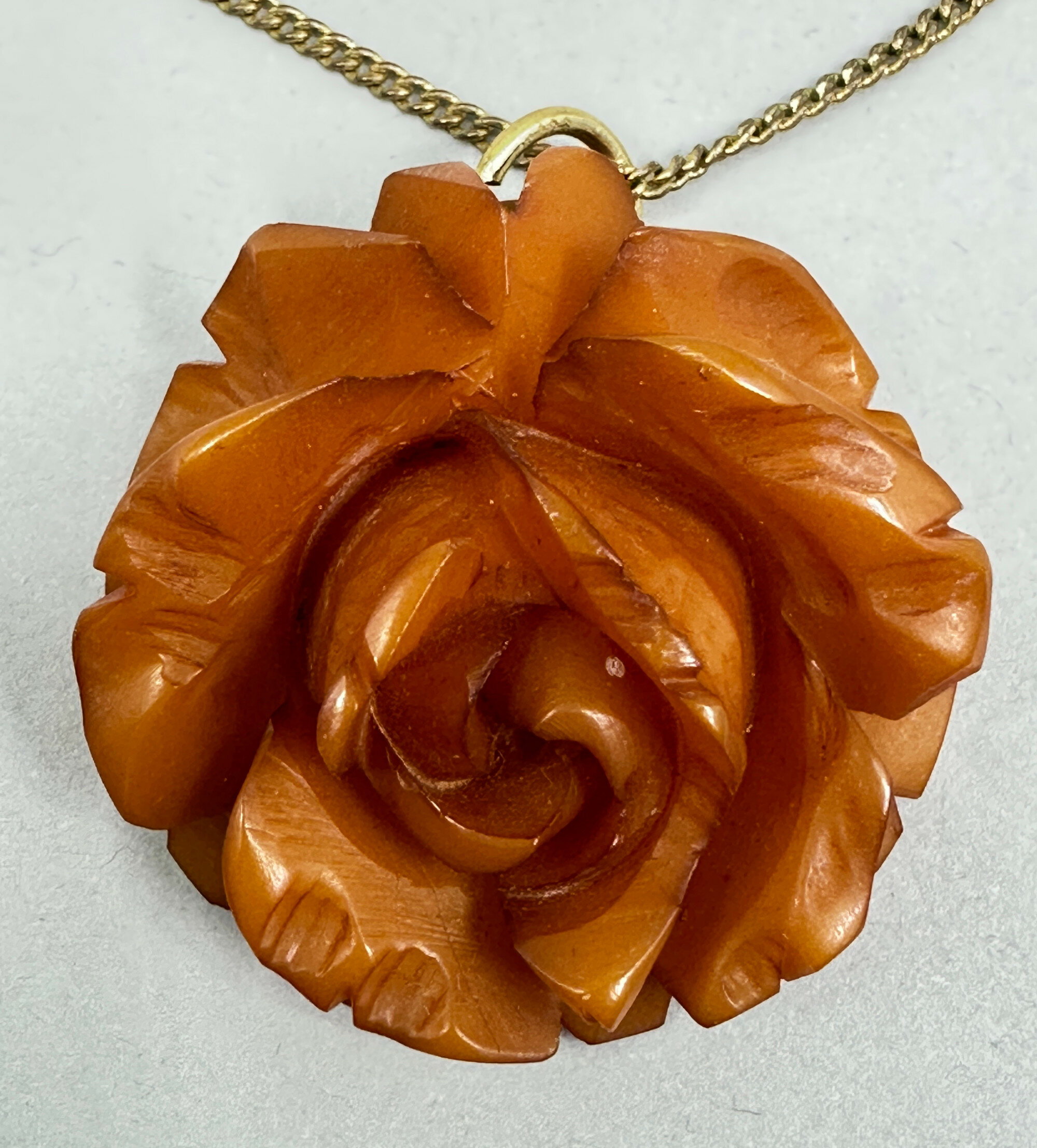
Attractive carved Orange Bakelite Bloom Pendant on modern gold tone chain, British 1930s
Price: £15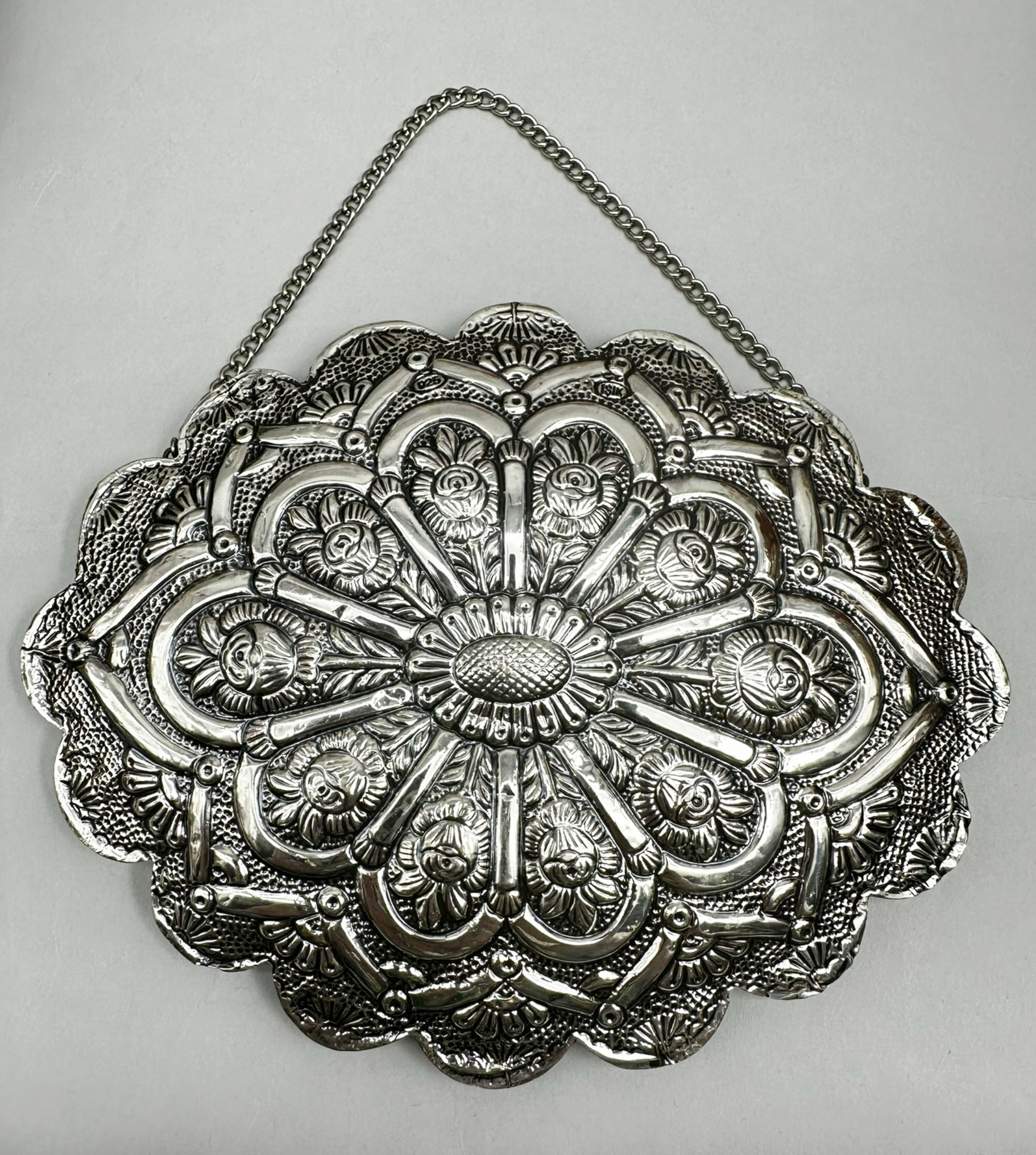
Outstanding Ottoman silver marriage mirror, Turkey early 20th century
Price: £125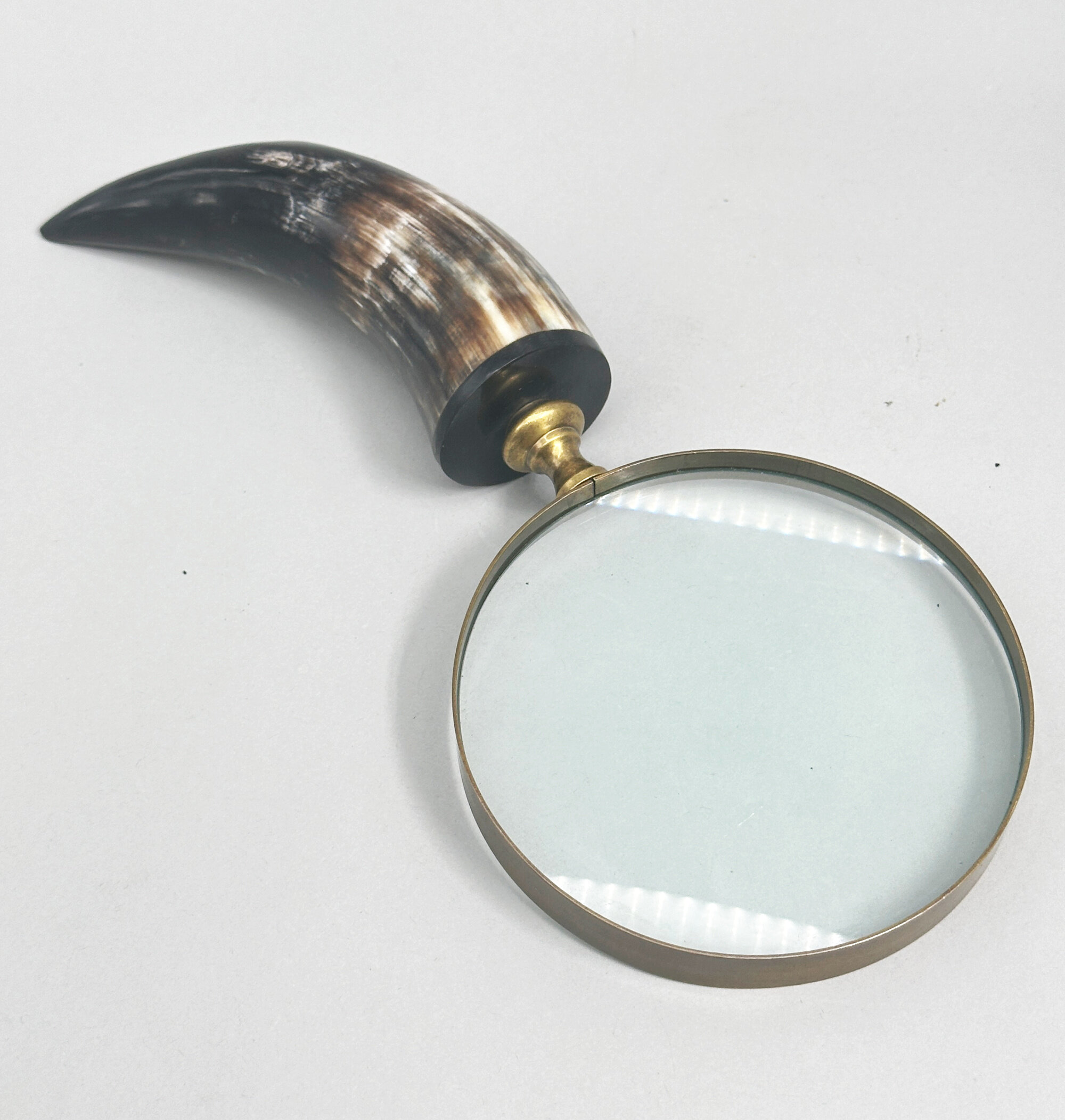
Edwardian large text magnifying glass with horn handle, early C20th
Price: £25
Large graduated necklace of nut carving beads, 1930s
Price: £25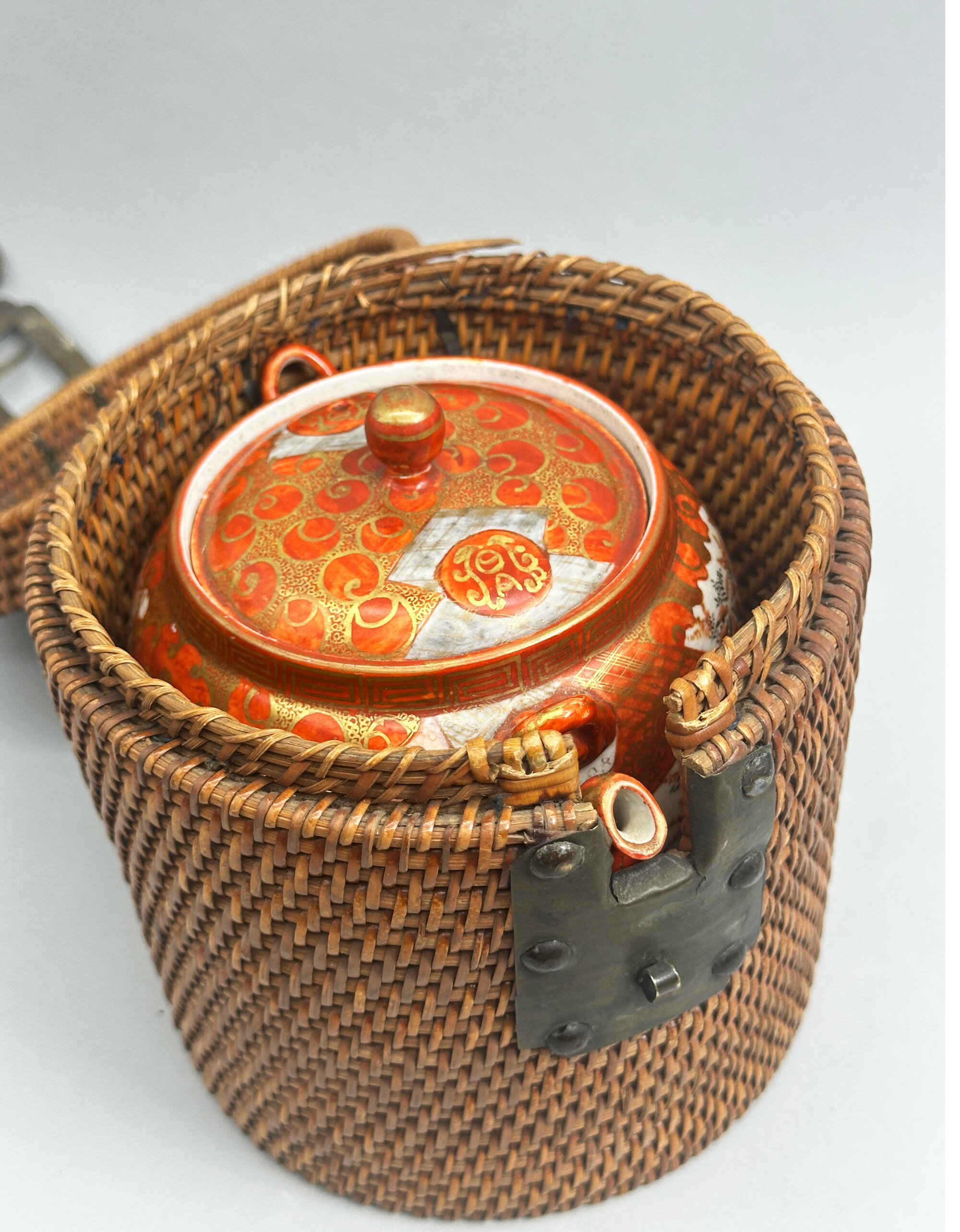
Japanese Kutani Teapot in a carrying Basket, circa 1900
Price: £45Kutani (the word means 'nine valleys') porcelain was made at various factories in the former Kaga province of Japan. The earliest pieces were in a completely different style employing a palette of colours emphasising green, the so called 'Ko Kutani'. Production of this ceased around 1730, and manufacturing was not revived until the early nineteenth century when the more familiar colourings of iron red and gold were introduced. Vases, bowls and plaques are found in this style but also teapots of which this is a typical example. The decoration is of birds and flowers on a faintly craquelure glaze ground and the lid has a complementary ‘brocade pattern’ design. The base has a two character mark reading ‘ku’ ‘tani’ as is often found. The basket is of tightly woven wicker with the metal fitments as described and is probably Chinese in common with many similar examples, although the Japanese did, of course, have a basket weaving tradition of their own. Slight damage means that the ensemble has to be of decorative value rather than practical use but it remains an interesting and entertaining souvenir item from the orient.
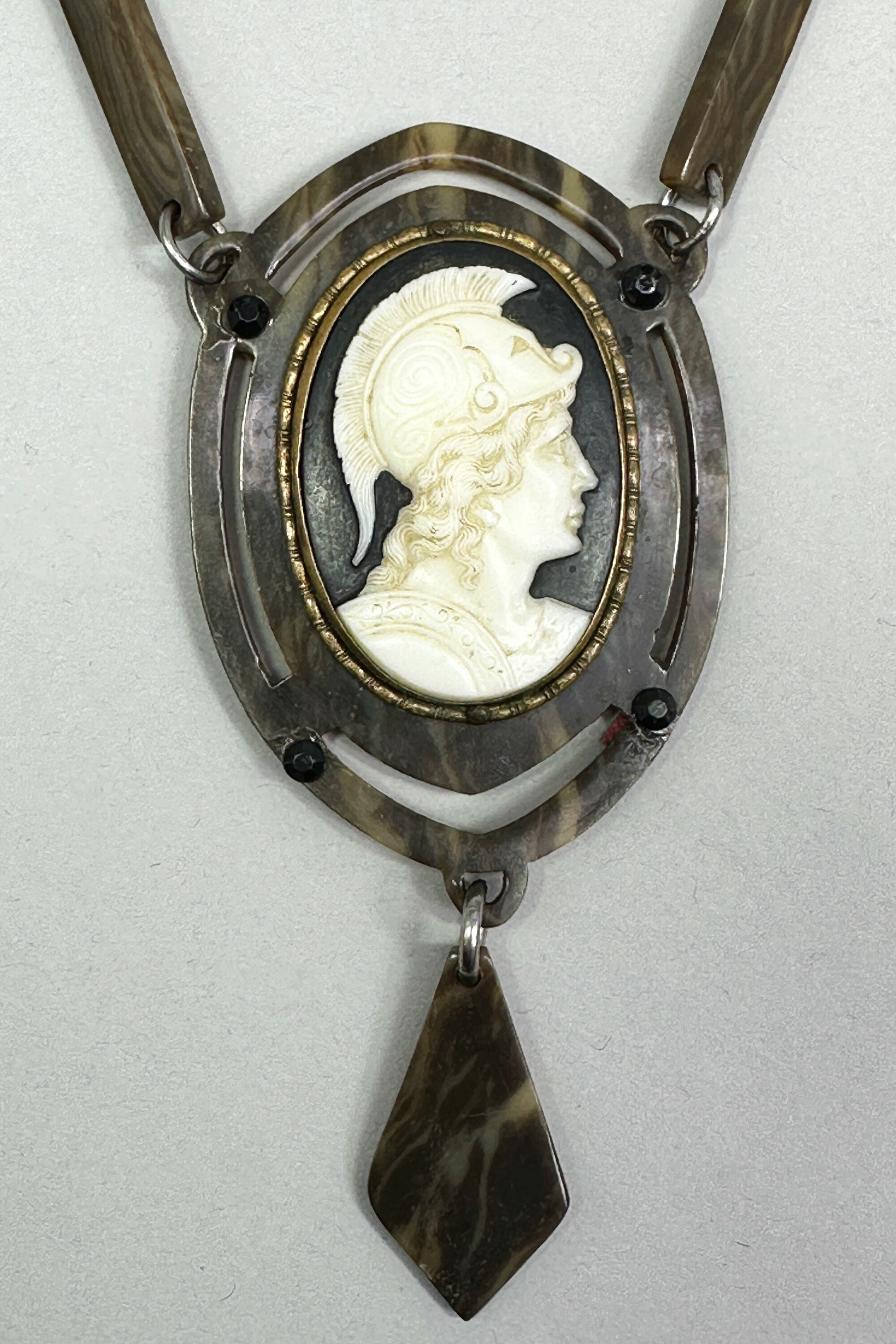
Outstanding brown swirl Bakelite Necklace with faux cameo, French 1920s
Price: £45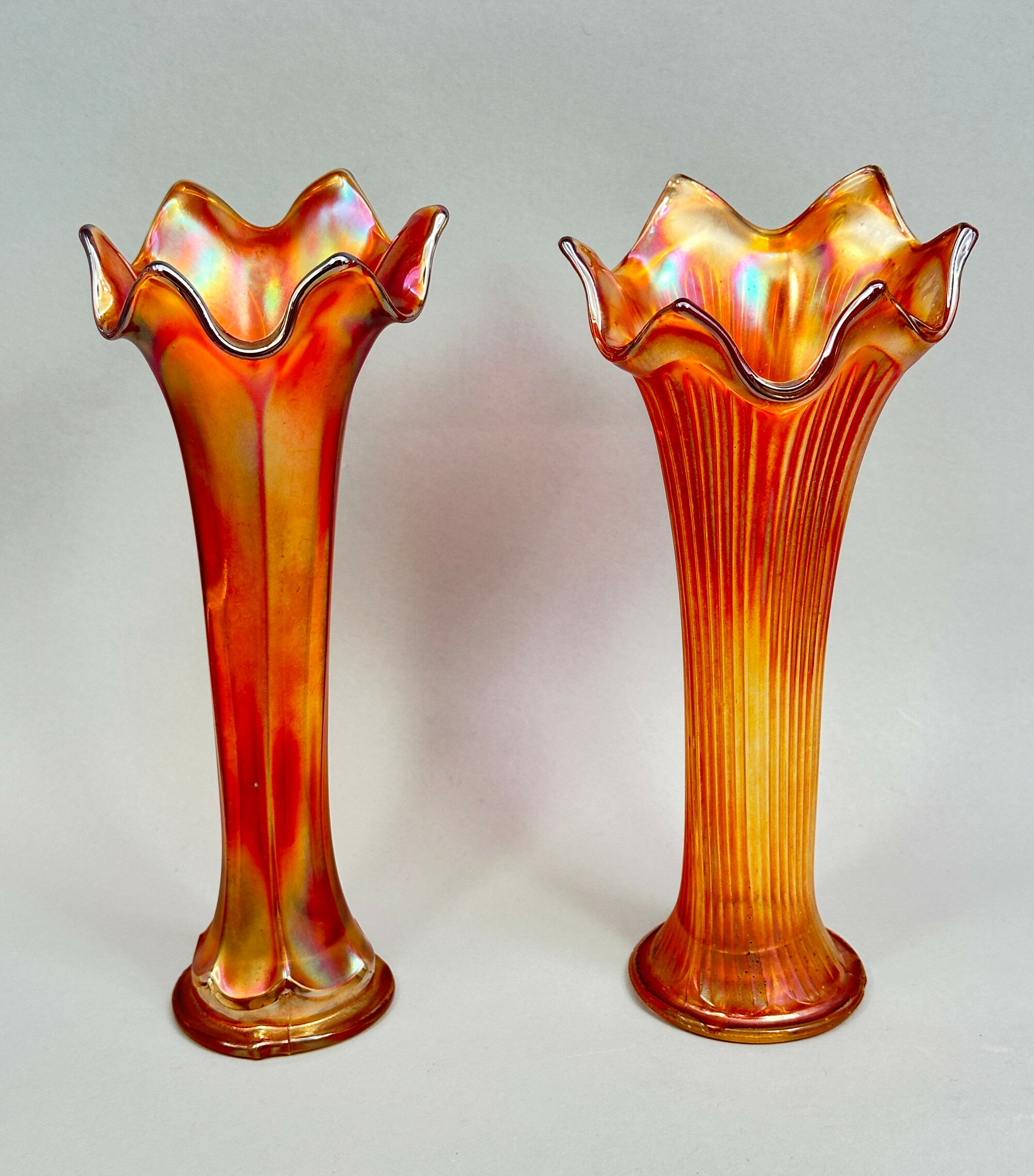
Two Carnival Glass Vases, Marigold, probably Fenton USA, early C20th
Price: £55
Art Deco beaded bag with celluloid frame
Price: £25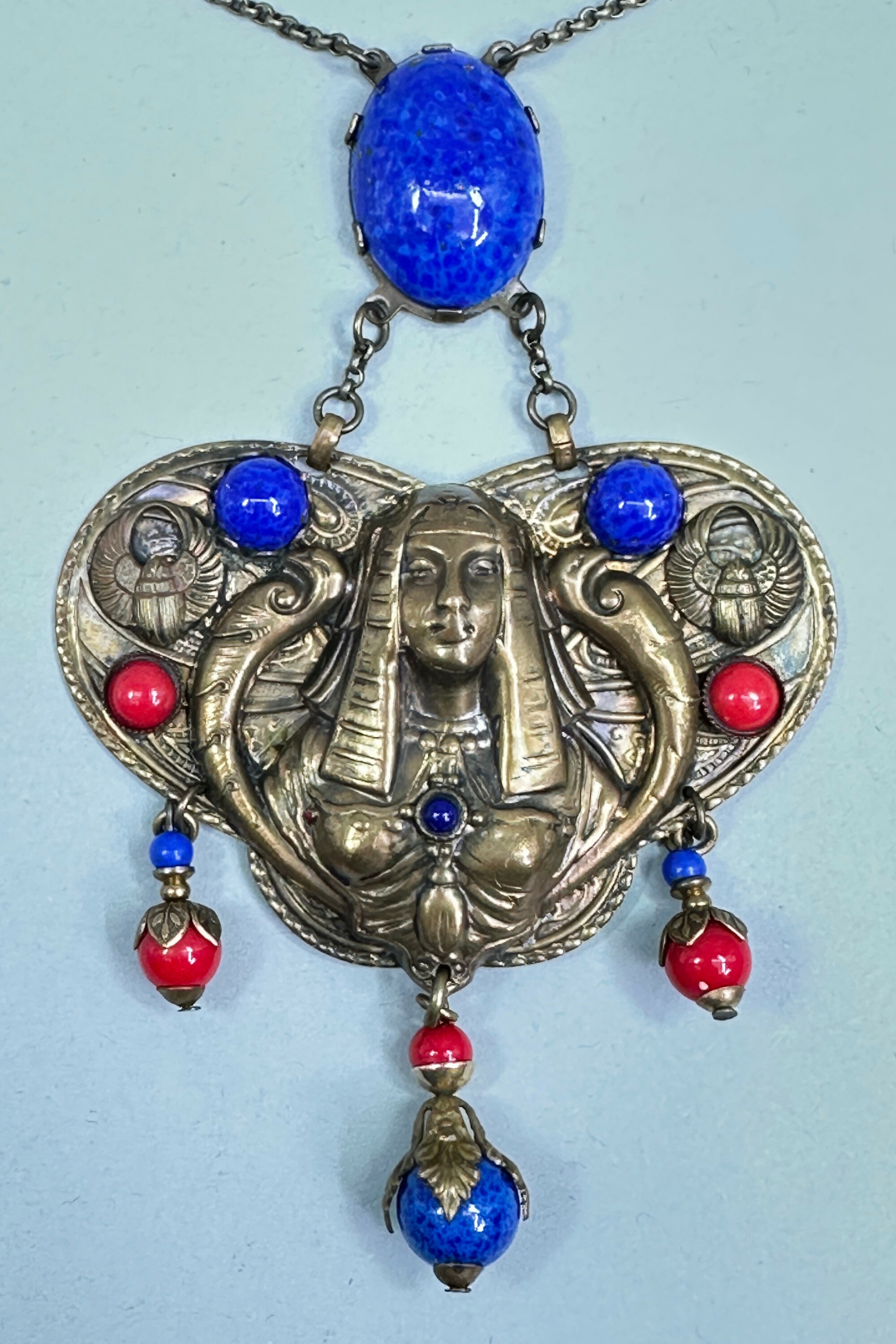
Czech Egyptian Revival Necklace with glass mounts and drops, Edwardian circa 1910
Price: £150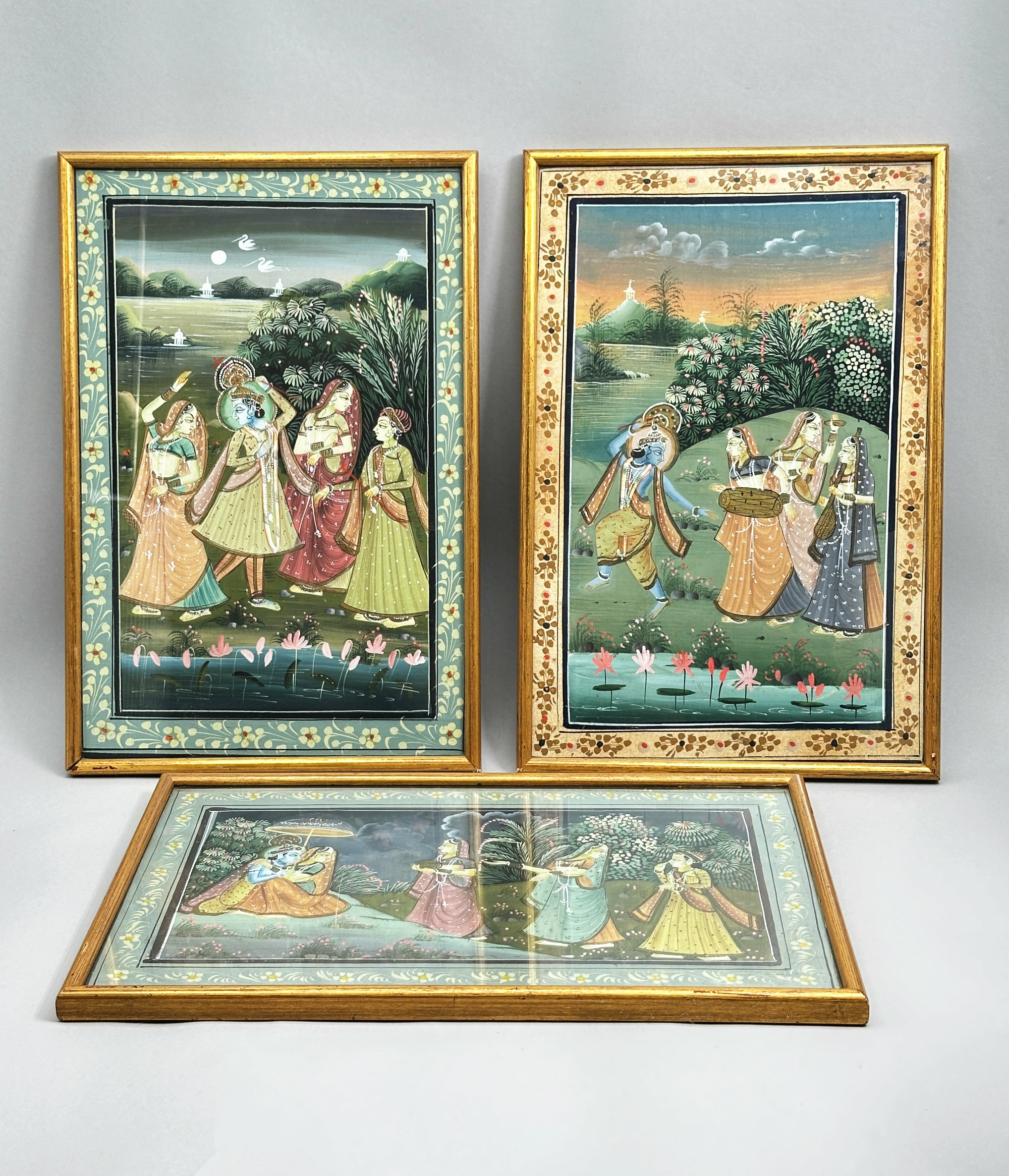
Three Indian gouache paintings depicting Krishna and Radha, framed, first half C20th
Price: £150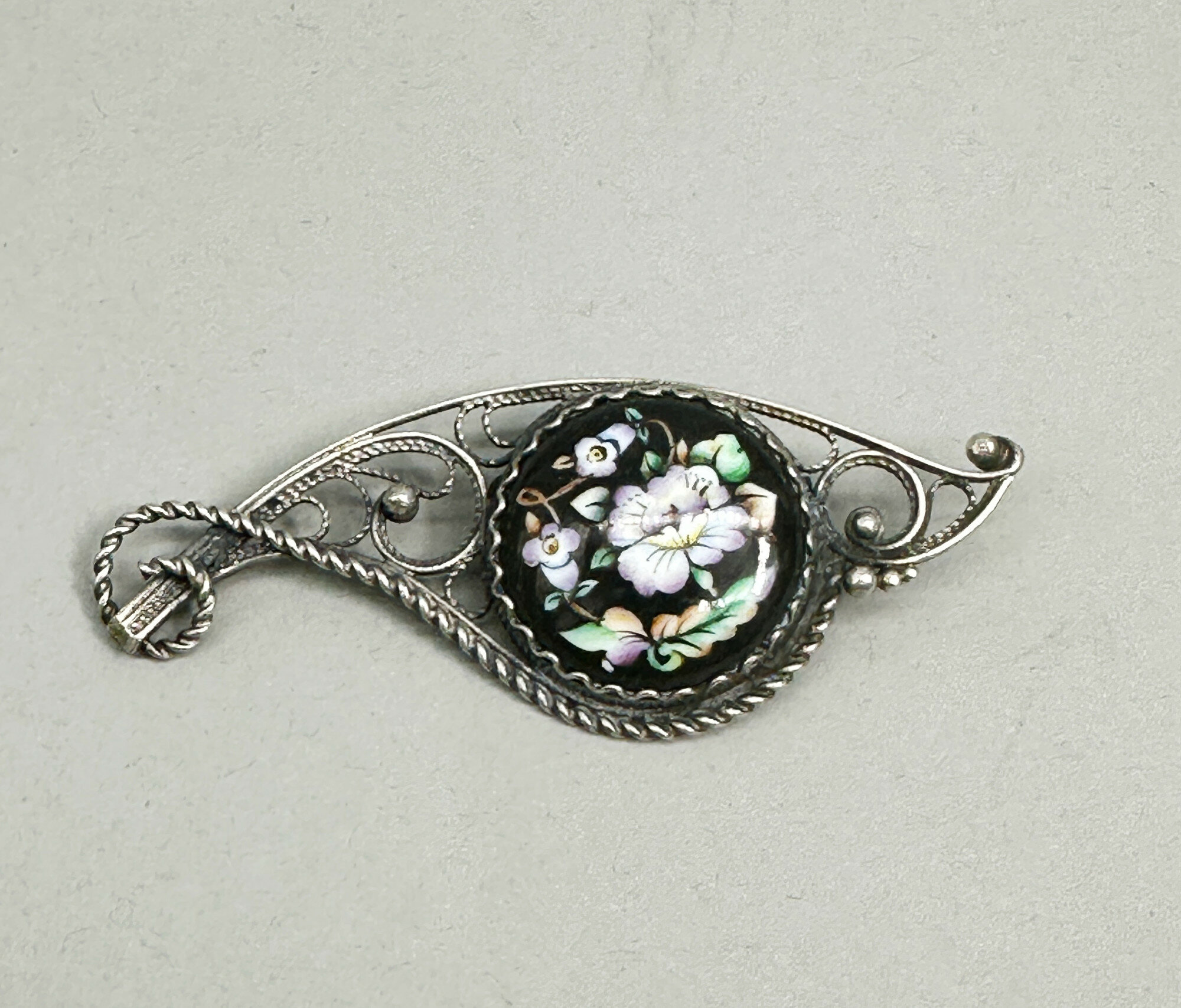
Russian Enamel Brooch, probably Rostov Finift, mid C20th
Price: £20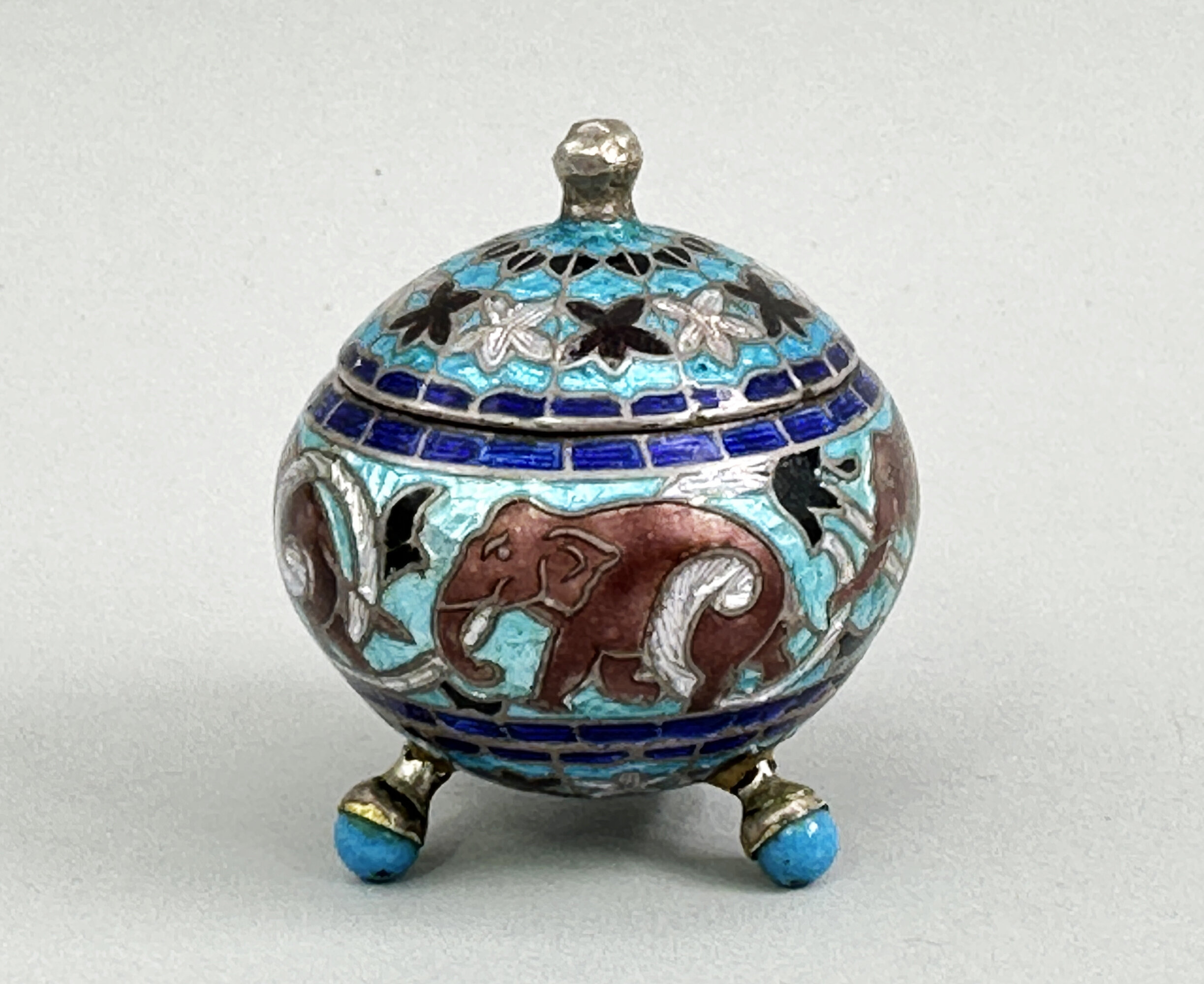
Indian Silver and Enamel pill or trinket Box, early C20th
Price: £55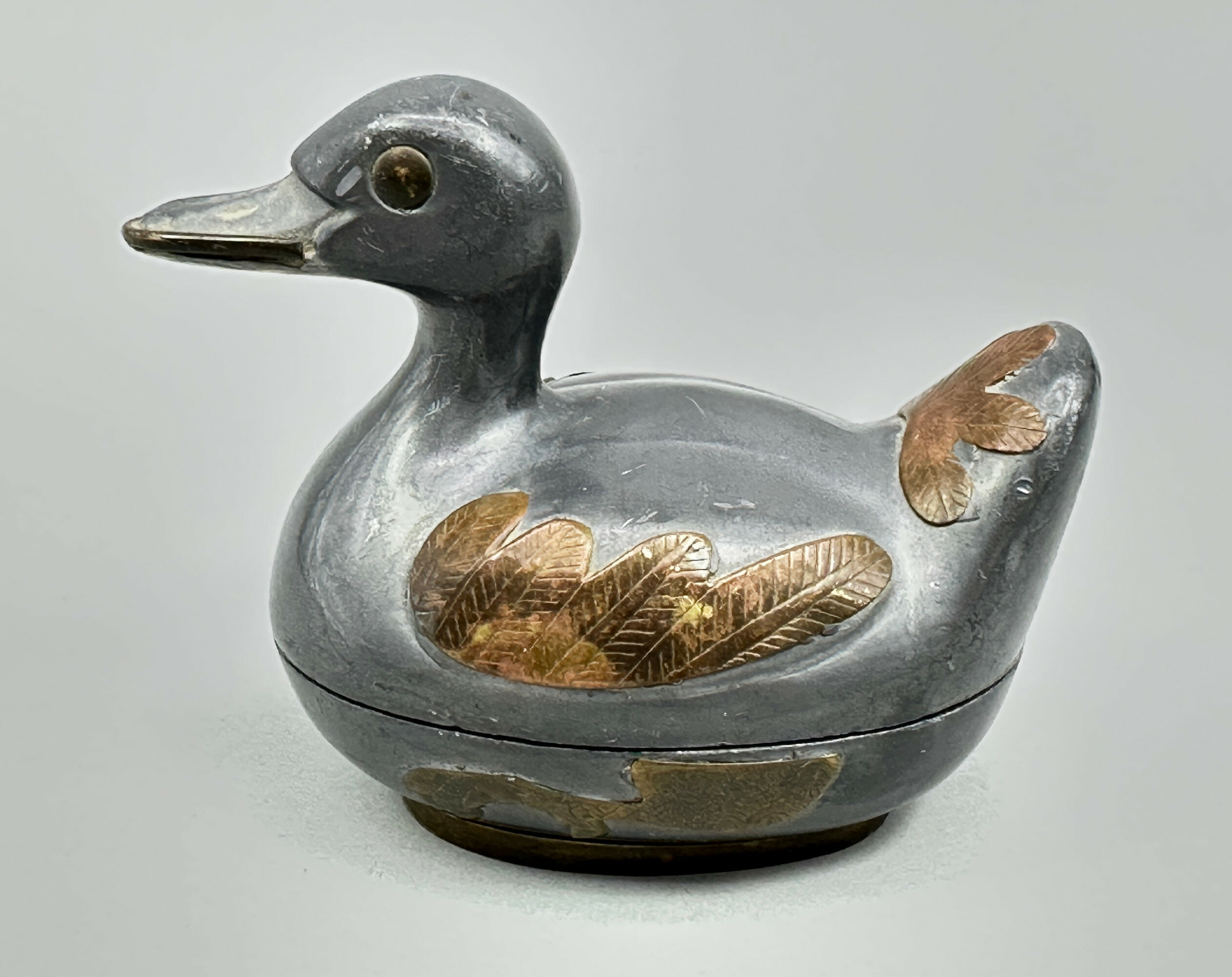
Pewter and brass box and cover in the form of a Mallard Duck, Gatco, Hong Kong, 1960s
Price: £25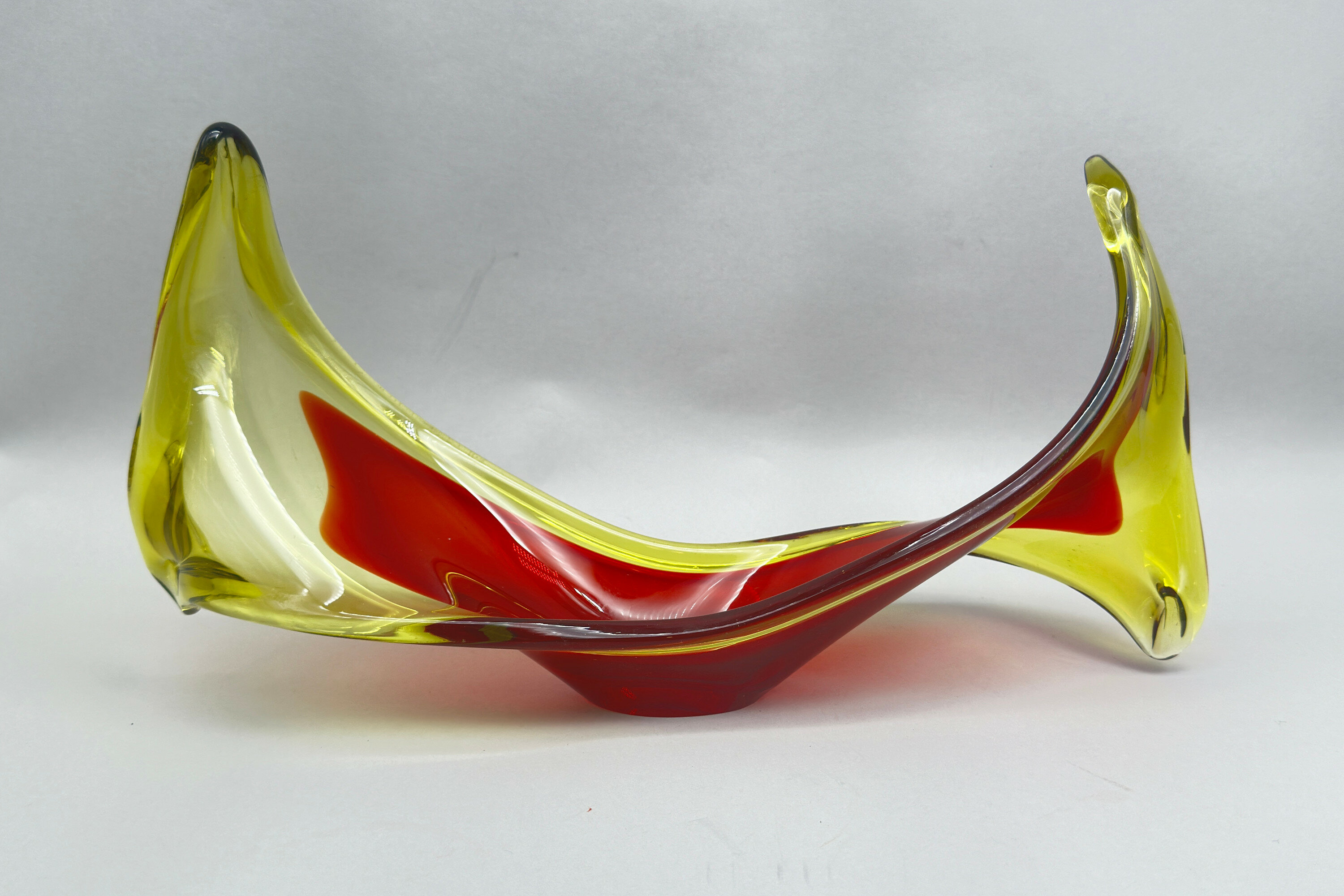
Viartec Murano Style Selenium Red & Orange Glass Sculptural Dish, Spanish 1950s/1960s
Price: £45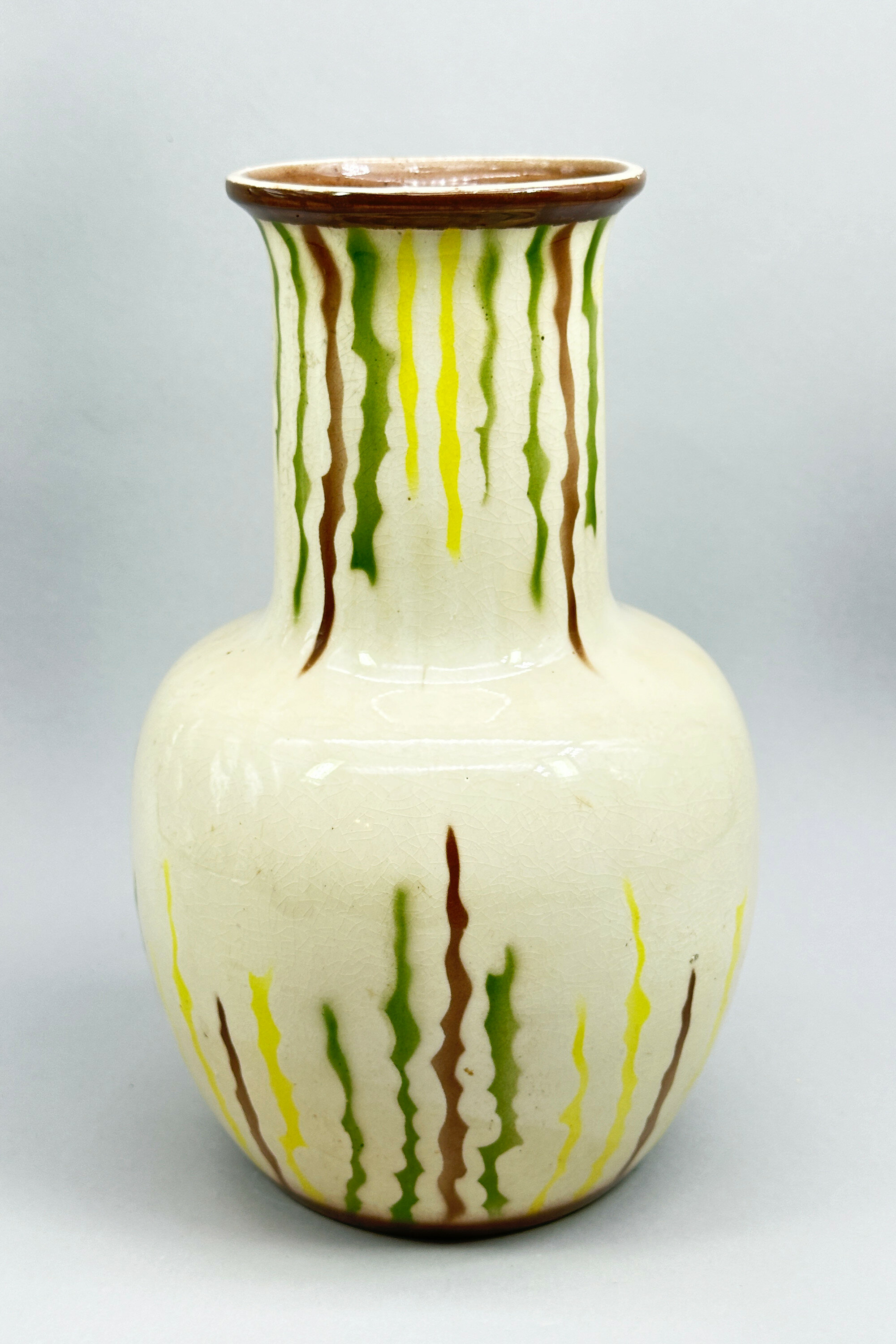
Art Deco style Vase signed E.Radford, mid C20th
Price: £75There were, in fact, two craftsmen working in the C20th British pottery industry with the name Edward Radford, father and son. Radford senior worked for Pilkington’s Royal Lancastrian Pottery in Manchester from 1903 until his retirement in 1936, acting as their main thrower. Radford junior joined his Father in 1905, but the First World War intervened, in which he won a Military Cross for his actions at Passchendaele in 1917 and afterwards he settled in Stoke on Trent, the heart of Britain’s pottery industry. An association developed with H.J.Wood’s Alexandra Pottery in Burslem who produced a range of wares bearing his name in the 1930s, although Radford himself may have acted as more a salesman than the designer. Production continued after the war and even after Radford’s retirement in 1948. The form of mark used here implies the later dating but may have been used earlier. The impressed figures indicate model number. Even if this vase is post war, the style is emphatically that of pre war Art Deco period with the simple lines of the form accompanied by semi abstract decoration vaguely reminiscent of Clarice Cliff combining to produce a piece of timeless attraction.
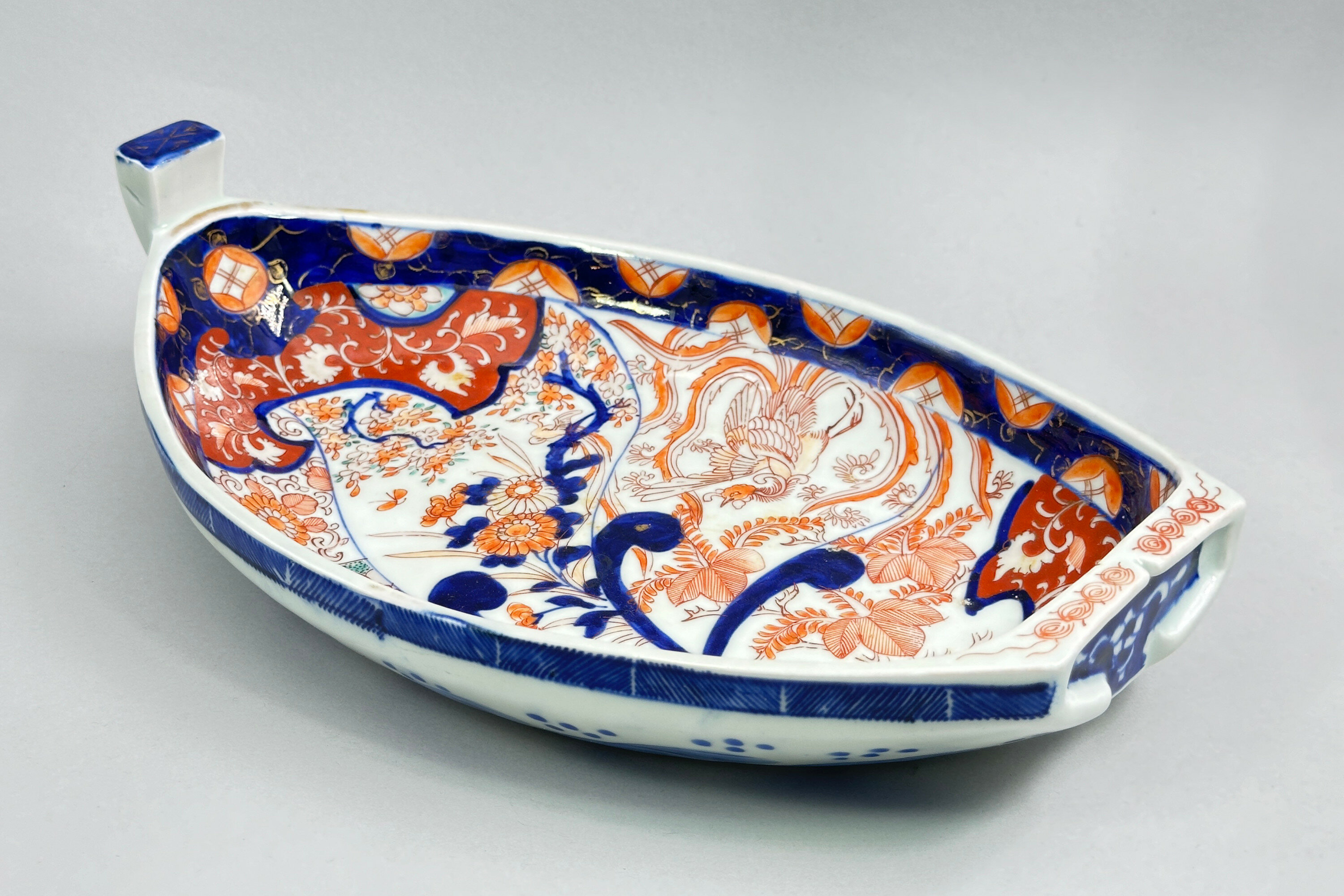
Japanese Imari Dish in the form of a Treasure Boat ‘Takarabune’, Meiji Period, circa 1900
Price: £250In Japanese folklore, the Takarabune or "Treasure Ship", is a mythical ship piloted through the heavens by the Seven Lucky Gods during the first three days of the New Year. Ceramic boat shape dishes were produced during the Meiji period (1868-1912) in both Arita and Imari porcelains. Paste of the foot rim and style of decoration suggest a circa date here towards the end of the nineteenth century.
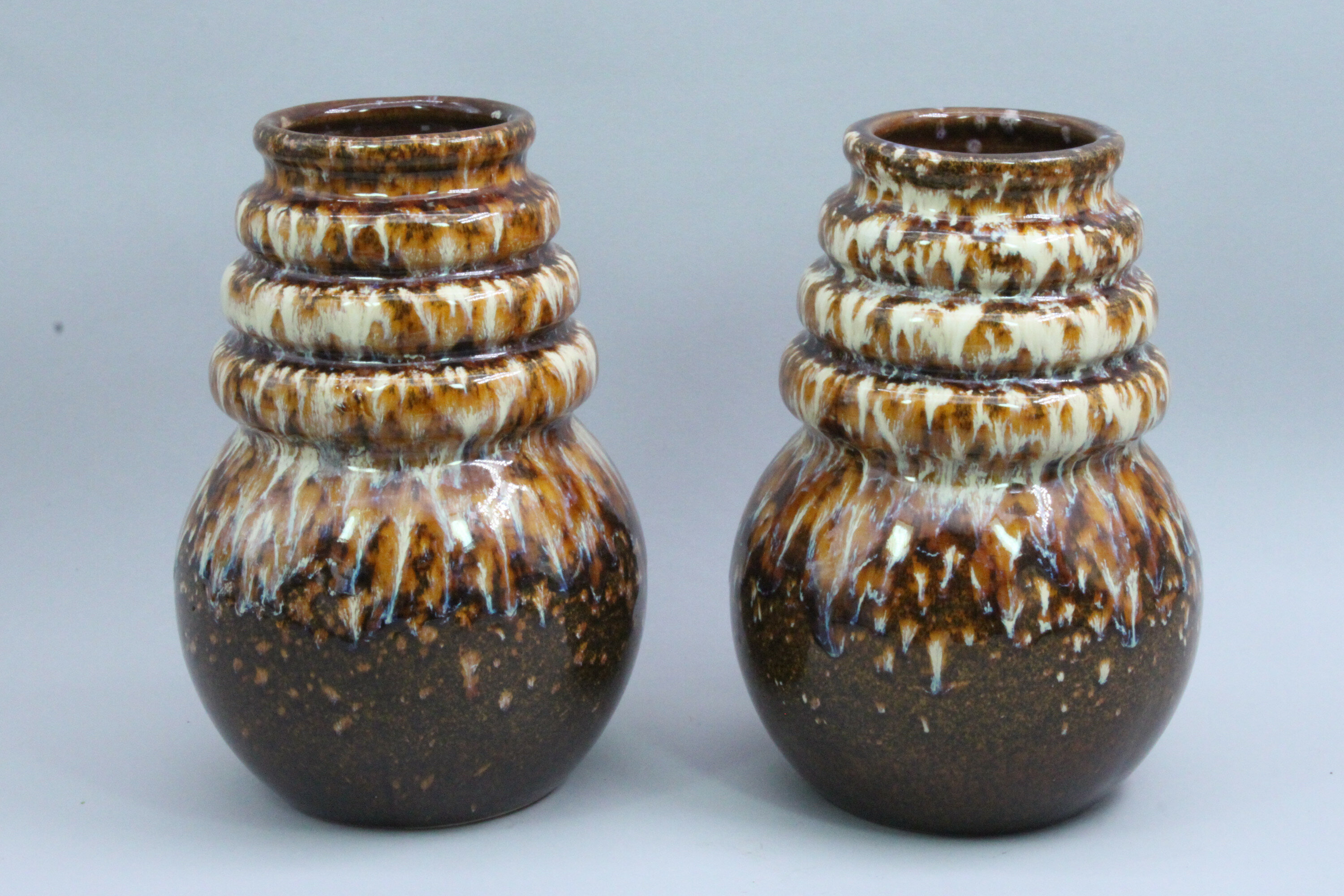
Pair of West German Scheurich Pottery ‘Wien’ Vases, model 269-18, mid 20th Century
Price: £45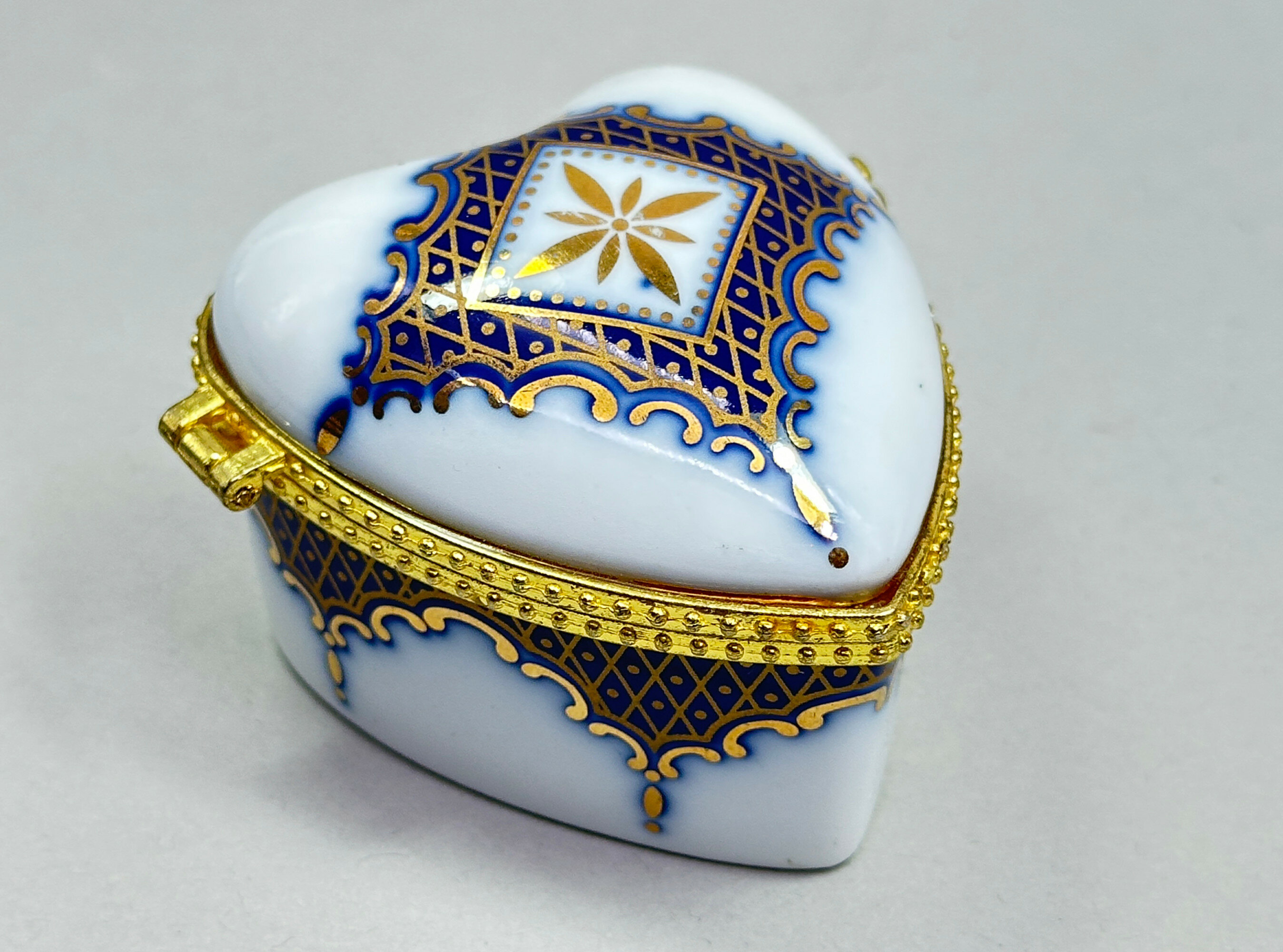
Oriental porcelain European Style Heart Shape Box and Cover, OC & CO, late C20th
Price: £15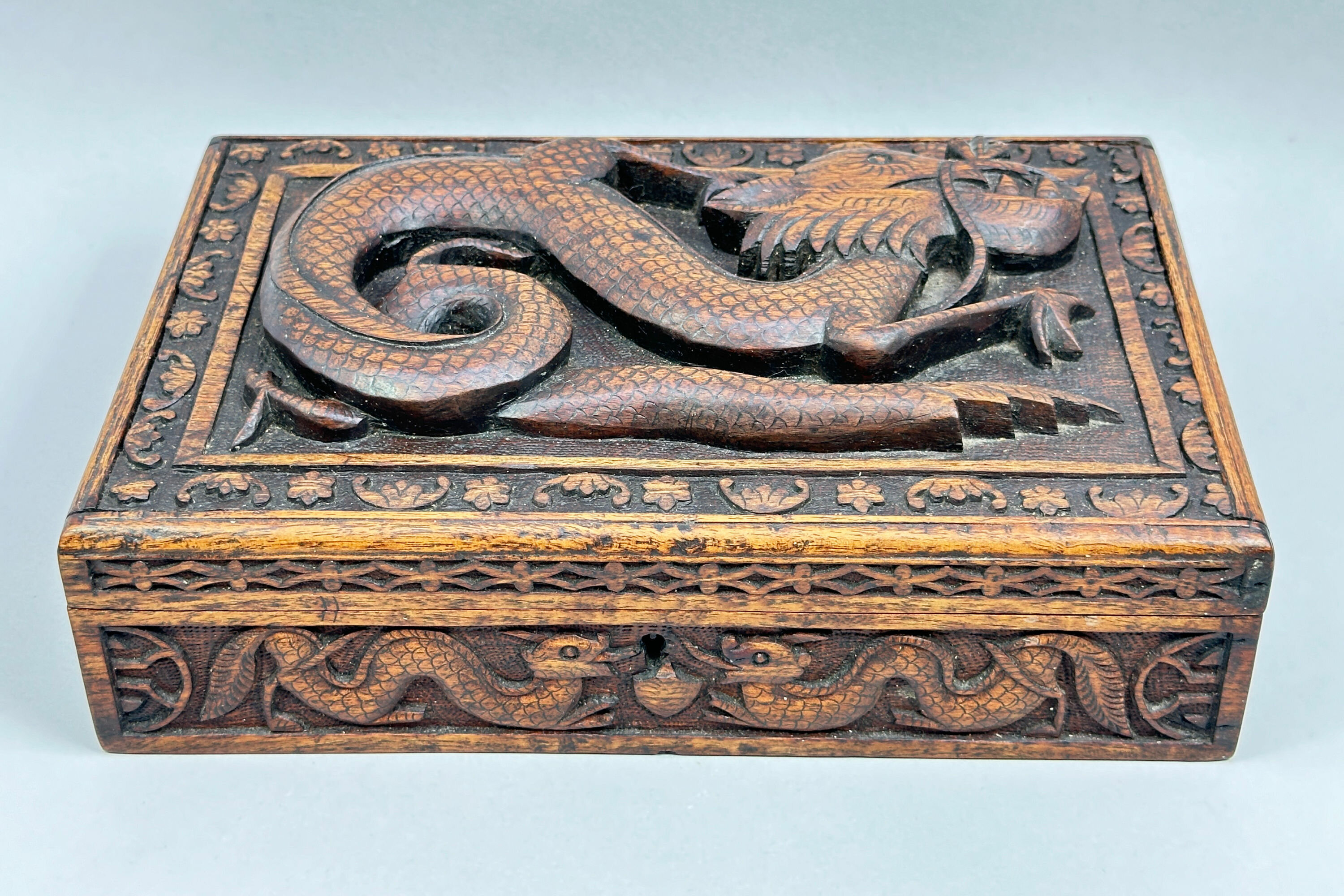
Chinese carved wood Box decorated Dragons, early C20th
Price: £150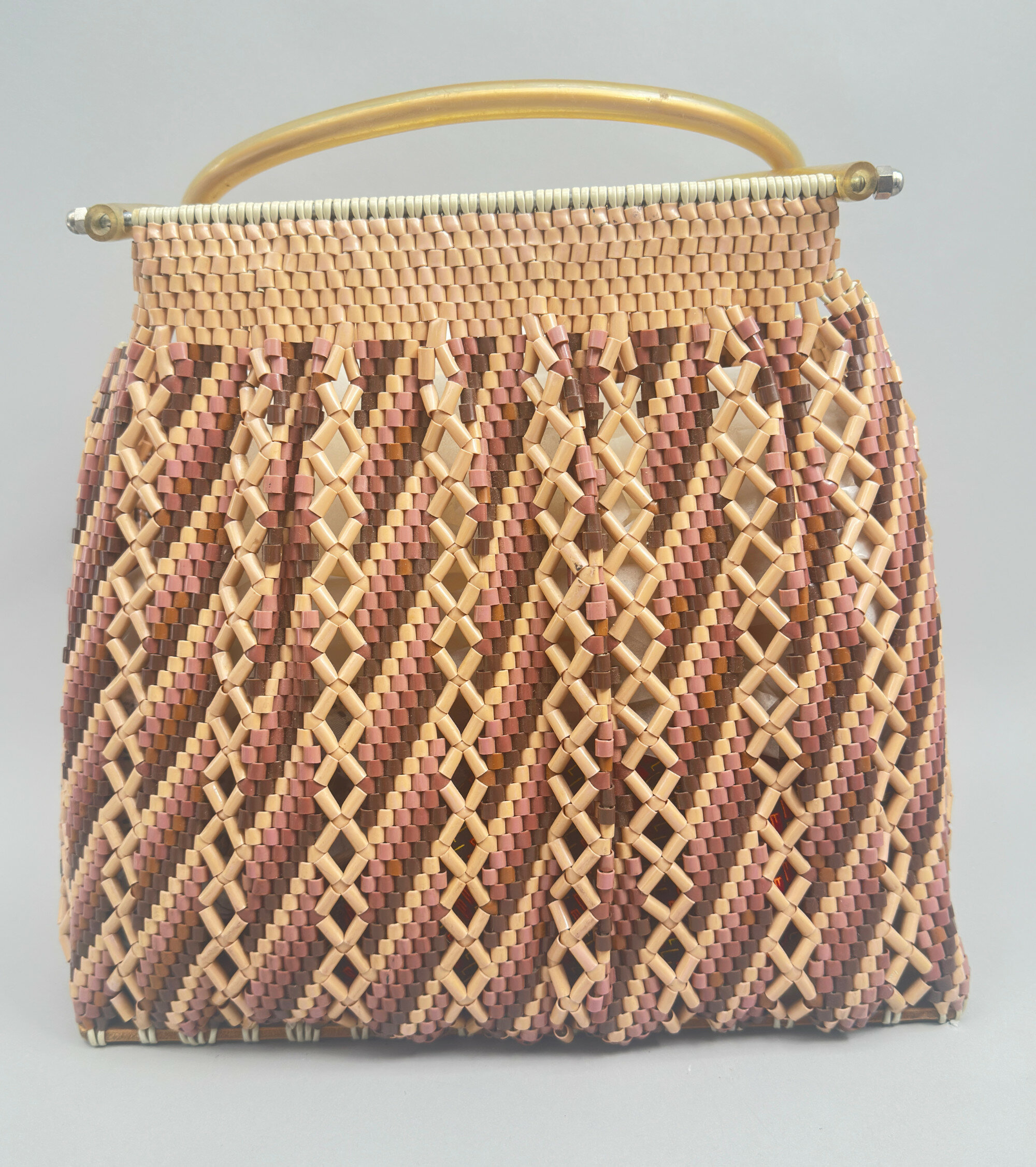
Sack form plastic beaded bag, English, 1950s
Price: £65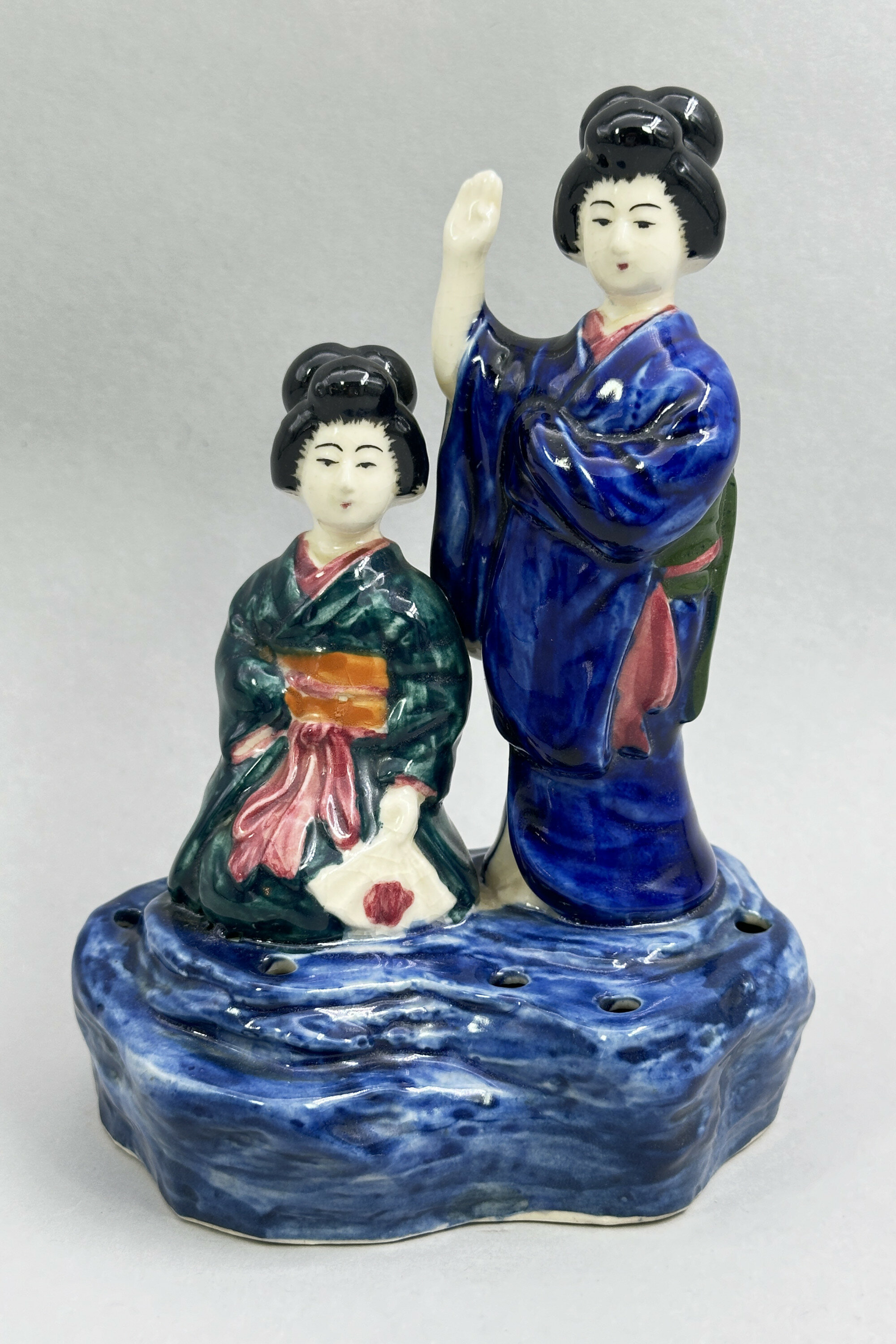
Japanese Ceramic Figural Group of two Geisha, late C19th
Price: £25
Studio Pottery Vase with flambé glaze, C20th
Price: £75
Pair of framed Watercolours, Dartmoor heather fields, signed C.A.James, early C20th
Price: £45
Edwardian Scottish agate panel bracelet
Price: £75
Very unusual banded carnelian panel bracelet
Price: £45
Chinese Straw Thread Picture on Silk, framed in original box, late C20th
Price: £45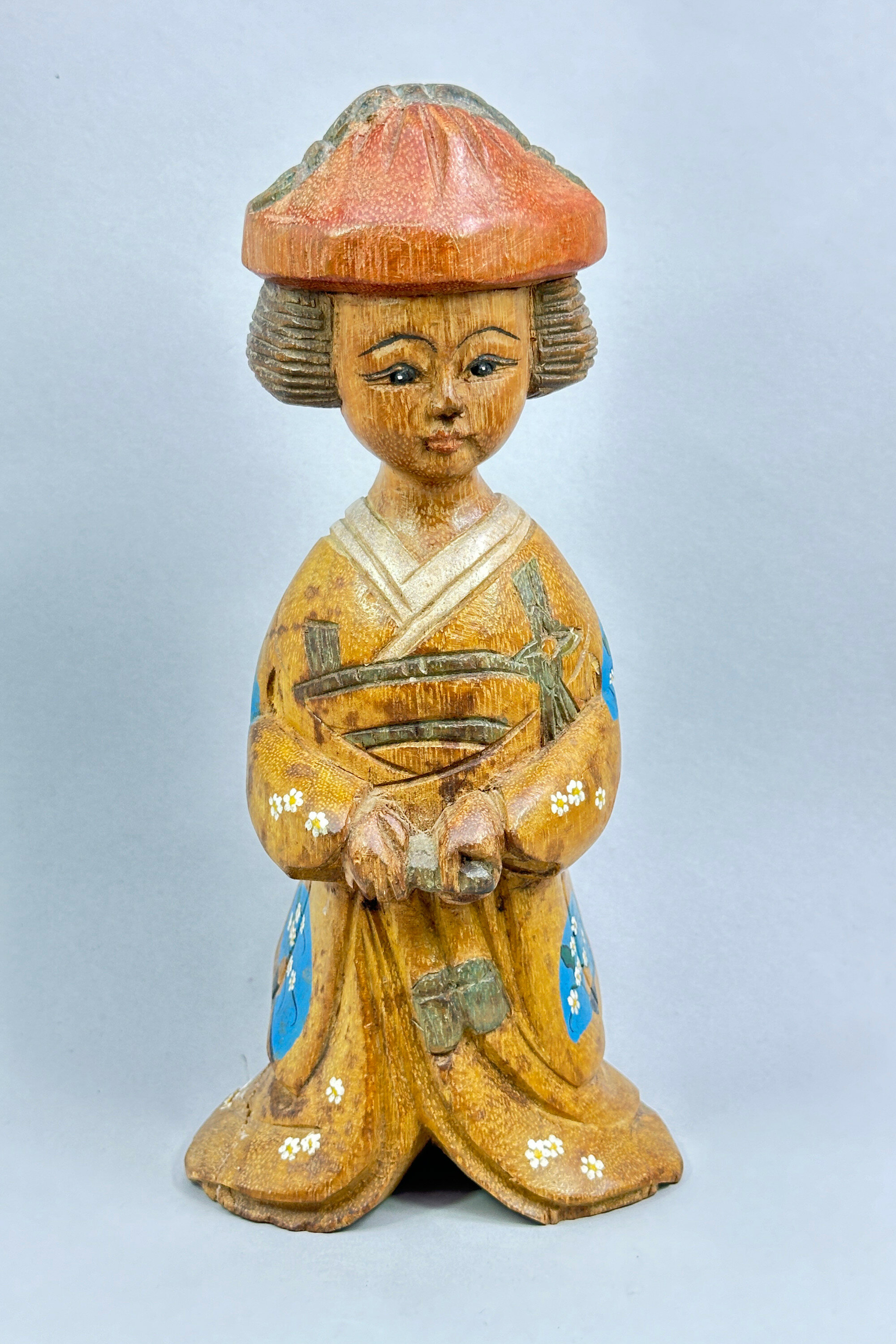
Japanese Carved Wood Figure of a Young girl, Kokeshi doll style, C20th
Price: £45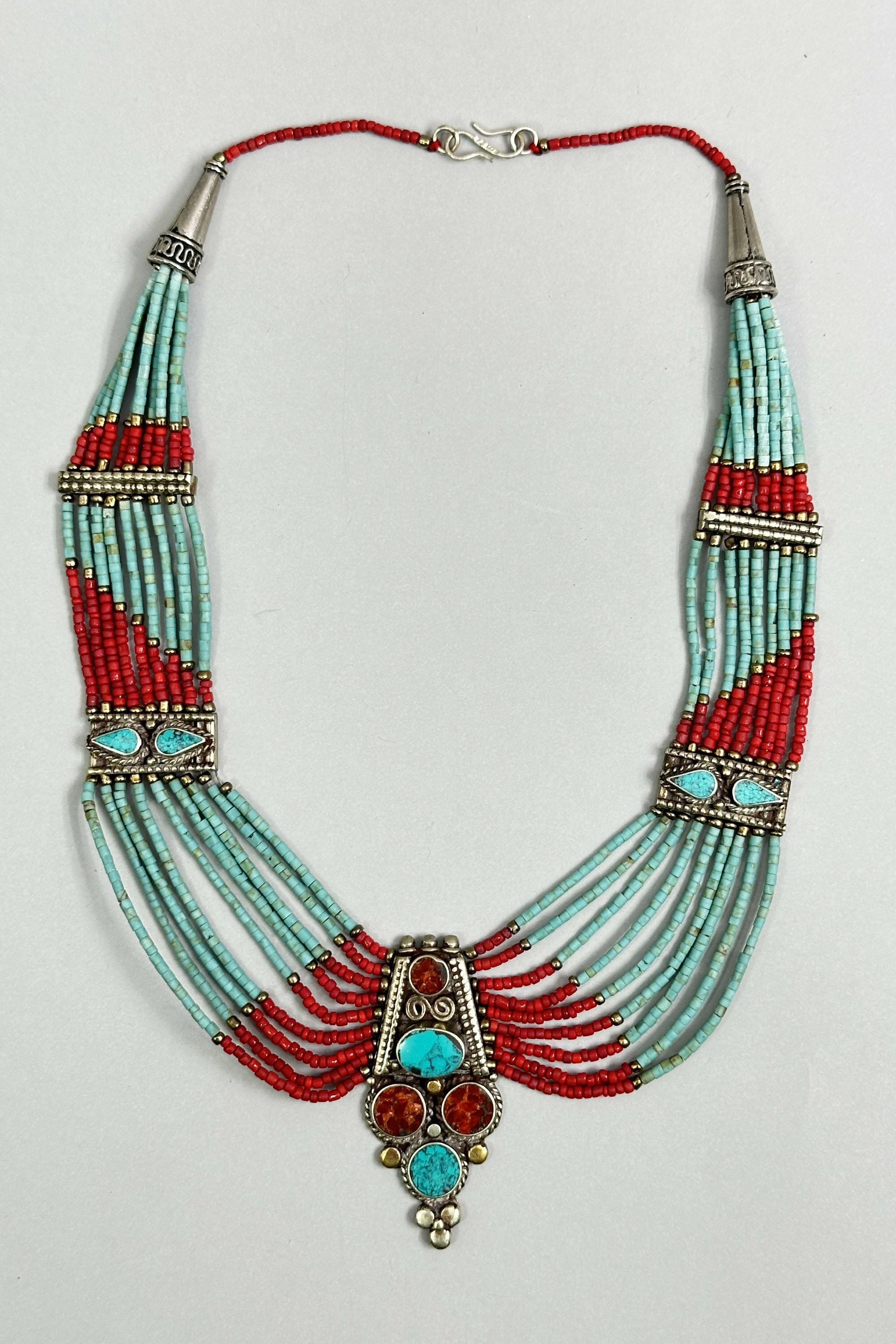
Very fine Berber North African necklace c1950
Price: £45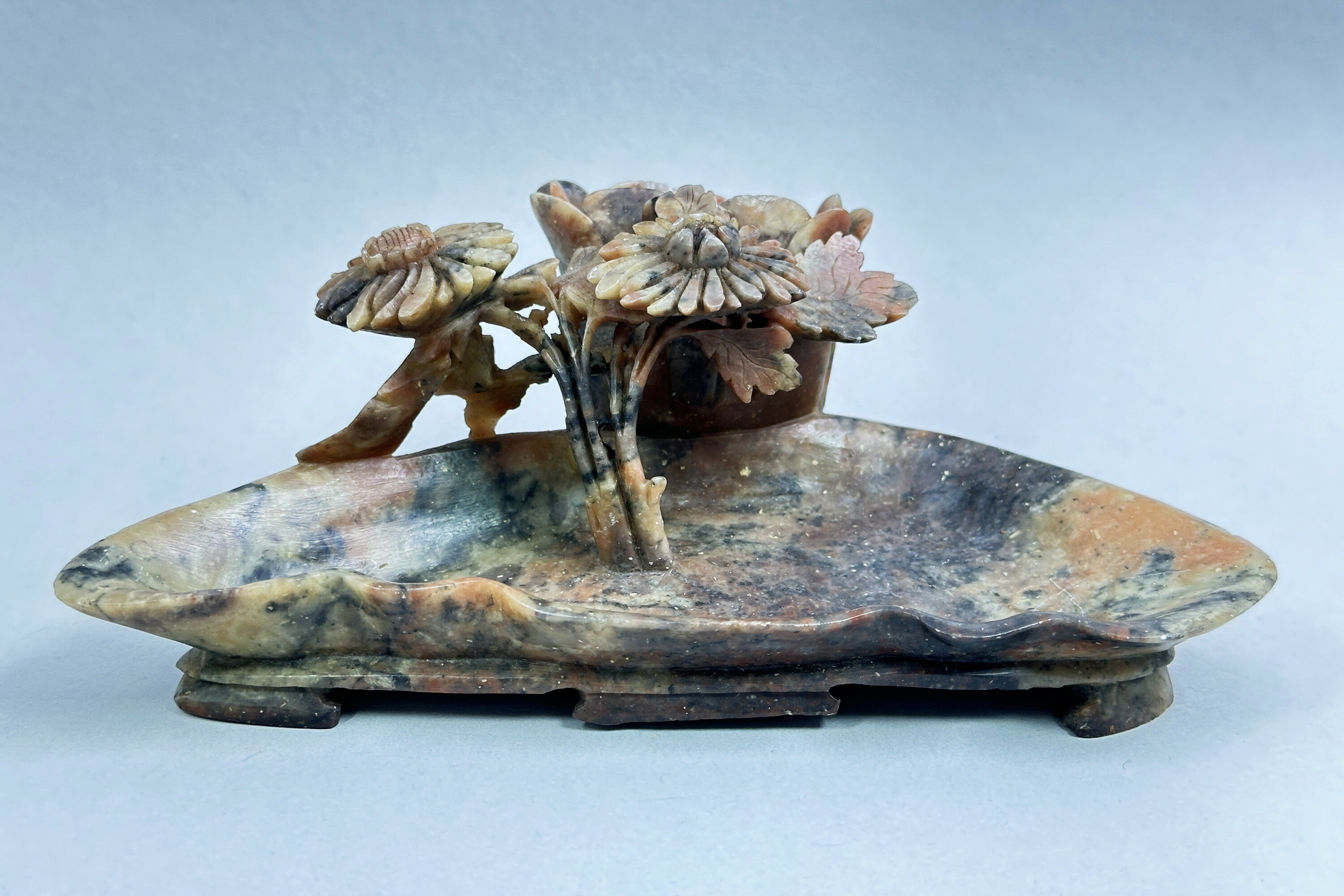
Chinese Soapstone Brushwasher with flowering lotus, early C20th
Price: £95
Chinese Bone Netsuke carving of a Sage, early C20th
Price: £45
Art Deco glass bead necklace
Price: £20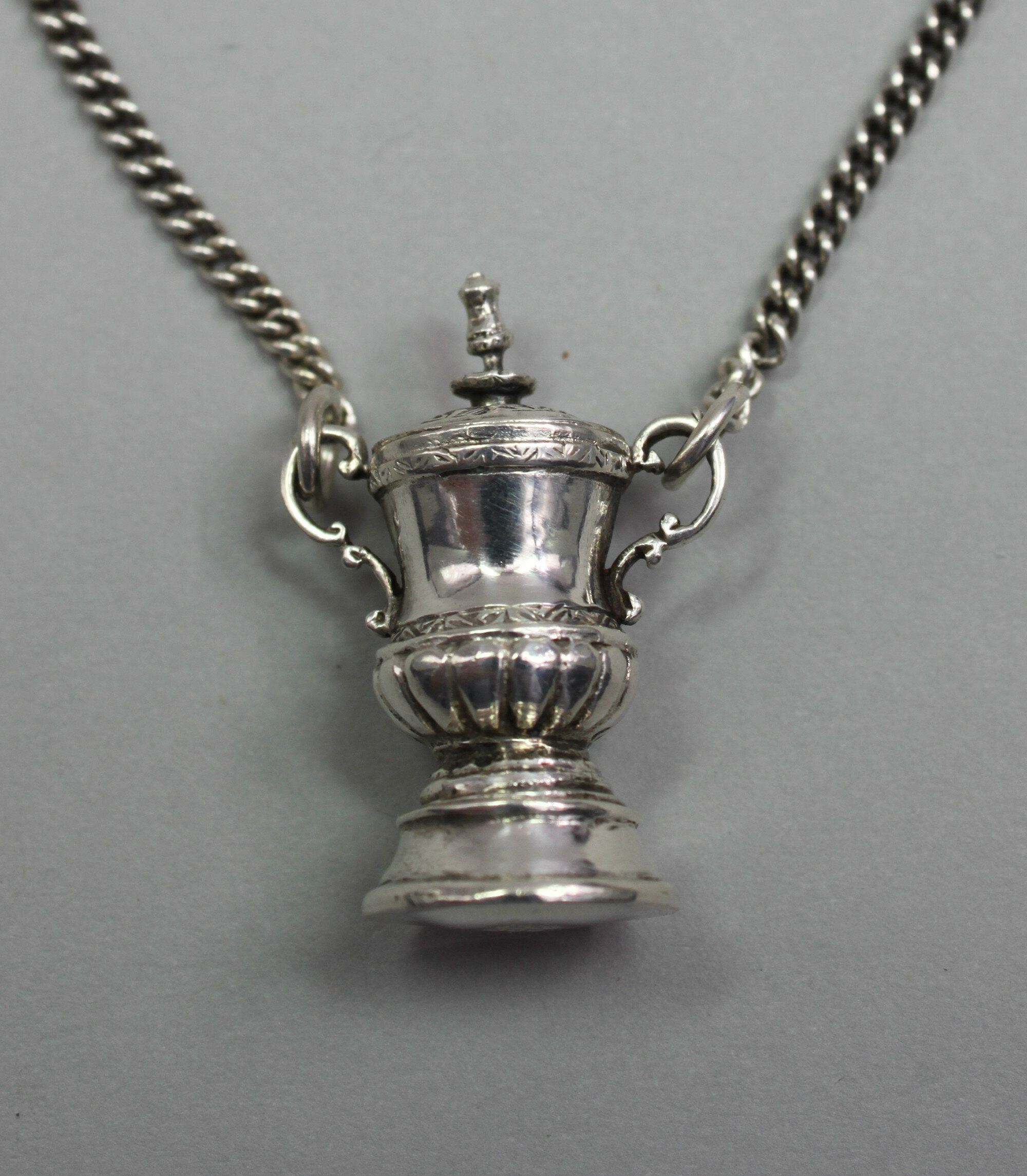
Necklace with FA cup pendant, Alexander Clark Co. 1976
Price: £85
Victorian Grand Tour Wedding Cake glass necklace
Price: £125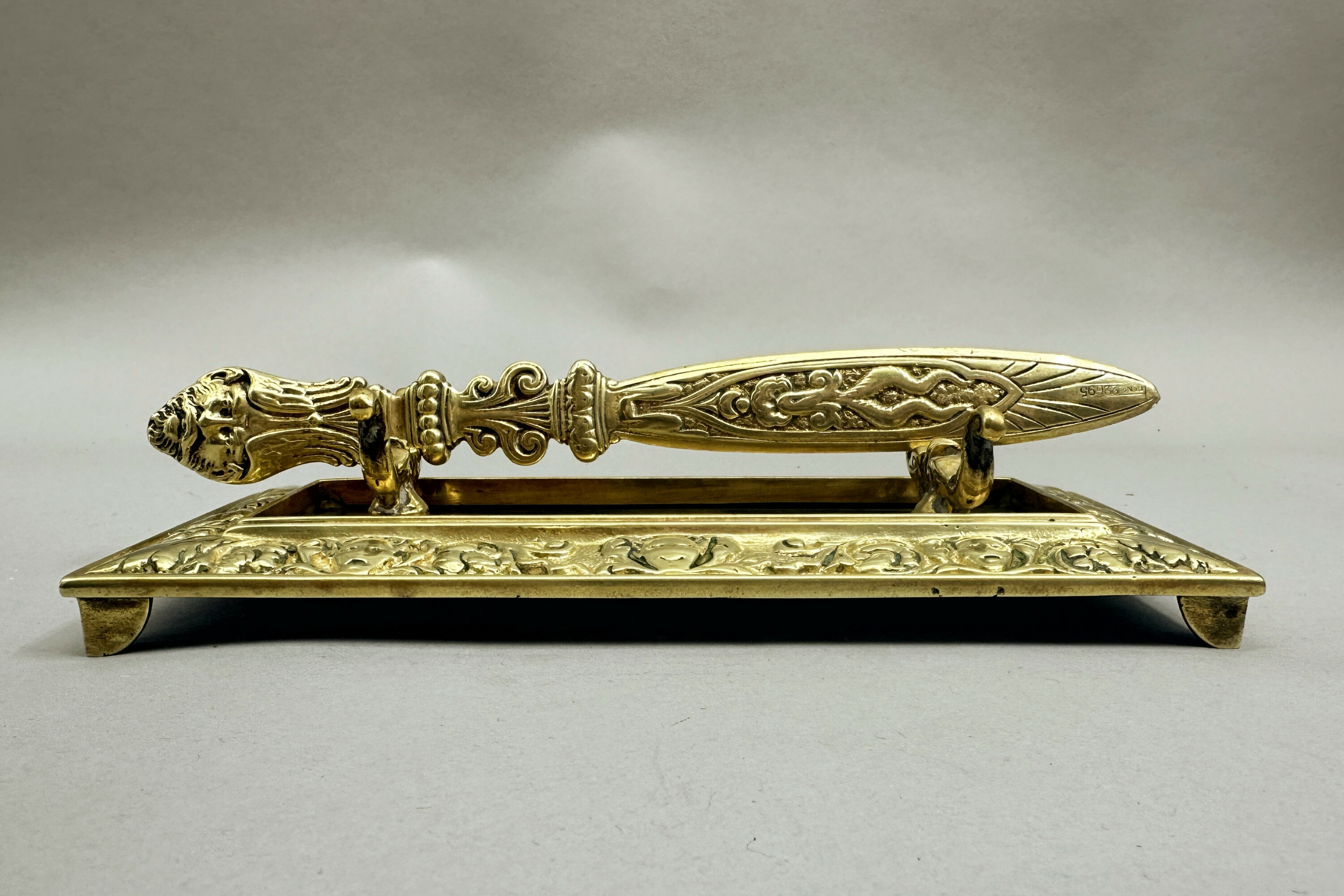
Renaissance Revival Letter Opener and Stand, English, c1900
Price: £25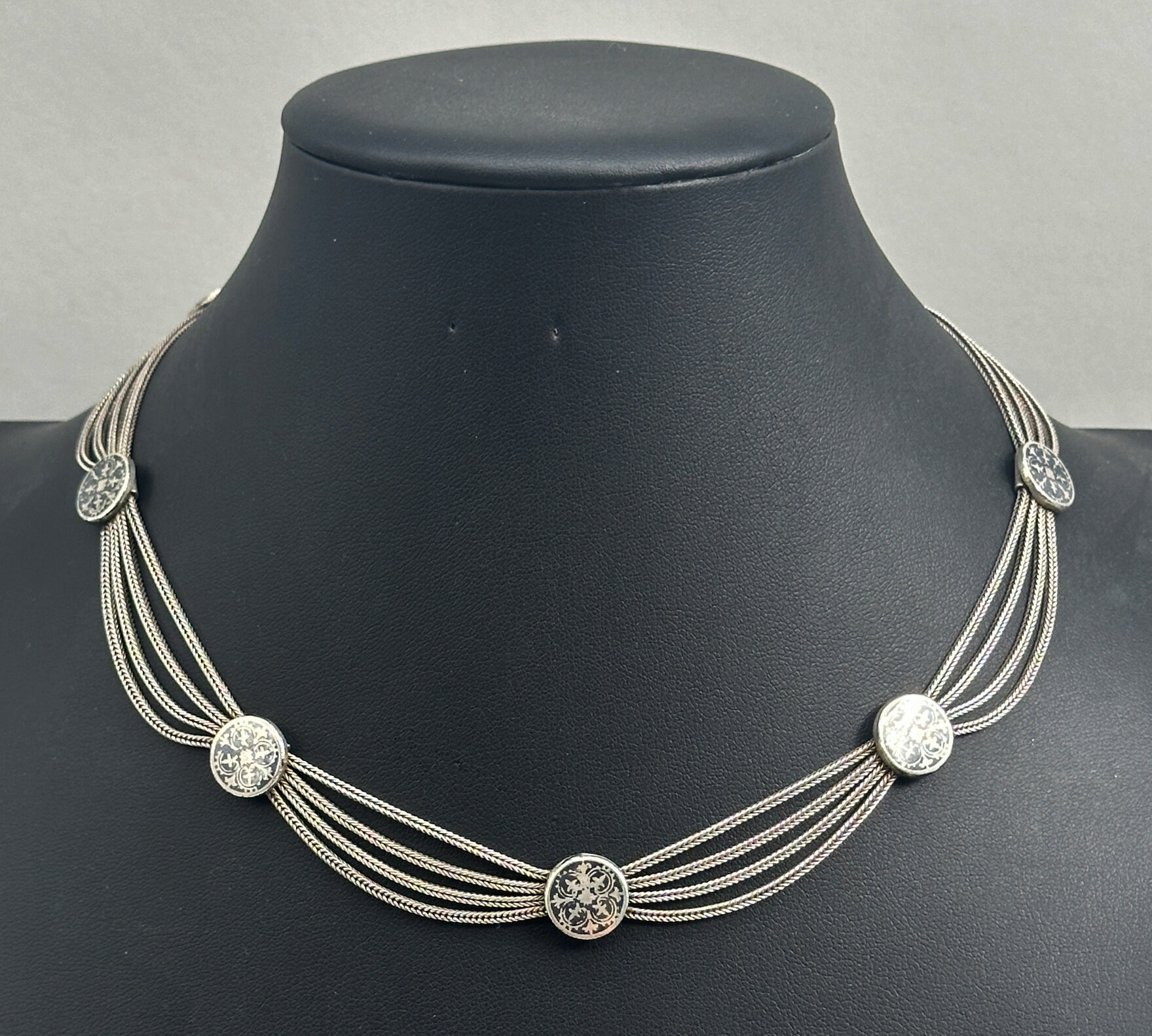
Islamic Silver Necklace with Niello work plaques, c1930
Price: £75The technique used is that of ‘niello’ work. (The word derives either from the classical Latin word ‘nigellum’ or the later mediaeval words ‘nigello’ or ‘neelo’.) Niello is a black mixture, usually of sulphur, copper, silver, and lead and used as an inlay on engraved or etched metal, especially silver. Added as a paste, it hardens to a black colour after firing and is then polished. Here it is the ground that formed from niello while the design shows though in silver, a less common version.
There is much skill in the craftsmanship here and the result is a piece of classic and timeless simplicity.

Taxco collar necklace by Rubi Ramirez c1950
Price: £350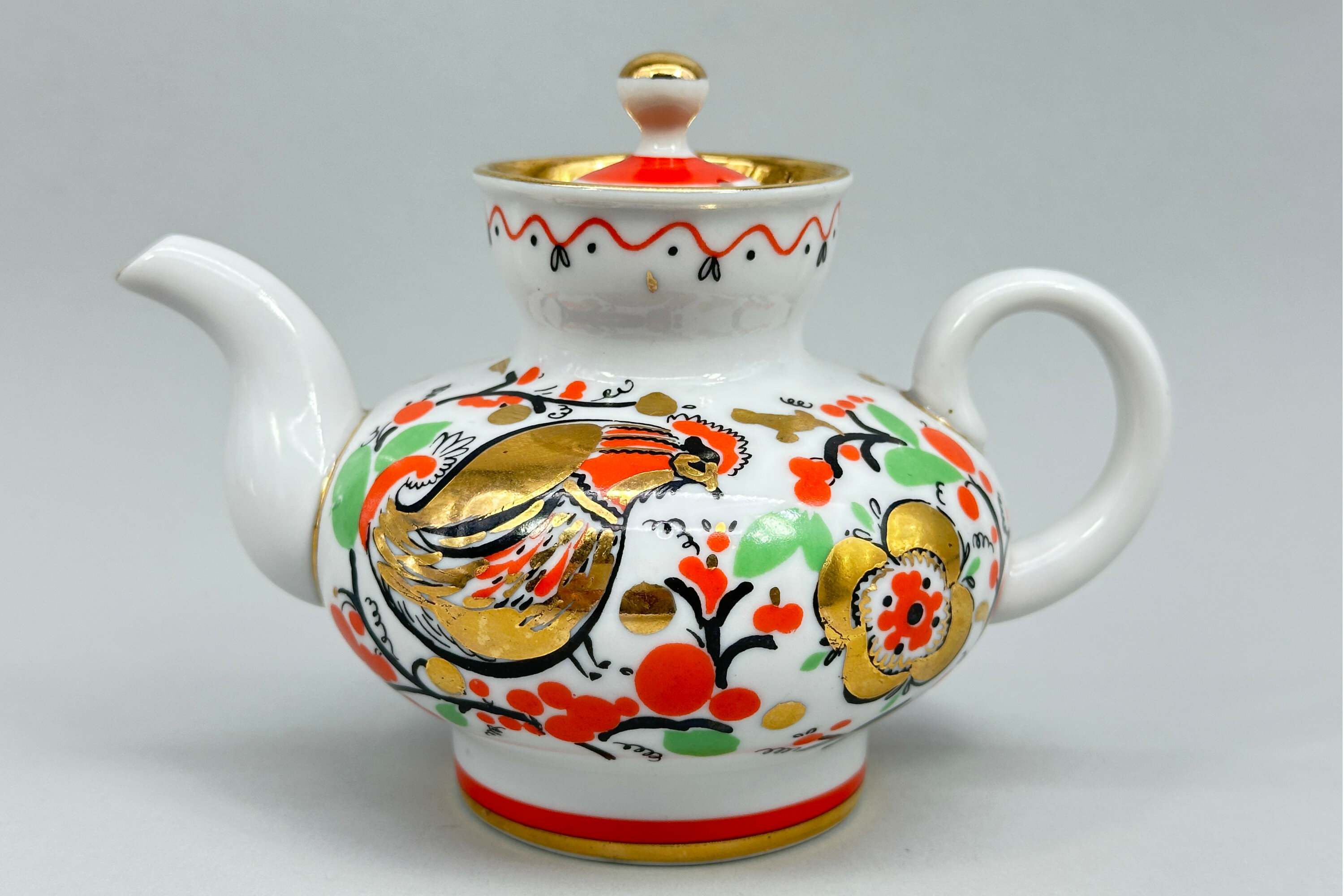
Lomonosov Teapot decorated Cockerels, late C20th
Price: £45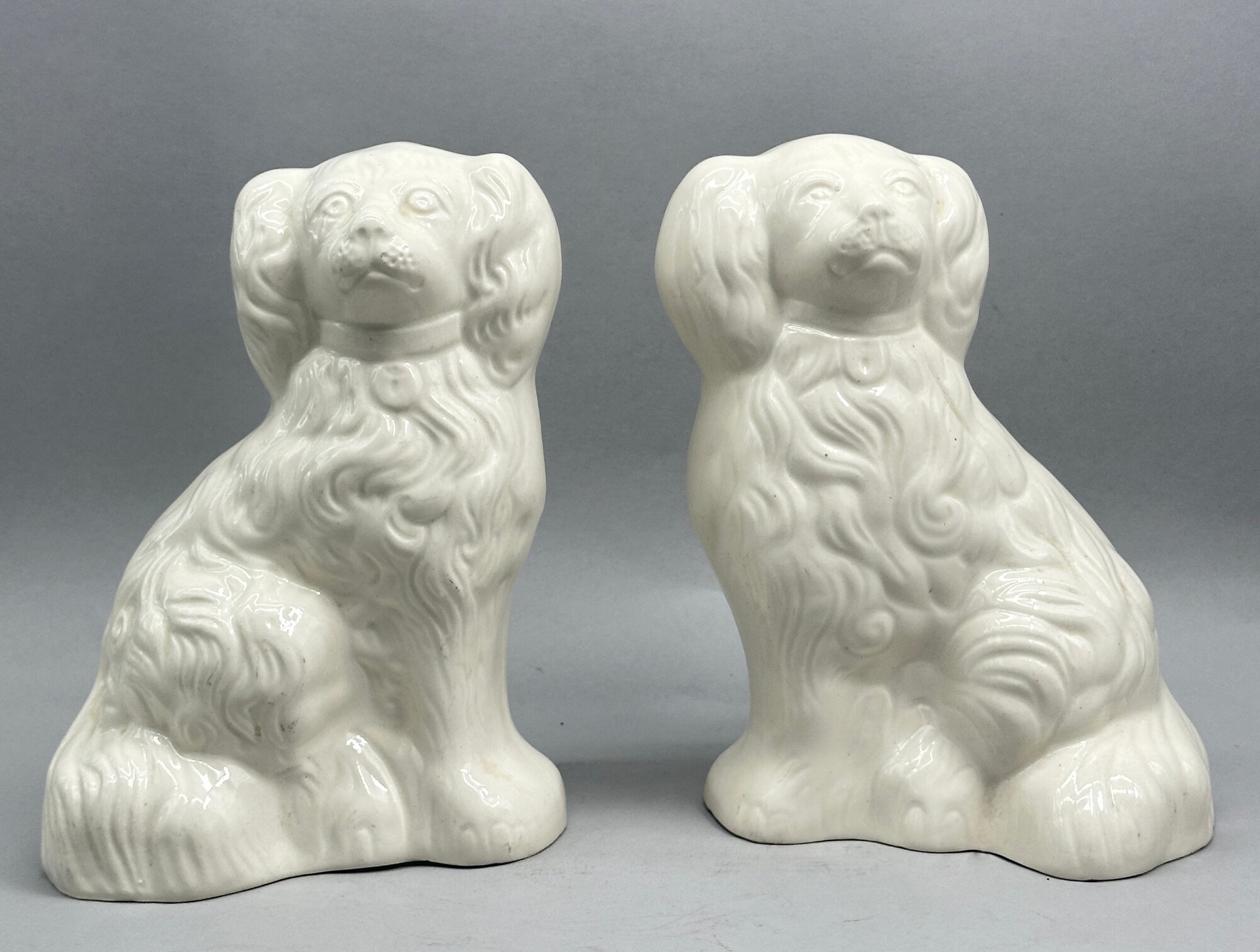
An unusual pair of white glaze models of Spaniels, Beswick, 1960s
Price: £75While a close relation to the traditional Victorian ‘Staffordshire Dog’, these figures were actually made by the English firm Beswick in the twentieth century. Founded in 1894 by James Beswick and his sons, the company became known for its output of figurines, eventually securing the rights to producing characters from the novels of Beatrix Potter and the films of Walt Disney. It was sold to Royal Doulton in 1969 who continued production until 2002, selling the pottery premises in 2003 and the rights to the name in 2004 when they were bought by Dartington Crystal who still manufacture pieces carrying the Beswick name. These spaniel figures appear to date from the 1960s and were made in at least two sizes. Most have painted decoration but the plain white finish here is really the most pleasing of all producing a pair of decorative items with timeless appeal.
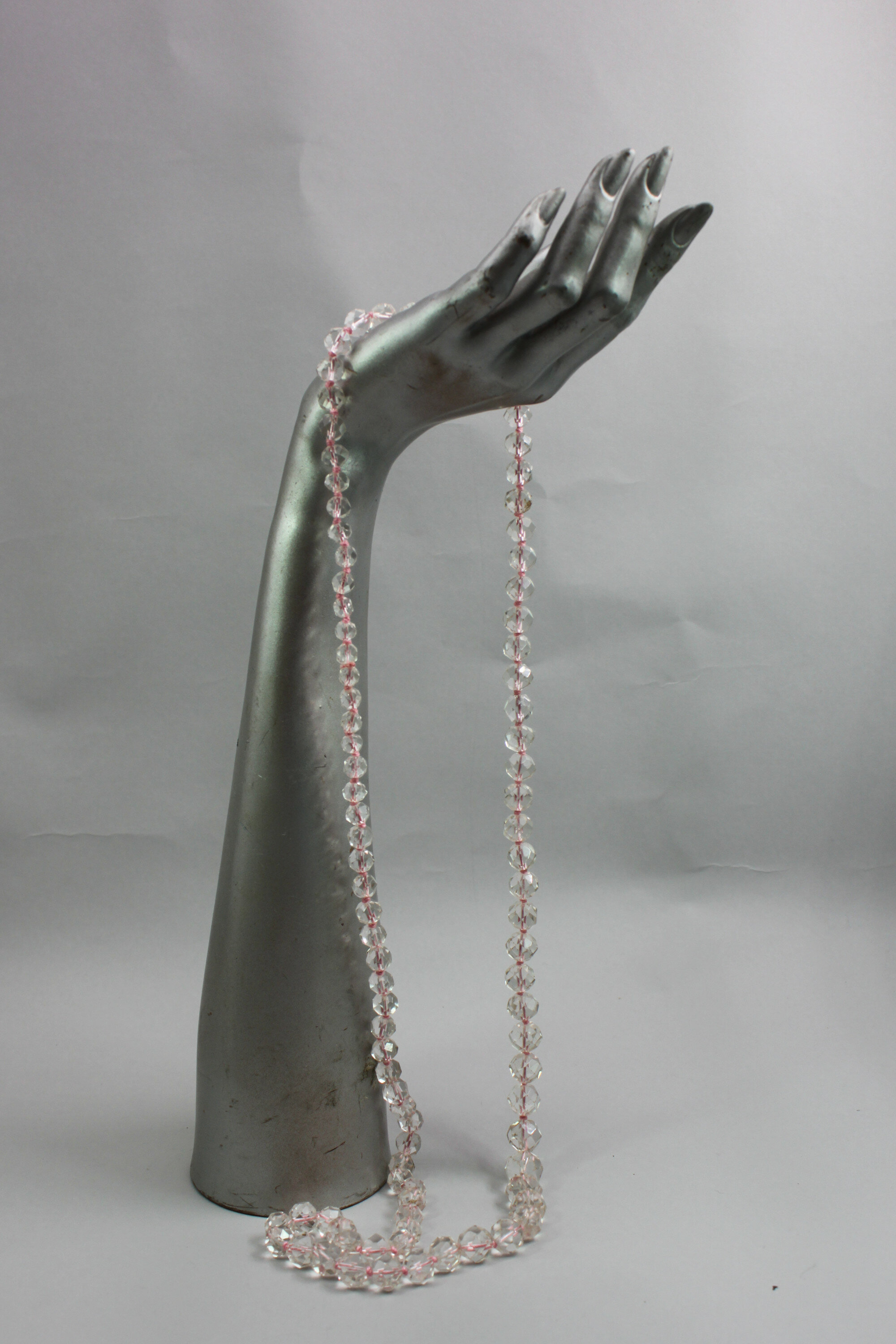
Stunning opera length string of rock crystal beads
Price: £35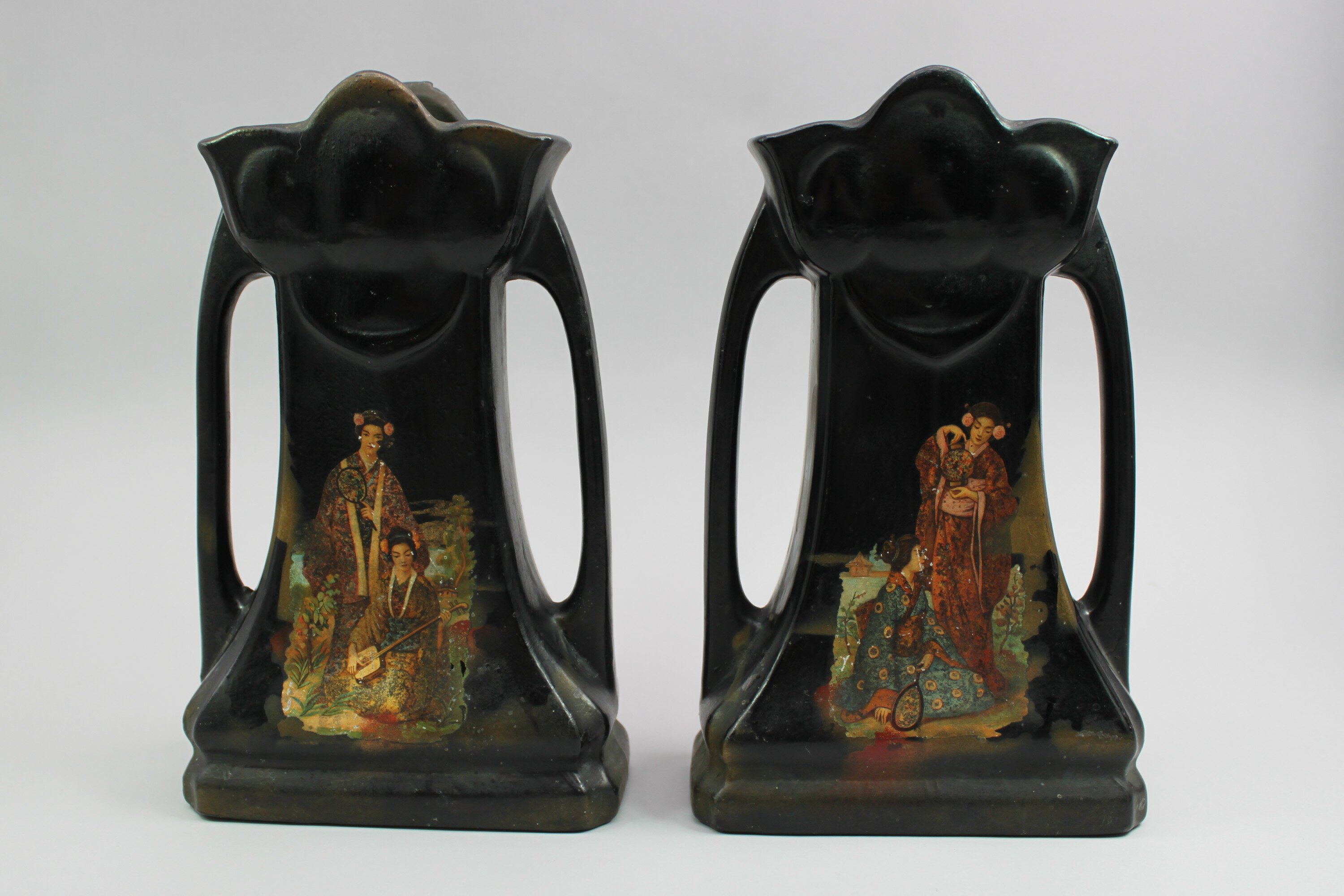
Pair of Art Nouveau Style Ceramic Vases decorated in the Japonaiserie Style, 1930s
Price: £45While Art Nouveau in form and decoration (Japanese inspired designs were very much a feature of the style), these vases probably date to the 1930s when Staffordshire potteries were producing affordable items for interior decoration in a range of imitation styles. There are no direct parallels for the mark on these vases but the type of ware here is very similar to pieces made by the 'Brentleigh' factory, Stoke on Trent, in the 1930s and a similar date and area of manufacture is the most likely.

Three Chinese Canton Enamel Dishes, Nineteenth Century
Price: £45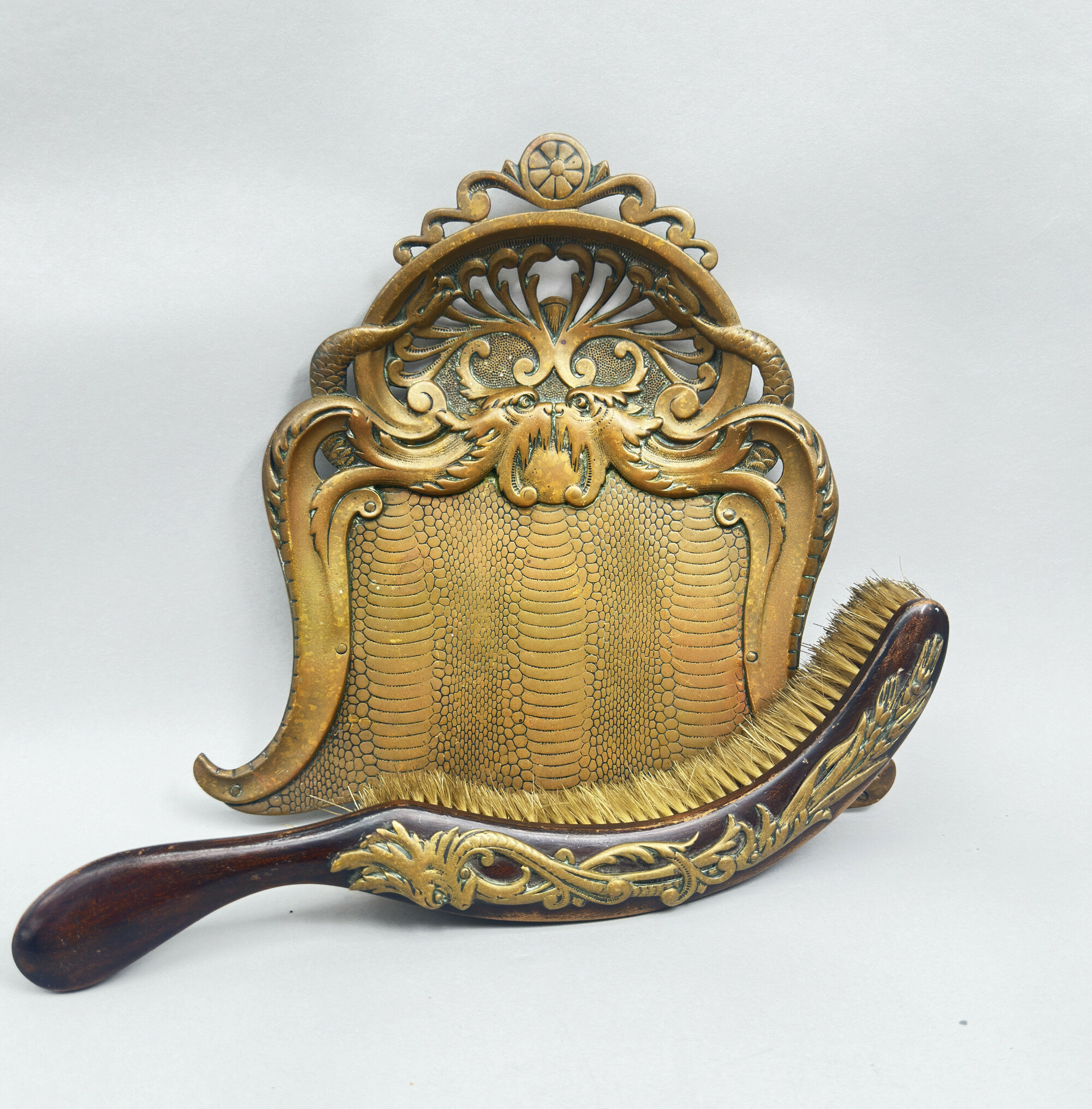
Townshend & Co : Butler’s Crumb Tray and Matching Brush, Birmingham c1900
Price: £75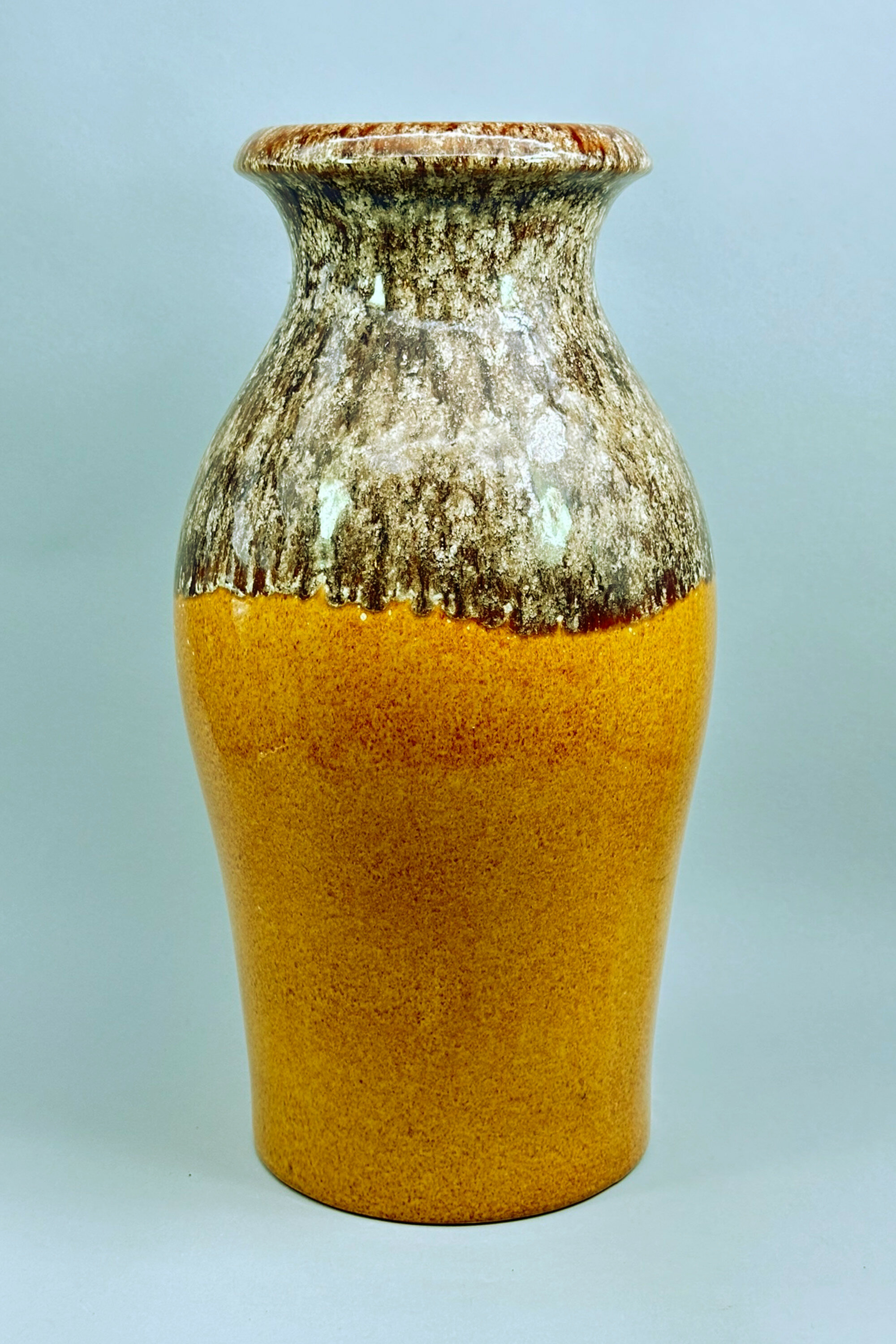
West German ceramic Vase, Scheurich, No 290-40, 1960s
Price: £55Although not marked as such, this vase has all the hallmarks of the firm Scheurich Keramik which started production in 1954, rather later than most of its competitors, but soon became the largest producer of commercial art pottery in Germany. Their pieces rarely carried the factory name but usually the model number followed by the height in centimetres with ‘W.Germany’ below, as here. Scheurich were well known for producing a wide variety of pieces with variegated, almost experimental glazes and this vase is yet another successful example of their work, the simple lines of form combining with a more austere selection of glaze effects than found in some of their other pieces. Dating is to the 1960s.

